Prices have been brought up to date, and are for stamps in 'average' condition. The currency is now selectable, the default is British Currency (£). I have revised Hiscocks' original listing, though leaving references to the original designations. Setup |
Steve Hiscocks wrote:
"This company, founded in 1846, was the first of all the British telegraph companies and developed an extensive network of inland lines with
connections to continental Europe. Stamped prepaid forms were introduced in 1851 and are occasionally met with but these are beyond the scope of this
catalogue. Various dates have been quoted for the adhesive stamps but those given below derive from the records of the printers, Perkins, Bacon &
Co. Ltd. and are probably correct. The first issue (Nos. 1—21) were all derived from the same plate by altering the wording (distance or value)
below the words "FRANKED MESSAGE" by hand. There are thus 16 varieties of each stamp (the number of stamps in a sheet) except in the single
case indicated. When the company was purchased by the Postmaster-General in 1869 all plates and stamps in stock were destroyed so remainders
are not common."
My Note:
The International Telegraph Company was formed in 1853. The two companies merged in 1855, to become The Electric & International Telegraph Company.
| Shortcuts to different sections | ||||||||||||
| Message Paper | 1854 by distance | 1855 with values | 1860 perforated | 1860-4 RG/JSF | 1864-70 RG/HW | 1861-70 Continental | 1857-70 Directors | 1875 Samples | Cancels | Message Forms | Tariffs | Stationery |
Though beyond the scope of Steve Hiscocks' catalogue, I think these are worth listing.
Individually numbered, single sheets of thin, coloured wove paper about 7¼ x 9 inches (18.4 x 22.9 cm).
They are watermarked with the name of the company in double-lined Roman capitals. Printer unknown, but L&H suggest 'probably Waterlow & Sons'.
Philbrick & Westoby (1881) on page a 319 dagger comment say they have ascertained that the sheets were not made by either Perkins, Bacon and Co., or Waterlow & Sons.
Their later stamps were printed on paper made by T. H. SAUNDERS, so perhaps these were also, though with a custom watermark.
It is thought that these forms were first used to pay for messages at the London Exhibition in Hyde Park from May to October 1851.
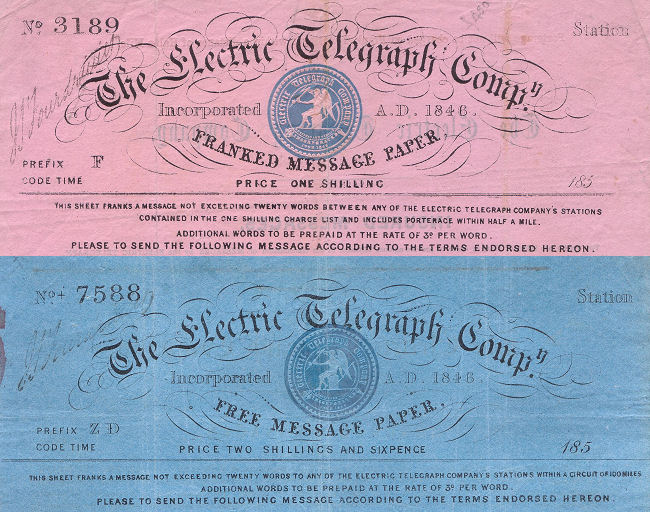
These set a pattern of including a number, the secretaries signature, terms & conditions and a standard of one shilling for many years to come.
Notice that the 1/- one is marked 'FRANKED', as are all the other values I have seen except 2/6d (bottom) one which is marked 'FREE'.
E. D. Bacon mentions another 2/6d Message Form (Control 2824) but makes no mention of it being different. Images courtesy of Steve Lawrie
Note on these, the signature at top-left is J S FOURDRINIER, containing three 'R's. Since Raymond Lister (1961) it appears to have been consistently miss-spelled as FOUDRINIER.
Larger sized images of both sides of these complete forms are shown at the bottom, now additionally with fronts of the other values.
Later (in 1853) there were price changes with the 1/- replaced by 1/6d, 2/6d replaced by 2/-, 5/- replaced by the 3/- and 4/-. These had the control on the right preceded by 'A' and a blank 'Prefix'.
| RH # | Hisc. | Franked / Free | Authentication. | Message Form Description (1851?) | Prefix | Controls known | Prices - GB £ |
|---|---|---|---|---|---|---|---|
| RHF1 | - | Franked | J S Fourdrinier | 1/- Black and light-blue on pink within 50 miles. (Serial No. on left) | F | 3189 | 2100 |
| RHF1a | - | Franked | J S Fourdrinier | 1/- (1852?) Black and light-blue on pink within 50 miles. (Serial No. on right) | F | 29930 | 900 cancelled |
| RHF1b | - | Franked | JLR / JSF | 1/- (1853?) Black and light-blue on pink within 50 miles. (Serial No. on right) | F | 38323 | - |
| RHF2 | - | Franked | JLR / JSF | 1/6d (1855) Black and dark-blue on pink within 50 miles. | - | A5449, A5451 | 900 |
| RHF3 | - | Franked | JLR / JSF | 2/- (1855) Black and dark-blue on green over 50 miles but within 100 miles. | - | A7048 | 900 |
| RHF4 | - | Free | J S Fourdrinier | 2/6d Black and light-blue on blue over 50 miles but within 100 miles. | ZD | +7588, +7666 | 1250 |
| *RHF4a | - | Franked | JLR / JSF | 2/6d (1852?) Black and light-blue on blue over 50 miles but within 100 miles. | ZD | 2824 | - |
| RHF5 | - | Franked | JLR / JSF | 3/- (1855) Black and dark-blue on blue over 100 miles but within 150 miles. | - | A2331 | 900 |
| RHF6 | - | Franked | JLR / JSF | 4/- (1855) Black and blue on white over 150 miles. | - | A5890 | 900 |
| RHF7 | - | Franked | J S Fourdrinier | 5/- Black and blue on white, over 100 miles. | F | 18415 | 1700 |
* RHF4a - See also L & H page 3. This was the first 2/6d to be reported in philatelic literature, however for the 1/-, the message forms authenticated by J S Fourdrinier alone have the
lowest control numbers. I do not have an image of this, but the description (1927 page 6) by the discoverer in the Record Room of the G.P.O., E. D. Bacon, which does
not specify the Authentication, does not note any difference between it and the 1/- item, control 38323, except that it
"has printed at the top in red ink in a straight line: 'This 2s. 6d. Message Paper can only be used for distances within a circuit of 100 miles.'",
so rightly or wrongly, though it is different to RHF4, it has been assumed that it says 'Franked' and was authenticated by 'JLR / JSF', though I have my doubts about both.
Does anyone have an image of it ?
E. D. Bacon illustrates RHF1b and describes it with "An illustration of the One Shilling value, in reduced size", with no credit for the image, and later mentions
"that in the Royal Collection is printed on the wrong side of the paper and has the control-number 38,323; the other, which was in the collection of the late Dr. A. Legrand,
passed into the Ferrari collection. The control-number on this is 29,930. The latter form has the word 'Cancelled' written across it in pen-and-ink."
I take that to imply that his image of 38323 (RHF1b) pre-dates the acquisition by the Royal Collection, unless there was a mix-up with the numbers.
It also implies that he thought that RHF1a and RHF1b were the same, which undermines the assumptions regarding RHF4a.
You can click on the reference numbers on the left to jump to the image/s.
Philbrick & Westoby (1881) say ".. appear to have been lithographed by means of a transfer from an engraved plate."
Initially just the distances were given. According to Langmead & Huggins, the construction of these plates by Perkins, Bacon
is described by E. D. Bacon in The British Philatelist, Vol. 19, numbers 11 & 12 (Jan/Feb 1927). They were in sheets of 16 stamps (4 x 4).
According to Raymond Lister (1961), These were on thick wove paper with thick, brownish gum and watermarked with open-faced capitals of the paper-maker's name T. H. SAUNDERS.
Due to the large size of these, most are illustrated at 150dpi, rather than my usual 300 dpi.
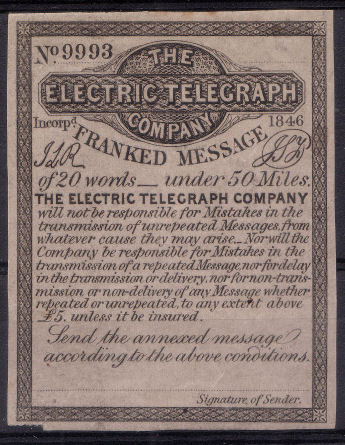 |
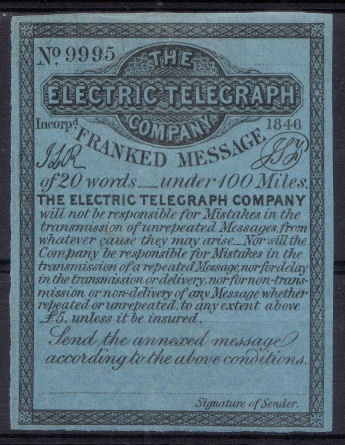 |
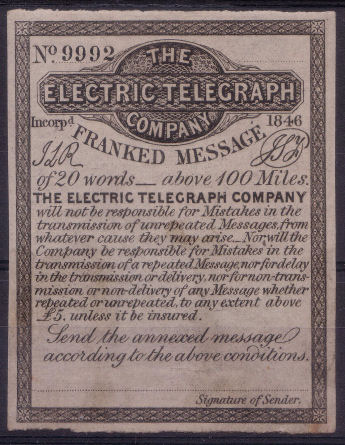 |
| Hiscocks H1 black on rose. 9993 | Hiscocks H2 black on blue. 9995 | Hiscocks H3 black on white. 9992 |
| Images courtesy of Steve Lawrie - (half-size, click image for a larger version). | ||
| RH # | Hisc. | First series Description | Rarity | Mint | Used |
|---|---|---|---|---|---|
| RH1 | H1 | 20 words under 50 miles, black on pink (1s, controls 1-10000). | R4 | 1200.00 | - |
| RH1a | ' ' ' No control number. | 800.00 | - | ||
| RH2 | H2 | 20 words under 100 miles, black on blue (2s6d, controls 1-10000). | R4 | 1000.00 | - |
| RH2a | ' ' ' No control number. | 800.00 | - | ||
| RH3 | H3 | 20 words above 100 miles, black on white (5s, controls 1-10000). | R4 | 1000.00 | - |
| RH3a | ' ' ' No control number. | 800.00 | - |
Apparently, the RH3 plate of 16 impressions was created first, and the other two by altering the distance wording on
each of the 16 impressions individually, creating 16 slightly different types each of RH1 and RH2.
Here are some more examples, all with very similar control numbers. According to Langmead & Huggins, all known controls are in the range 9780 to 10000.
Something interesting is going on with the control number here:
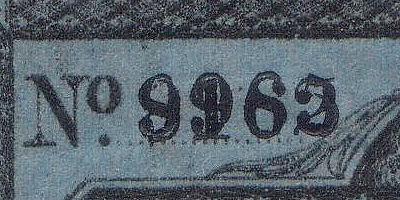
Can you make it out ? I think 8165 was changed to 9962. Control numbers of stamps used were required to be recorded by the clerks.
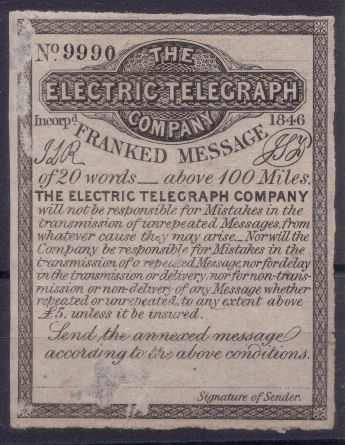 |
 |
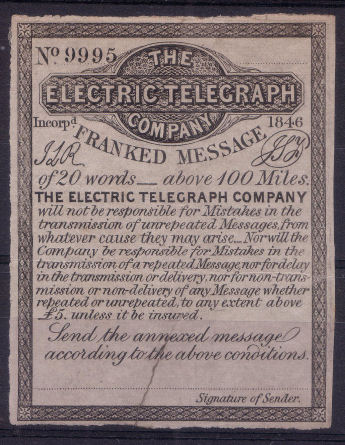 |
| Hiscocks H3 black on white. 9990 | Hiscocks H3 black on white. 9992 (repeated from above) | Hiscocks H3 black on white. 9995 |
| Images courtesy of Steve Lawrie - click image for a larger version. | ||
A plate proof of H3. Click image for a larger version.
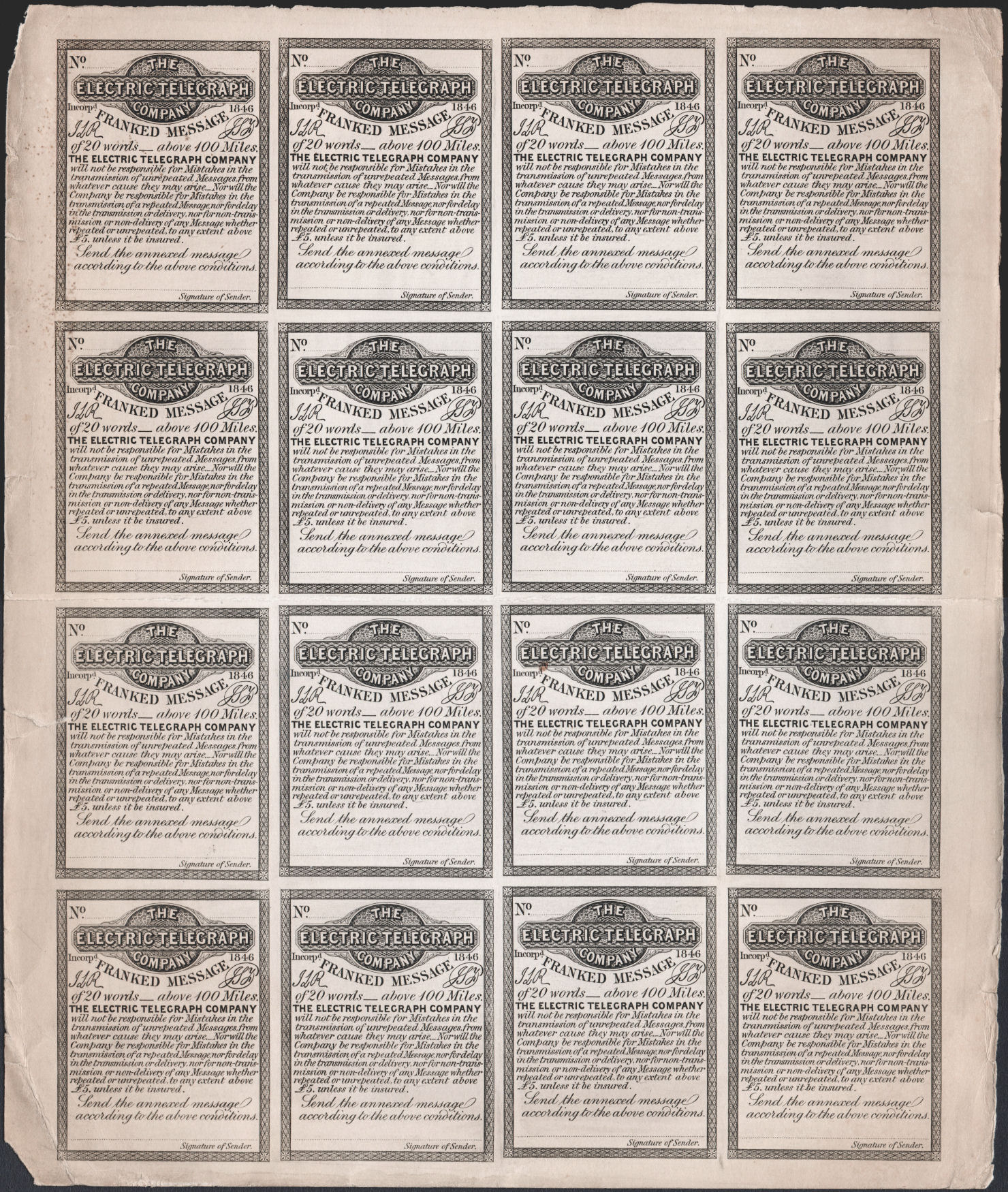
Langmead and Huggins say that two plate proof sheets of these are known, one of which is quartered.
I suspect they did not know about this one courtesy of Steve Lawrie.
Because of the size and mounting, some problems were experienced scanning this. It was done in two scans that were then joined.
Some parts are also slightly out of focus. Click on the image to get it full-size in another window.
It has to be said, that the affects of toning etc. over the years sometimes make paper colours difficult to judge.
Also, these are said to have thick, brownish gum, so that probably shows through to the front.
Raymond Lister gave some notes on how these were sold, which explains why people bought the stamps:
(1) Not less than £10 worth of stamps were supplied at any one time and the purchaser was allowed a discount of 20% which was given in stamps, not money.
Thus £10 would purchase 250 1/-, 100 2/6 or 50 5/- stamps, or stamps of different denominations in a similar ratio.
(2) The stamps were available for use only in 'conexion' with messages sent on the Company's lines in Great Britain.
They could not be used for messages beyond its lines or to the Continent (cf. Continental issue).
On 21st June 1854 the company ordered that the values should be given instead of distances.
This was done by modifying the plates and inserting the values 1s, 2s and 2s6d respectively.
Coloured laid paper in sheets of 4 x 4 stamps. Hiscocks says no watermark L&H say watermarked 'T. H. SAUNDERS' in open-face capitals (probably in a corner).
These were made from the first series by removing the distances from the plates and inserting the values in their place.
The 'Under 50 miles' (plate 1), 'Under 100 miles' and 'Above 100 miles' were converted to the 1s, 2s and 2s6d values (I am not sure if it is known which converted to what).
The 1s was later converted to 3s and the 2s6d was converted to 1s6d.
New plates were made for the 3d and 4s, and the 'Under 50 miles' (plate 2) was later converted to a new 1s.
Some with serial numbers, as well as part of the 'T. H. SAUNDERS' watermark.
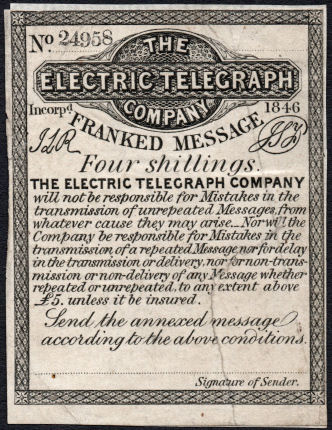 |
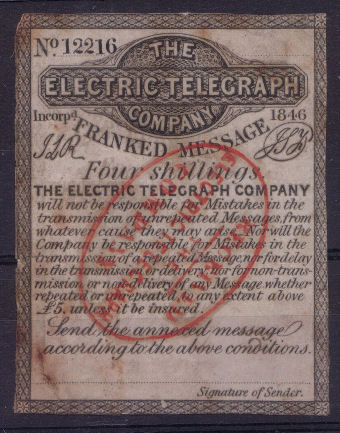 |
| 4s mint example. Hiscocks H13 black on white | 4s used example. Hiscocks H13 black on white |
| 4s mint and used - courtesy of Steve Lawrie. - click image for a larger version. | |
Hiscocks (1982) lists the following, Dates from Raymond Lister(1961), Rarity-guide taken from L&H(2003):
| RH # | Hisc. | Second series Description | Rarity | Mint | Used |
|---|---|---|---|---|---|
| RH4 | H4 | 3d Black on pale yellow (Sept. 1857, controls 1-50000) | R4 | 400.00 | - |
| RH4a | ' ' ' Proof, no control number. | 200.00 | - | ||
| * | H5 | 1s Black on yellow brown (Plate 1, Nov. 1854) | * | ||
| RH6 | H6 | 1s Black on buff (Plate 2, Nov. 1857, controls 1-40000) | R4 | 300.00 | - |
| RH6a | ' ' ' Proof, no control number. | 200.00 | - | ||
| RH7 | H7 | 1s Black on pink (Plate 1, 7/17 May 1855, controls 10001-20000) | Unknown | 1200.00 | 1000.00 |
| RH8 | H8 | 1s6d Black on pink (Sept. 1855, made from 1s plate 1, controls 1-100000, A1-A60000) | R4 | 600.00 | - |
| RH8a | ' ' ' Proof, no control number. | Unrecorded | 400.00 | - | |
| RH9 | H9 | 2s Black on green (17 Jan. 1855, controls 1-10000) | Unknown | - | - |
| RH9a | ' ' ' Proof, no control number. | 400.00 | - | ||
| RH10 | H10 | 2s Black on blue-green (1856? Controls 10001-100000 and A1-A50000) | R4 | 500.00 | - |
| RH10a | ' ' ' Proof, no control number. | 350.00 | - | ||
| RH11 | H11 | 2s6d Black on blue (22 June / 10 July 1855, controls 10001-20000) | Unknown | - | - |
| RH12 | H12 | 3s Black on bright blue (Sept. 1856, controls 20001-80000) ** | Unknown | - | - |
| RH12a | ' ' ' Proof, no control number. | - | - | ||
| RH13 | H13 | 4s Black on white (April 1856, controls 1-100000, A1-A70000) | R4 | 500.00 | 500.00 |
| RH13a | ' ' ' Proof, no control number. *** | 350.00 | - |
Look here for an explanation of the table.
Steve Hiscocks noted here:
Printings of the 1/- on yellow brown were recorded for 1854 and 1857 using different plates.
There were 16 varieties of each but how the plates may be distinguished is not known at present.
My notes:
The One Shilling Plate 1 and 2 ( H7 / H6 ) differences are detailed below.
** despite listing it as unknown, L & H say on Pg.6 that one is in the Royal Collection. Control No. 30312.
*** for 4s imperf. with control number at top right-hand corner see H21 below.
* H5 seems to have been the result of a misunderstanding. Lister uses the same illustration for H1, H2, H3, H5 and H6.
All the 1854 printings and deliveries of the 1s were for H1.
H1, H2 and H3 plates were used to produce H7, H9 and H11 (Jan '55). In August '55, H7 (1s) was modified to 3s (H12) and a new plate was made for the 1s (H6)
Also in August '55, H11 (2s6d) was modified to 1s6d (H8) and a new plate was made for the 4s (H13). A new plate was made for the 3d in July '57.
Unfortunately due to all these modifications, Hiscocks list is not chronological.
Some more examples.
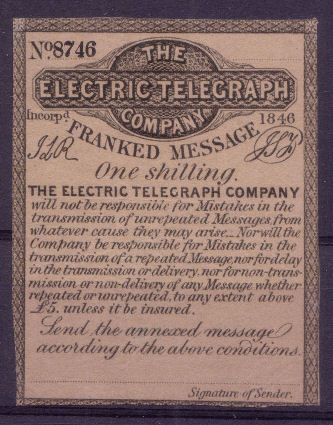 |
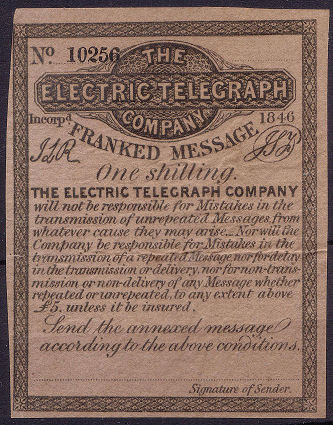 |
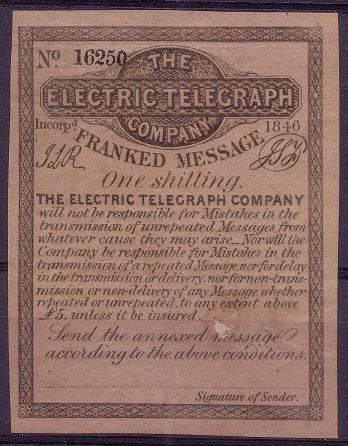 |
| 1s. Hiscocks H6 black on yellow-brown (or buff L & H) - courtesy of Steve Lawrie. - click image for a larger version. | ||
| One Shilling Plate 1 and 2 difference: Langmead & Huggins say that over 30 stamps are known from the 1s plate 2 (H6). They list the following control numbers: 8746, 10252, 10254, 16245-16275 and 21025. I have seen a (poor) image of 10254 and it is bottom-marginal. 10256 shown above should be added to this list. The used example shown on the right was sold by Grosvenor Auctions described as black on pink (Hiscocks H7). The scan, courtesy of Steve Lawrie, shows that it is indeed different in more than just the colour. There are 16 stamps (4 x 4) in each sheet and there is some variation between these, but the differences are mainly in the value.
Which is the odd one out? 14636 clearly has a more upright 'g', it is from a different hand. The dot on the tail of the 'g' is also further to the right of the 'H'. This is a way to distinguish between H6(plate 2) and H7(plate 1) without relying on colour. The Langmead & Huggins book There are probably other differences, but this is the first I have noticed. It is the only example that I have seen of H7. Control numbers 10001-20000 were produced by both plate 1 and plate 2. Controls numbers above or below that range, have to be plate 2. |
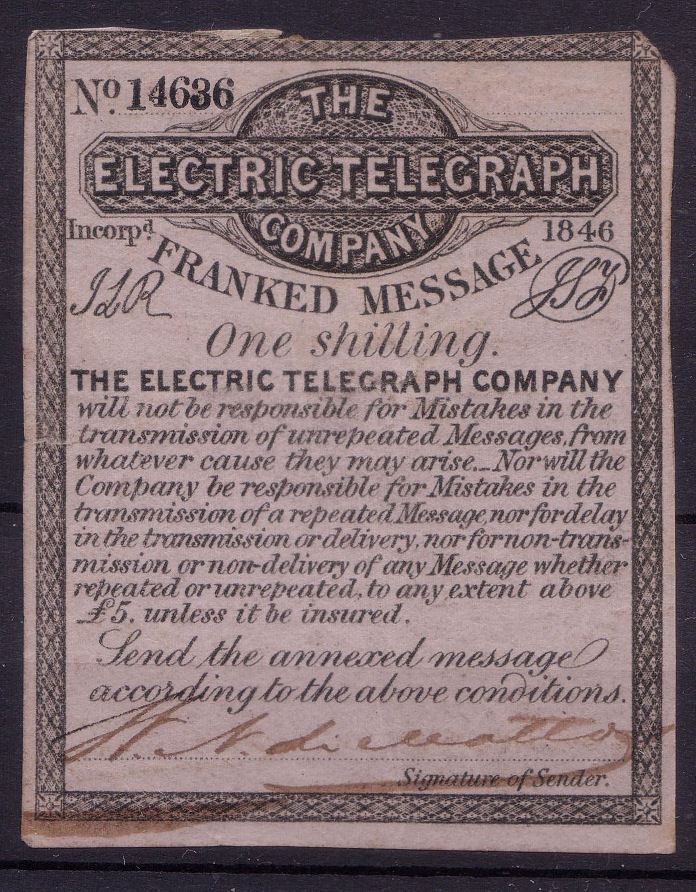 |
||||||||||
| 1s. Plate 1, Hiscocks H7 black on pink - courtesy of Steve Lawrie. |
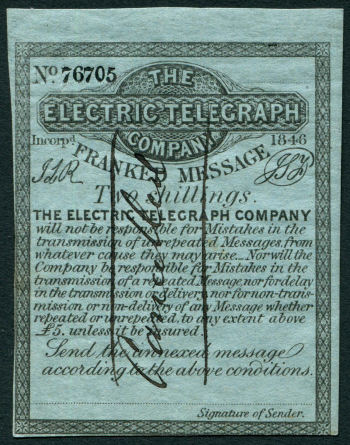
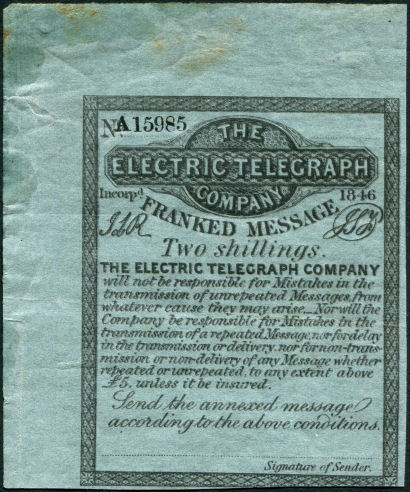
A couple of examples of RH10. These were produced about 1858. At that time the second batch of stamps from this plate were printed on greenish-blue paper.
The first batch with controls 1 to 10000, was delivered in 1855 printed on green paper, only plate proofs are known.
This batch had controls 10001 to 100000 and A1 to A50000. Illustrated is a manuscript Cancelled example numbered 76705 (from the top row of sheet 4794),
together with control A15985, the first stamp of the 1000th sheet of the A. series. - Images courtesy of Steve Lawrie.
Over-view of plate manufacture and use, 1854-61.
The Perkins, Bacon plates went through a series of modifications which is documented in the 1927 book by E. D. Bacon.
I will attempt to tabulate this information in a more accessible form.
In February 1854 The Electric Telegraph Company decided to introduce adhesive stamps and asked Perkins, Bacon for suitable designs.
The Perkins, Bacon engraving book shows drawings made on February 22nd and March 1st, 10th and 23rd, 1854.
A master die was engraved 8th April, with the words "Above 100 miles", but without the words 'Incorpd. — 1846' and a roller-impression taken.
The first plate of 16 impressions (4x4) was completed on 8th May.
The word "above" was removed from the roller impression.
The second plate was made and the word "under" was added by hand to each of the 16 spaces making 'under 100' on 16th May.
The "10" of the distance was removed from the roller impression.
The third plate was made and "5" as well as "under" were added by hand to each of the copies making 'under 50' on 22nd May.
The words 'Incorpd. — 1846' were an afterthought and had to be added by hand to each of the 16 impressions on each of the three plates.
All three plates were made of steel, and because of the additions by hand, they all had 16 slightly different varieties.
These were printed and delivered in two batches in 1854:
| Dates | Type | RH# | Qty. | Controls |
|---|---|---|---|---|
| May 23-30 | under 50 miles, black on pink (1s) | RH1 | 1600 | 1 - 1600 |
| May 23-30 | under 100 miles, black on blue (2s6d) | RH2 | 6400 | 1 - 6400 |
| May 23-30 | above 100 miles, black on white (5s) | RH3 | 6400 | 1 - 6400 |
| Dates | Type | RH# | Qty. | Controls |
|---|---|---|---|---|
| June 1-24 | under 50 miles, black on pink (1s) | RH1 | 8400 | 1601 - 10000 |
| June 1-24 | under 100 miles, black on blue (2s6d) | RH2 | 3600 | 6401 - 10000 |
| June 1-24 | above 100 miles, black on white (5s) | RH3 | 3600 | 6401 - 10000 |
These were first issued on 2st. June 1854. On 21st. of June, J. S. Fourdrinier, the Secretary of the company, sent a letter to Perkins, Bacon
requesting alterations to the plates, noting that they had not yet been hardened:
'We wish the words— "of 20 words—above 100 miles" — "under 100 miles" and "under 50 miles" obliterated in the three plates
and the words introduced in their place— "Two shillings and sixpence" to be printed on blue paper.
"Two shillings" to be printed on green paper.
"One shilling" to be printed on pink paper.
I shall be obliged by your sending me a proof.'
Perkins, Bacon then did all the erasures and added "Two shillings and sixpence" on one impression on one of the plates on June 28th.,
sending a proof of it for approval before continuing. The Engraving book shows that this plate was subsequently completed on July 12th.
Another plate was completed as "One shilling" on July 17th. and the last as "Two shillings" on July 19th.
It was not actually stipulated which plate should be used for what.
The following printings were made from these modified plates:
Note: 10000 stamps is 625 sheets of 16 stamps each.
| Dates | Type | RH# | Qty. | Controls |
|---|---|---|---|---|
| 17 Jan. 1855 | 2s black on green | RH9 | 10000 | 1 - 10000 |
| 7-17 May 1855 | 1s [pink] | RH7 | 10000 | 10001 - 20000 |
| 22 June / 10 July | 2s6d blue | RH11 | 10000 | 10001 - 20000 |
Pursuant to new instructions from the Electric Telegraph Co. Two of the plates were again altered and a new plate made.
The 1s plate was altered to 3s on 9th August 1855
The 2s6d plate was altered to 1s6d on 9th August 1855
A new plate for 4s was created on 18 August 1855.
A new plate for 3d was created on 7 July 1857.
A new plate for 1s (plate 2) was created on 8 October 1857.
These three new plates were made from the original roller-impression after removal of "of 20 words — above 100 Miles."
It was then necessary to add the value and 'Incorpd. — 1846' to each of the 16 impressions of each plate by hand again.
E. D. Bacon quotes a Tariff given for 1855 as follows:
No charge was made for names and addresses of either
sender or receiver, and telegrams were delivered free within
half a mile of the Company's offices. The company had at
that date upwards of 350 stations in Great Britain and Ireland.
Notes.
Stamps from this period printed on coloured paper, often look very different today.
The affects of environmental conditions (temperature, humidity, UV and atmospheric pollutants) over
long periods of time has bleached and/or discoloured many of them. Different pigments may suffer more than others so that paper
with a mixture of pigments may change colour over time. Also the ones on white paper are often very 'toned' today due to oxidisation.
Perforated by Perkins, Bacon using a machine from James Griffiths in June 1860.
The 23-inch row of pins was un-evenly spaced, giving a variable gauge of 14 to 16½ according to E. D. Bacon, Hiscocks and Lister, 14 to 15½ according to L&H
Philbrick & Westoby (1881) give the size of these as 52 by 67 mm.
Walter Morley (The Fiscal Philatelist March 1893 says
"This is given as imperforate, but Mr. Fred. Geo. C. Lundy has unearthed a Three pence, black on light yellow paper, with the perforation 17. In respect to perforation, this stamp is a curiosity, as no other English stamps (either Postage, Telegraph or Fiscal) exist with one so small. The copy is in Mr. Philbrick's possession, but whether this value only was perforated by Messrs. Perkins, Bacon & Co. (or by other hands) or the entire six values; or whether the printers only used a sheet or two as trials of the gauge 17, I am unable to say. At least one sheet must have been perforated, because the original owner had three together, which he found in his desk, and which had originally been bought while the stamps were in circulation. The other two are still in his possession."
Langmead and Huggins say these were controls 56280, 56281 and 58354 with 58354 being in the Royal Philatelic Collection.
They illustrate 56280, and it appears to be life-size judging by the measurements (52 x (nearly)67 mm or 2 1/16 x 2 5/8 inches.
L&H also say the perforations are irregular from 14 to 15½. I make the first 3 of these about Perf.15½
Here are the 3d controls 56280 and 56281 (H14), together with a 4/- control A91920 and A91928 (H20, all half size).
| 3d. Hiscocks H14 control 56280 | 3d. Hiscocks H14 control 56281 | 4s. Hiscocks H20 control A91920 | 4s. Hiscocks H20 control A91928 |
| From Langmead & Huggins' book (Fig.5), courtesy of the Great Britain Philatelic Society |
These were part of the A. J. Lowe collection sold by Phillips on 2 November 1990. Black and white image courtesy of Phillips, Son & Neale. |
I make this 14-14½ at the top, 15-15½ bottom by left 15-15¾, right 15¼-15¾ Image courtesy of Steve Lawrie. |
|
Printings according to E. D. Bacon in 1927:
| Dates | Type | RH# | Qty. | Controls | Notes |
|---|---|---|---|---|---|
| 9-17 July 1860 | 3d straw | RH14 | 10000 | 50001 - 60000 | |
| 9-17 July 1860 | 2s green | RH17 | 10000 | A20001 - A30000 | 2 |
| 16-21 Aug. 1860 | 4s white | RH20 | 10000 | A70001 - A80000 | |
| 16-21 Aug. 1860 | 1s6d pink | RH16 | 10000 | A60001 - A70000 | |
| 20-26 Sept. 1860 | 2s green | RH17 | 10000 | A30001 - A40000 | 2 |
| 27 Sept. 1860 | 1s6d pink | RH16 | 8000 | A70001 - A78000 | |
| 27 Sept. 1860 | 4s white | RH20 | 3200 | A80001 - A83200 | |
| 3 Oct. 1860 | 4s white | RH20 | 6800 | A83201 - A90000 | |
| 23 Oct. 1860 | 1s6d pink | RH16 | 2000 | A78001 - A80000 | |
| 6 Nov. 1860 | 4s white | RH20 | 8000 | A90001 - A98000 | |
| 7-13 Dec. 1860 | 1s6d pink | RH16 | 10000 | A80001 - A90000 | |
| 7-13 Dec. 1860 | 3s blue | RH19 | 10000 | 80001 - 90000 | |
| 7-27 Dec. 1860 | 4s white | RH20 | 2000 | A98001 - A100000 | 1 |
| 7-27 Dec. 1860 | 4s white | RH21 | 10000 | A100001 - A110000 | 1 |
| 13 Dec. 1860 | 3d straw | RH14 | 10000 | 60001 - 70000 | |
| 20 Dec.1860 | 2s green | RH17 | 10000 | A40001 - A50000 | 2 |
| 7 Mar. 1861 | 1s buff | RH15 | 10000 | 40001 - 50000 |
Notes.
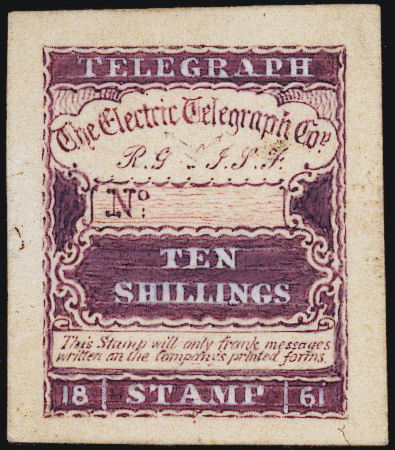
This image from Langmead & Huggins' book (colour plate 1), is described as a Die proof but would appear to be the artists drawing by Charles Henry Jeens
of the 10/- stamp used to tender for the contract. This is recorded by Raymond Lister in his 1961 book where it was valued at £50.
Image courtesy of the Great Britain Philatelic Society. According to E. D. Bacon, Perkins, Bacon & Co. also submitted a tender with a drawing, but nothing is now known of it.
These were issued 1861 to 1864 with the initials 'R.G.' (Robert Grimston - Chairman) and 'J.S.F.' (James Sealy Fourdrinier - Secretary).
These were initially Perf.12 but changed to Perf.12½ in 1863. They were in sheets of 10 rows of 10 stamps.
Langmead & Huggins say "The highest serial numbers recorded for the RG/JSF issues are: 1s 64969; 1s6d 67804; 3s 23149."
I think their figure for the 1s must have a digit missing, 231352 is shown lower down, and 1s6d 67836. I have also seen 3s 37729.
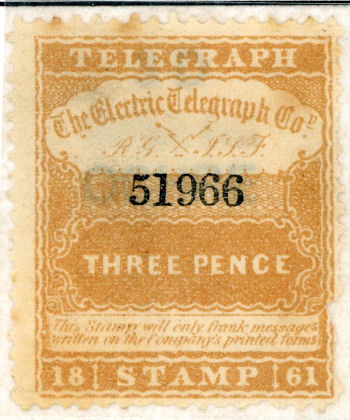 |
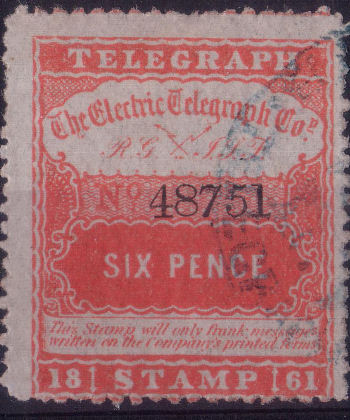 |
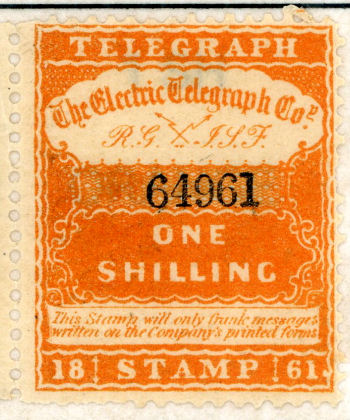 |
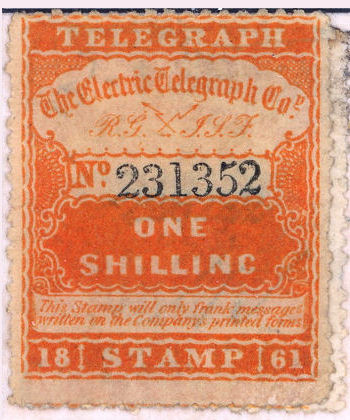 |
| 3d. Perf.12 Hiscocks H22 | 6d Perf.12½ Hiscocks H33 | 1s. Perf.12 Hiscocks H24 | 1s. Perf.12½ (white tablet) Hiscocks H34 |
| Image courtesy of Dr Mark Gibson. | Image courtesy of Steve Lawrie. | Image courtesy of Dr Mark Gibson. | Image courtesy of Dr Mark Gibson. |
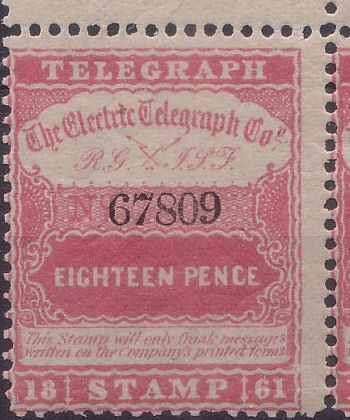 |
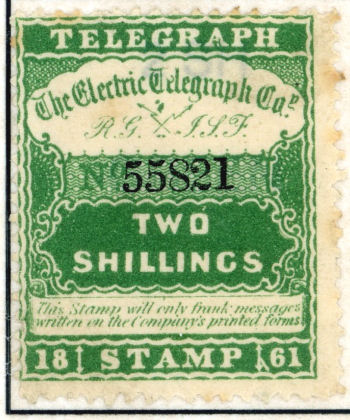 |
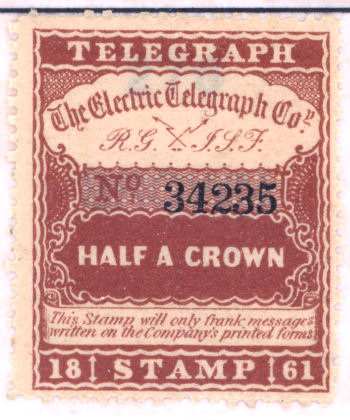 |
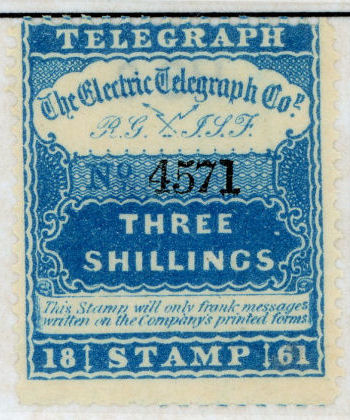 |
| 1s6d. Perf.12 Hiscocks H25 | 2s. Perf.12 Hiscocks H26 | 2s6d. Perf.12½ Hiscocks H37 | 3s. Perf.12 Hiscocks H28 |
| Images courtesy of Dr Mark Gibson. | |||
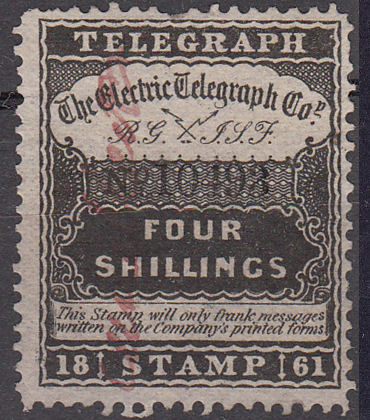 |
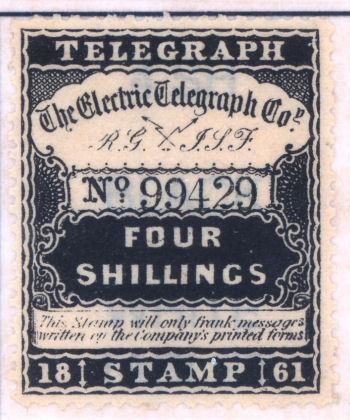 |
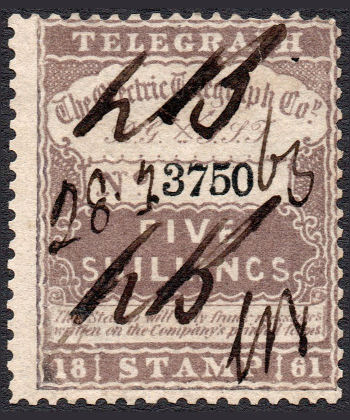 |
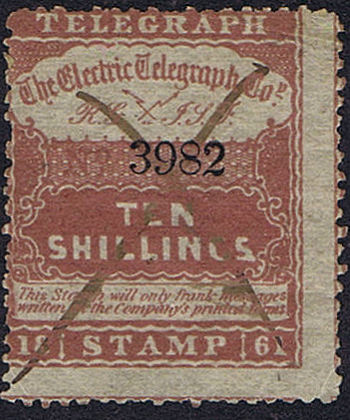 |
| 4s. (black control tablet) - Hiscocks H29 | 4s. Perf.12½ Hiscocks H39 | 5s. Perf. 12 Hiscocks H31 dated 28/3/63 | 10s. Perf.12½ Hiscocks H41 |
| Image courtesy of Martien Blank. | Image courtesy of Dr Mark Gibson. | Image courtesy of Steve Lawrie. | Anonymous. |
I have only seen three of the 10s, two from the same row of the same sheet, 3982 and 3986. The other badly damaged, numbered 2902 with 'cancelled' written across it.
They display flaws but they do not match.
RG/JSF
Used prices are for pen cancels, hand-stamp cancels are worth a premium over mint.
Philbrick & Westoby (1881) list a 2s imperforate in blue.
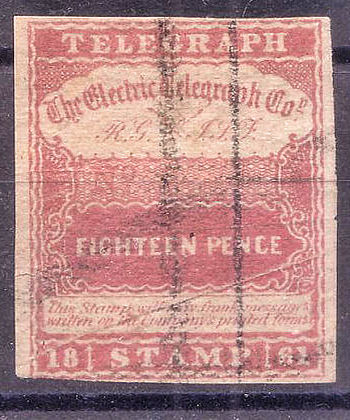 |
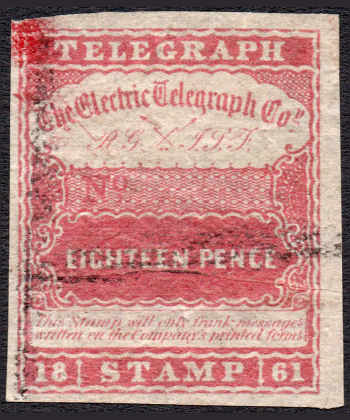 |
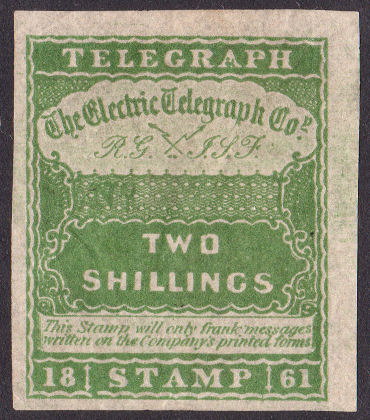 |
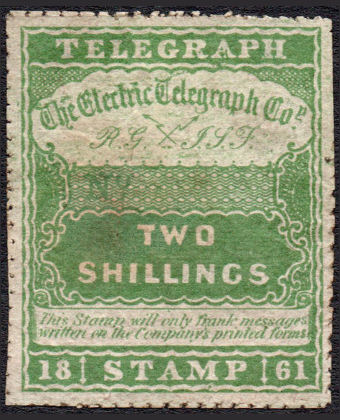 |
| 1s6d. Imperf. of H25. - Courtesy of Steve Lawrie. |
1s6d. Imperf. of H25. - Courtesy of Steve Lawrie. |
2s. Imperf. of H26 Plate 1 (see below). |
2s. Imperf. of H26 plate 1. sewing-machine Perforated ? Courtesy of Steve Lawrie. |
These stamps were printed by Waterlow & Sons who also printed stamps for
Bonelli's Electric Telegraph Company Limited and
The Universal Private Telegraph Company.
On those stamps, flaws were repeated every 5 stamps.
Dr Mark Gibson offered to help with checking for the same pattern on these.
The results have been interesting and not at all what I expected.
Many blemishes are not constant, but the few repeated ones show a different patterns for at least some of them.
In doing this I am assuming the last digit of the controls run from 1 to 0 as the others.
I have not found anything to contradict this, but blocks that might confirm it are scarce.
The blocks owned by Steve Lawrie certainly support it.
| Shortcuts to different RG / JSF value details | |||||||||
| 3d | 6d | 1s | 1s6d | 2s | 2s6d | 3s | 4s | 5s | 10s |
There seems to be two fundamentally different types of these, with the earliest having a flaw to the left of the 'Terms & Conditions'.
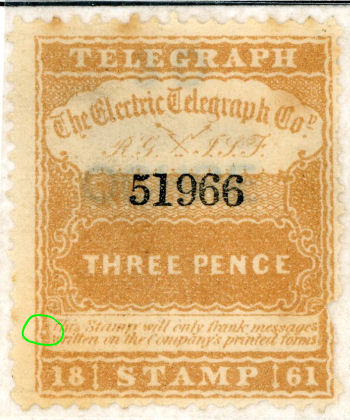 |
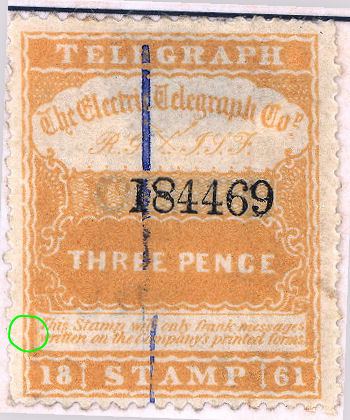 |
| I have seen this on controls in the range 2126 to 55062. |
I have seen these on controls in the range 77077 to 186163. |
| Images courtesy of Dr Mark Gibson. | |
Lowest seen 2126, highest seen 55062
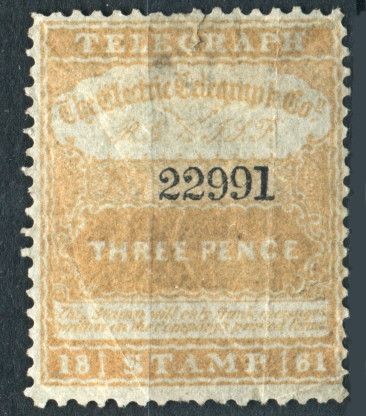 |
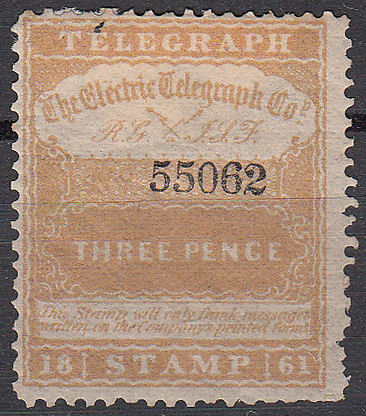 |
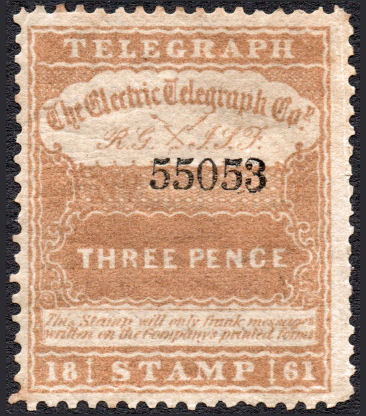 |
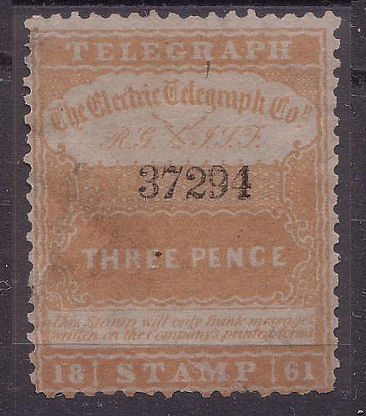 |
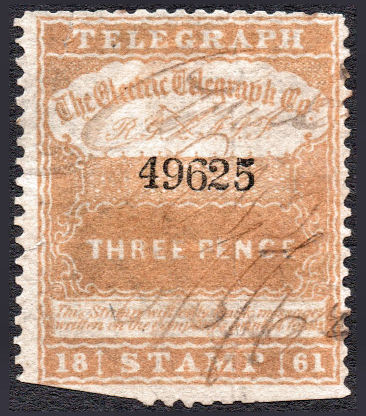 |
| 3d Column 1. | 3d Column 2. | 3d Column 3. | 3d Column 4. | 3d Column 5. |
| Ex Iain Stevenson, Courtesy of Grosvenor Auctions. | Image courtesy of Martien Blank. | Image courtesy of Steve Lawrie. | Image courtesy of Steve Lawrie. | Image courtesy of Steve Lawrie. |
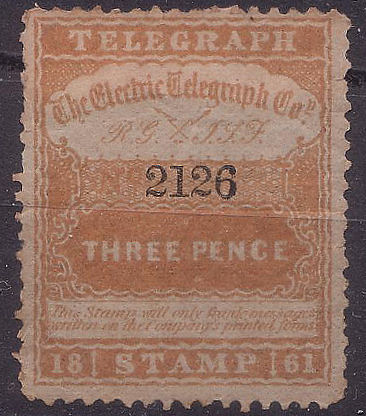 |
 |
 |
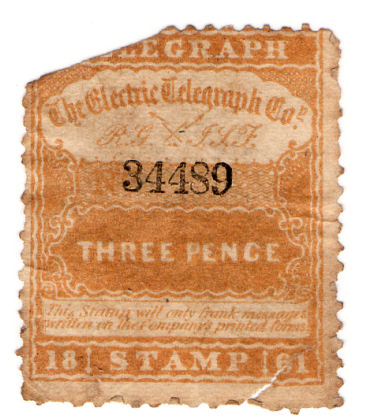 |
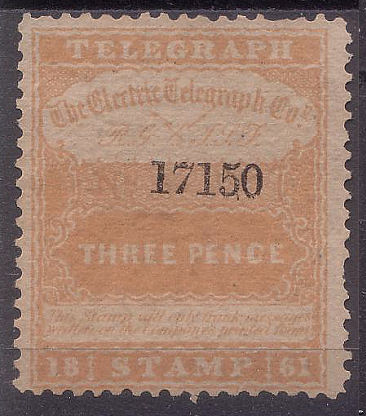 |
| 3d Column 6. | 3d Column 7. - Scan needed. | 3d Column 8. - Scan needed. | 3d Column 9. | 3d Column 0. |
| Image courtesy of Steve Lawrie. | Courtesy of ibredguy.co.uk and Mark Talbot. | Image courtesy of Steve Lawrie. |
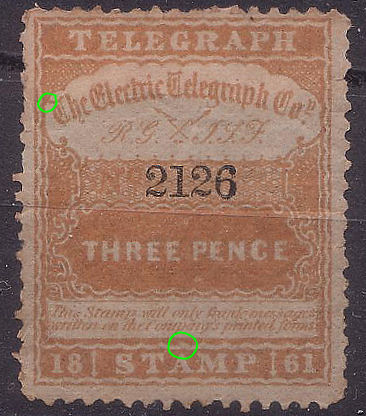
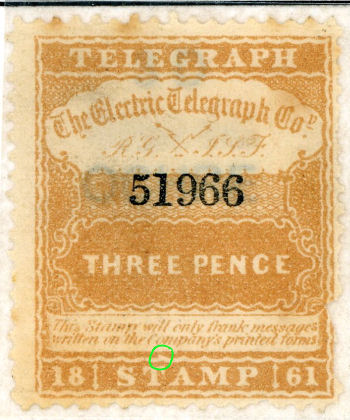
These two present a problem though, they are both column 6, but they are different.
One has a malformed frame above the 'A' of 'STAMP', the other has it above the 'T'.
Possibly mis-numbering, perhaps an indication of another similar plate, plate-position flaws, or perhaps these are not constant flaws.
Alternatively, as I have seen with other telegraph stamps, it could be a substituted cliché.
Lowest seen 77077, highest seen 186163. Above about 100,000 the controls are larger.
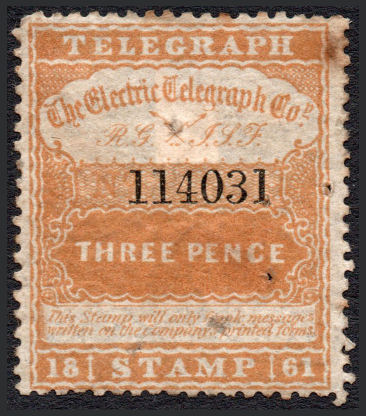 |
 |
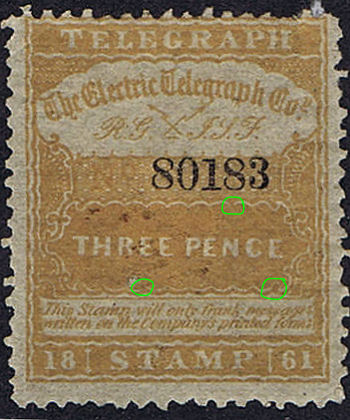 |
 |
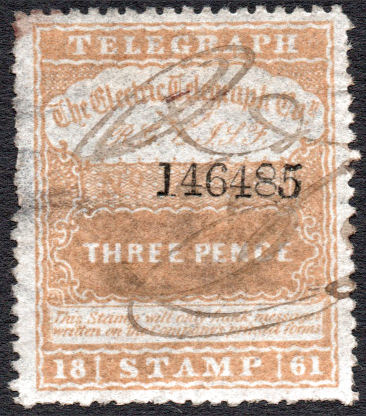 |
| 3d Column 1. | 3d Column 2. | 3d Column 3. | 3d Column 4. - Scan needed. | 3d Column 5. |
| Image courtesy of Steve Lawrie. | Anonymous - The marked flaws are also on 186163, 100636 and 184469. |
Image courtesy of Steve Lawrie. |
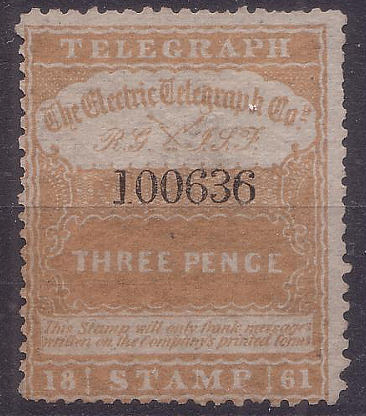 |
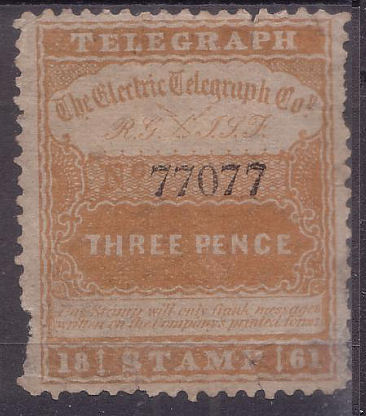 |
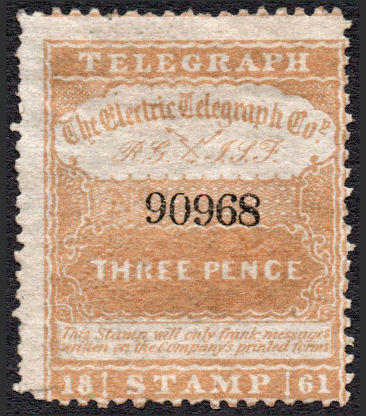 |
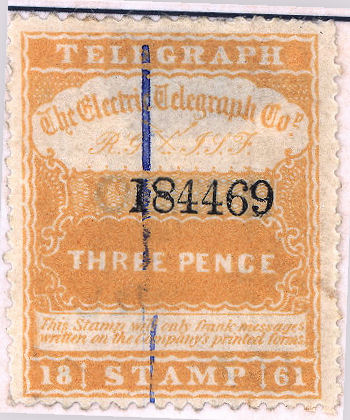 |
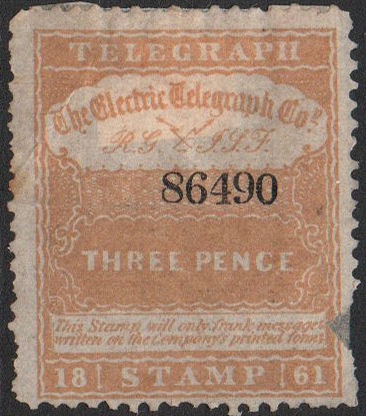 |
| 3d Column 6 - similar to column-3. | 3d Column 7. | 3d Column 8. | 3d Column 9. | 3d Column 0. |
| Image courtesy of Steve Lawrie. | Image courtesy of Steve Lawrie. | Image courtesy of Steve Lawrie. | Image courtesy of Dr Mark Gibson. | Image courtesy of Steve Lawrie. |
Columns 3, 6 and 9 have common flaws.
I have few scans. Lowest control number seen 1050, highest 49842.
These are reported to exist perf. 12, but I have not seen any and L & H do not list them. However I have not seen any with control numbers below 1050, so the first 1,000 could have been perf. 12.
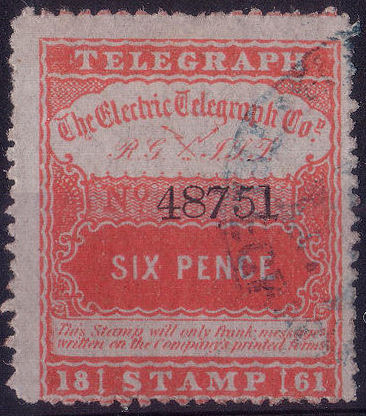 |
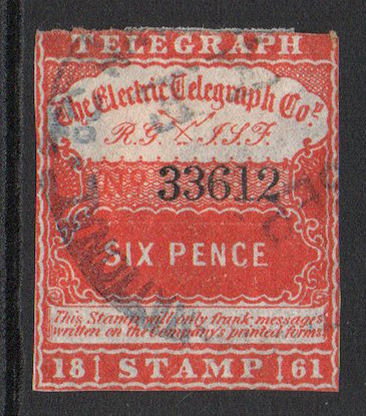 |
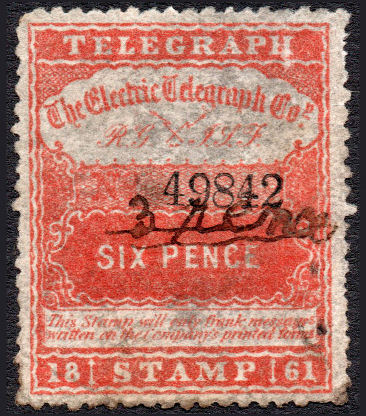 |
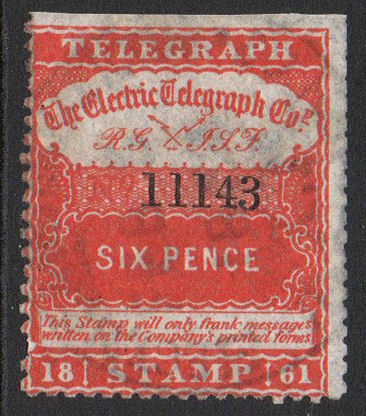 |
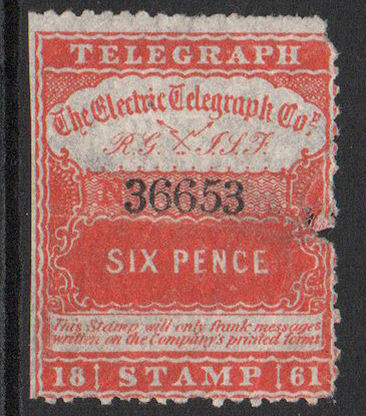 |
| Column-1, 48751 | Column-2, 33612 | Column-2, 49842 | Column-3, 11143 | Column-3, 36653 |
| Image courtesy of Steve Lawrie. | ||||
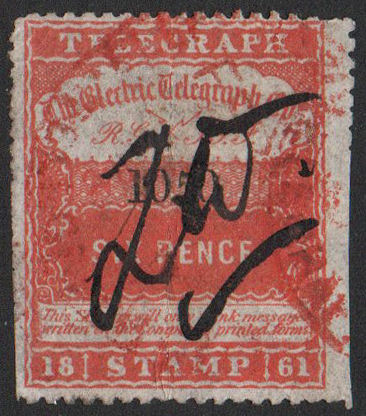 |
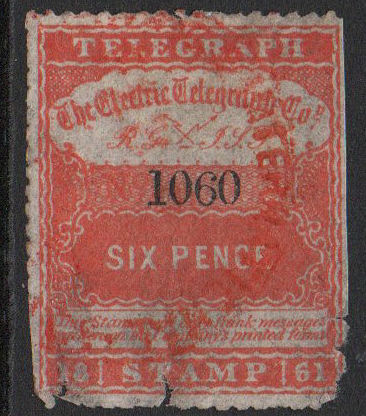 |
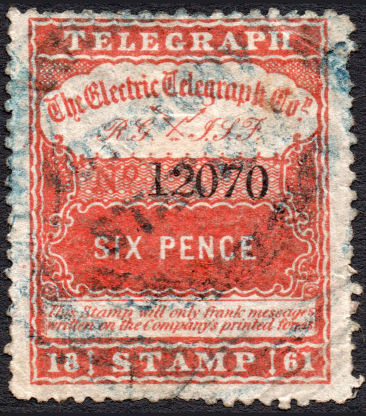 |
| Column-0, 1050 | Column-0, 1060 | Column-0, 12070 - without the flaws |
| Images courtesy of Steve Lawrie. | ||
Other details :
At the moment these are all the scans I have, but it forms the basis for comparisons. Anyone have more ?
12070 seems strangely different. It does not match any of the others and has "SIX PENCE" further to the left.
These all have a blemish right of '61' at bottom right corner. Lowest control number seen 803, highest 78531.
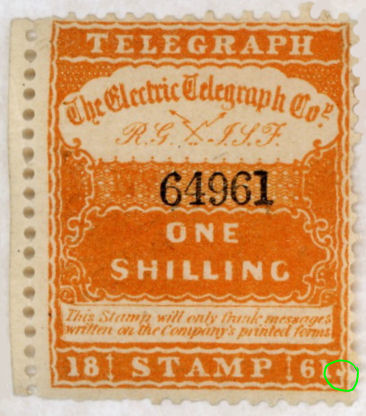 |
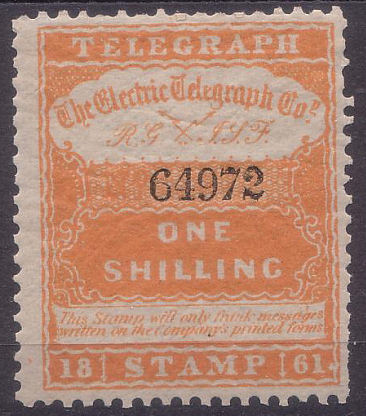 |
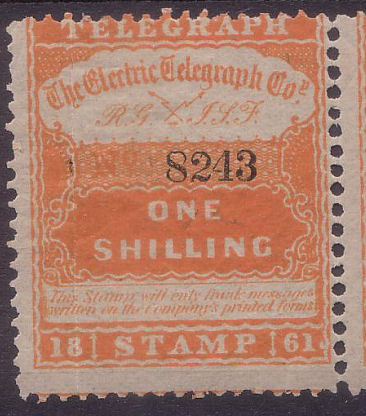 |
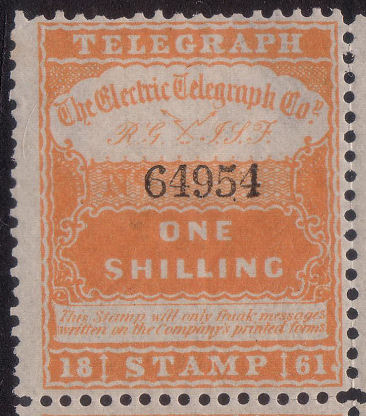 |
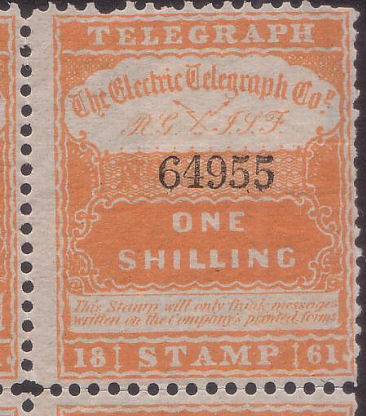 |
| 1s Column 1. Blemish right of '61' at bottom right corner. |
1s Column 2. |
1s Column 3. | 1s Column 4. | 1s Column 5. |
| Courtesy of Dr Mark Gibson. | Courtesy of Steve Lawrie. | Courtesy of Steve Lawrie. | Courtesy of Steve Lawrie. | Courtesy of Steve Lawrie. |
 |
 |
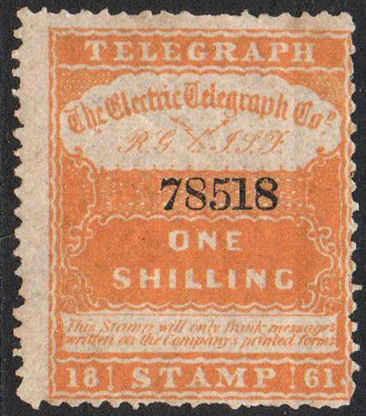 |
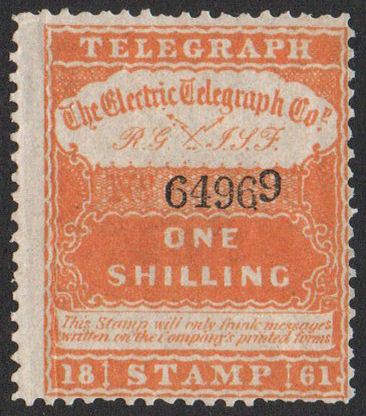 |
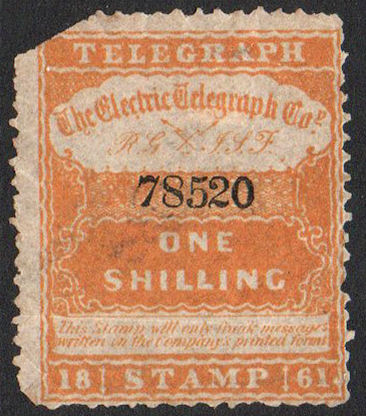 |
| 1s Column 6. | 1s Column 7. | 1s Column 8. | 1s Column 9. | 1s Column 0. |
| Scan needed. | Scan needed. | Courtesy of Steve Lawrie. | Courtesy of Steve Lawrie. | Courtesy of Steve Lawrie. |
This perhaps seems a bit tenuous based on one stamp, but 98547 appears to be plate 1 with the blemish repaired.
It is the only example I have seen between control numbers 78531 and 117181,
but keep in mind I do not currently have an image of a normal plate 1 from columns 6 or 7.
 |
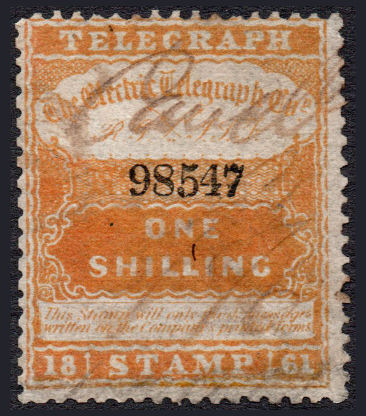 |
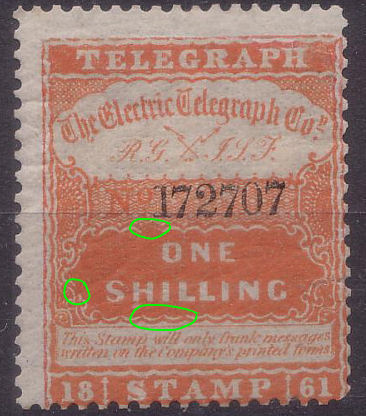 |
| Plate 1a characteristics - (lowest seen 803, highest seen 78531) | Plate 1b Col-7. | Plate 2a Col-7 characteristics - (lowest seen 117181) |
| Image courtesy of Dr Mark Gibson. | Image courtesy of Steve Lawrie. | Image courtesy of Steve Lawrie. |
Scans of shilling stamps with controls between 78599 and 117100 would be very welcome.
Lowest seen 117181, highest seen 184958
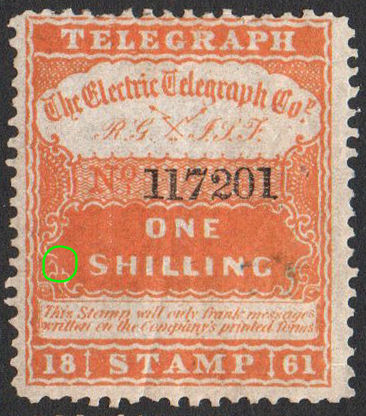 |
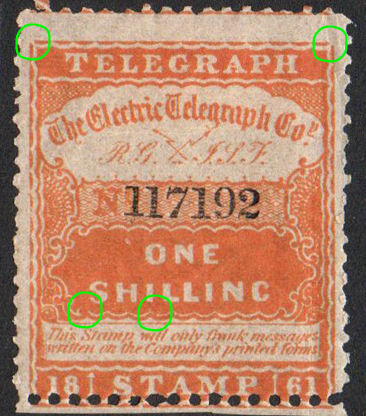 |
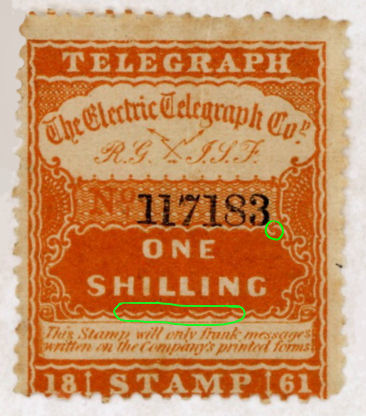 |
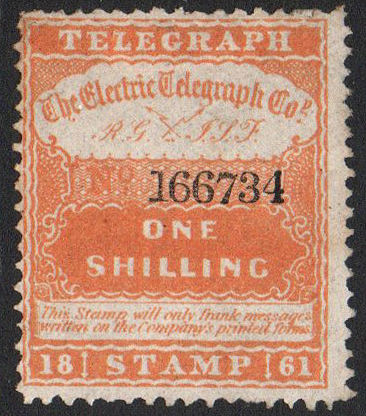 |
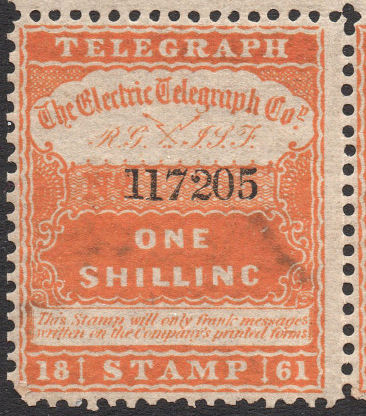 |
| 1s Column 1. Frame-break left of 'SHILLING'. |
1s Column 2. Characteristic frame-breaks and corners. |
1s Column 3. Multiple frame breaks below 'SHILLING'. |
1s Column 4. Like column 1. |
1s Column 5 Like column 2. |
| Courtesy of Steve Lawrie | Courtesy of Steve Lawrie | Courtesy of Dr Mark Gibson. | Courtesy of Steve Lawrie | Courtesy of Steve Lawrie |
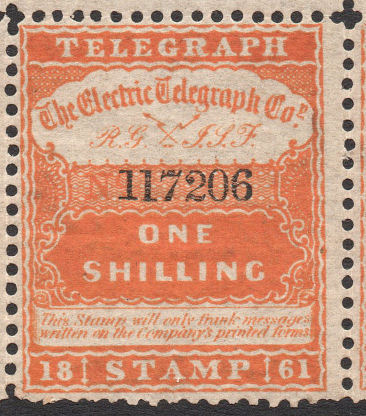 |
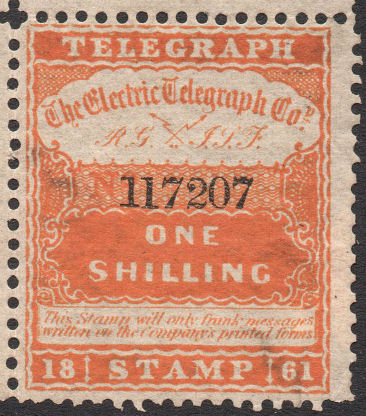 |
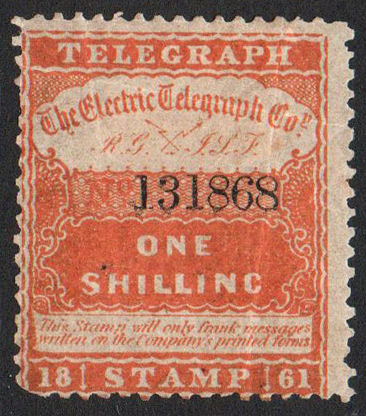 |
 |
 |
| 1s Column 6, like column 3. This also has a new style large control number. |
1s Column 7. Like column 1. |
1s Column 8, like column 2. Large control number. |
1s Column 9, Scan needed. | 1s Column 0, Scan needed. |
| Courtesy of Steve Lawrie | Courtesy of Steve Lawrie | Courtesy of Steve Lawrie |
Note that 131868, 183446 and 184958 seem to have larger control numbers, though the difference is not great, about 3.0 mm as against 2.75 mm.
The '4' is characteristic.
 |
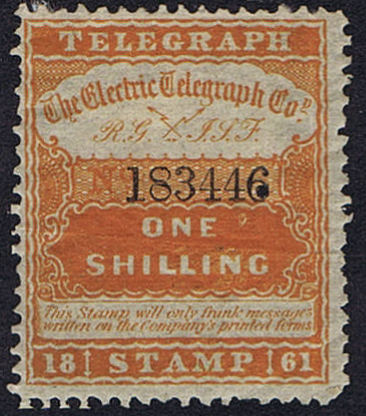 |
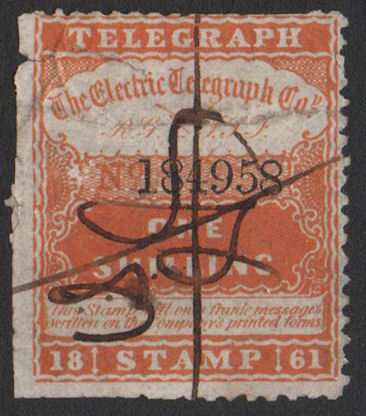 |
| 1s - 131868. Large control number. |
1s - 183446. Large control number. |
1s - 184958 highest control seen. Large control number. |
| Courtesy of Steve Lawrie | Courtesy of Mark Gibson | Courtesy of Steve Lawrie |
Plate characteristics inherited from plate 2a.
Lowest seen 139886, highest seen 286558 (this overlaps with Plate 2a numbers).
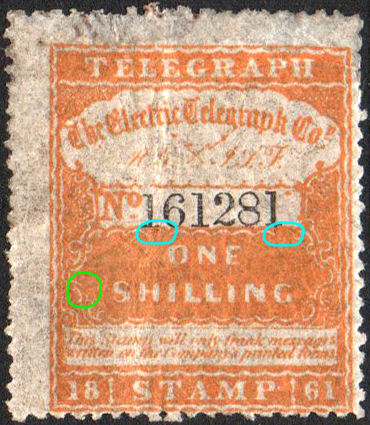 |
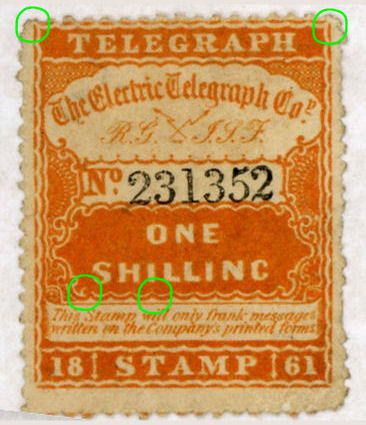 |
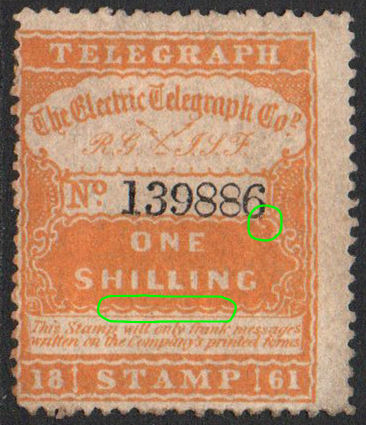 |
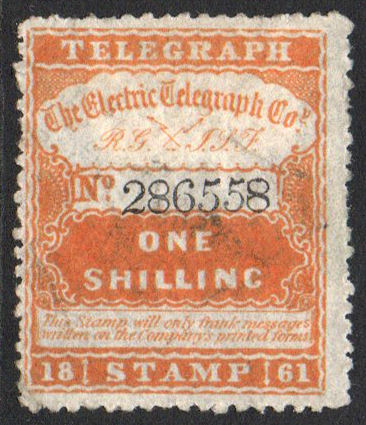 |
| 1s Column 1, this has the characteristics as plate 2a, but two former weaknesses are now strengthened. |
1s Column 2, Characteristics as plate 2a. |
1s Column 6, Characteristics as plate 2a. |
1s Column 8, like column 2 |
| Images courtesy of Steve Lawrie. | Image courtesy of Dr Mark Gibson. | Images courtesy of Steve Lawrie. | |
Plate characteristics still inherited from plate 2a.
Lowest seen 8230A, highest seen 705205A.
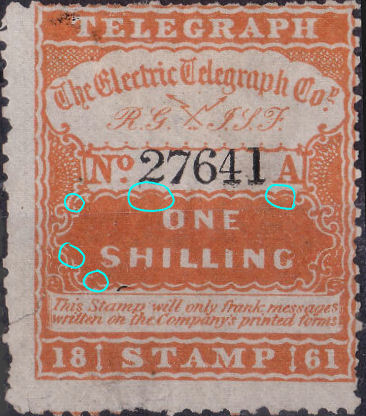 |
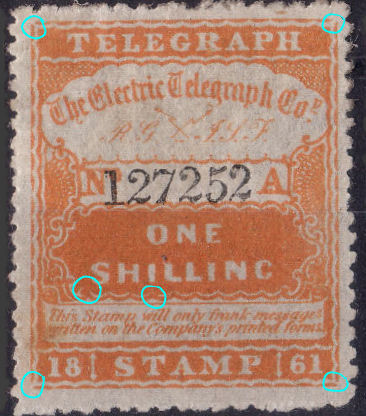 |
 |
 |
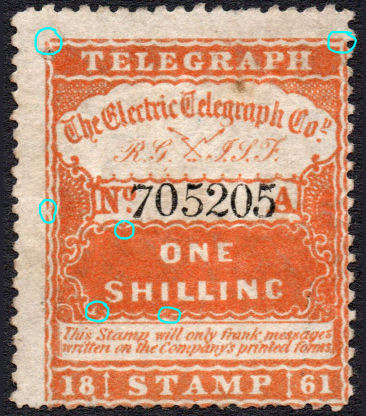 |
| 1s Column 1. This is like plate 2b. | 1s Column 2. This is still like plate 2a. | 1s Column 3 needed. | 1s Column 4 needed. | 1s Column 5. This is like plate 2a. |
| Images courtesy of Steve Lawrie. | Ex Iain Stevenson, courtesy of Grosvenor Auctions. | |||
 |
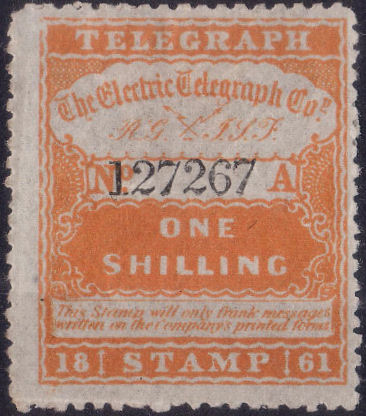 |
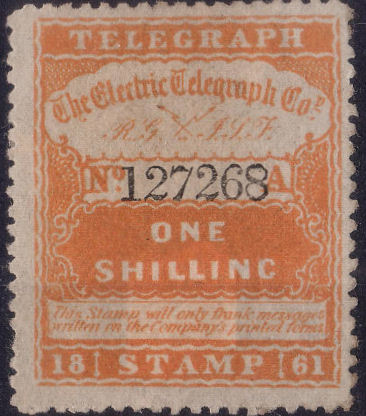 |
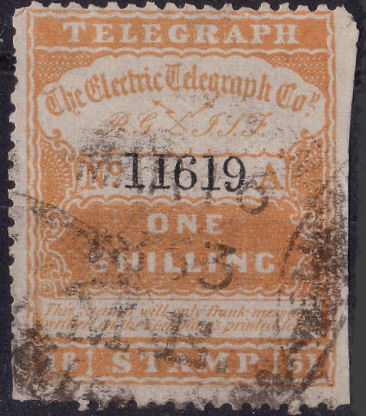 |
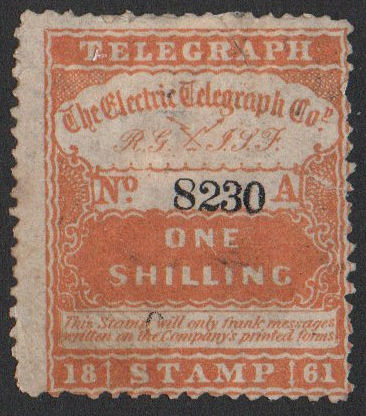 |
| 1s Column 6 needed. | 1s Column 7 - same characteristics as Column 1. | 1s Column 8 - matches Column 2. | 1s Column 9 - matches columns 3 and 6 of Plate 2a. | 1s Column 0 - matches column 1 and 7 |
| Images courtesy of Steve Lawrie. | ||||
Interestingly columns 1 and 7 have a taller 'A' after the serial number than the other examples so far seen I presume column 4 will also..
The pattern of flaws on Plate 2a/b/c is consistent with the pattern I arrive at for the RG/JSF issue, see below.
I am not sure about plates 1 / 1a yet.
I have seen control numbers in the range 4542 to 175069
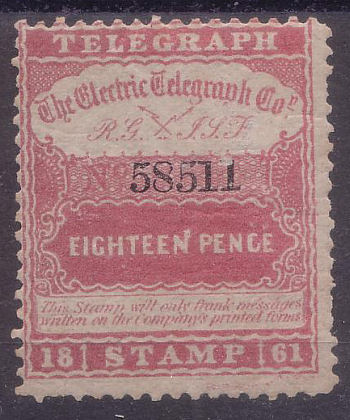 |
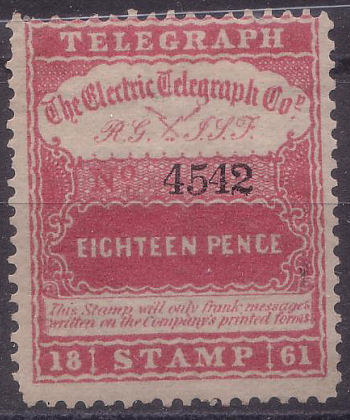 |
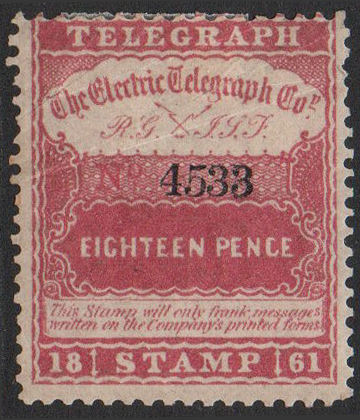 |
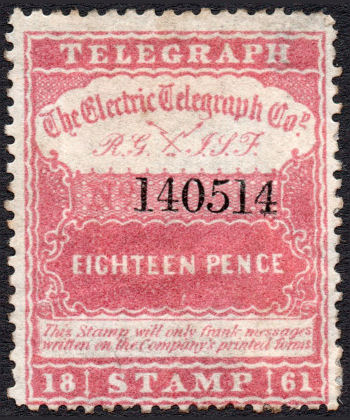 |
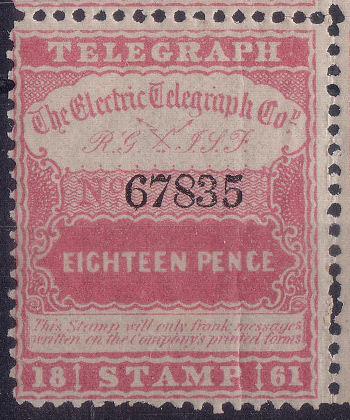 |
| Column 1 | Column 2 | Column 3 | Column 4 | Column 5 |
| Images courtesy of Steve Lawrie. | ||||
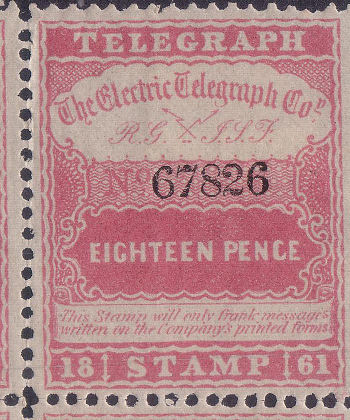 |
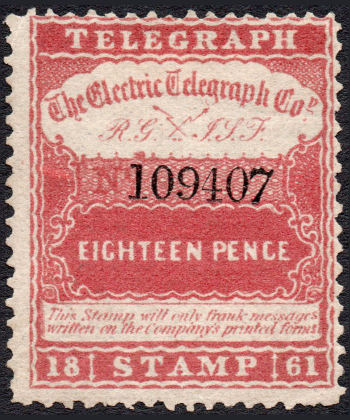 |
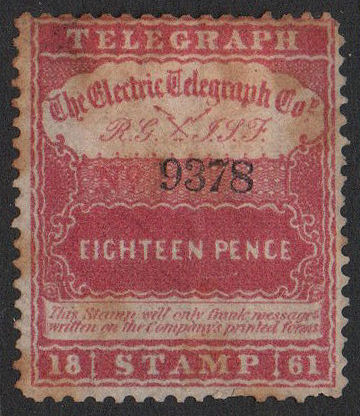 |
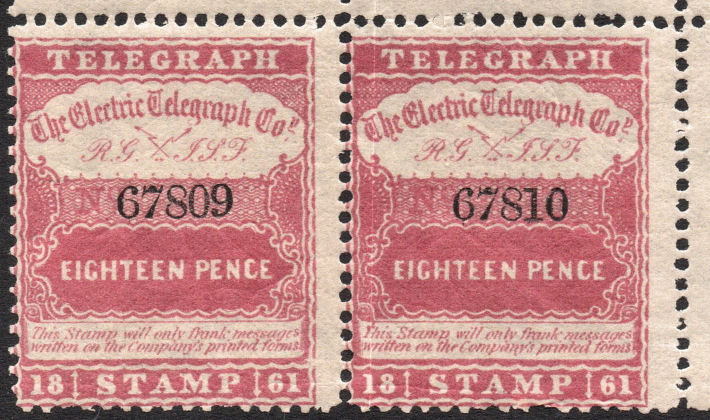 |
|
| Column 6 | Column 7 (perf. 12) | Column 8 | Column 9 | Column 0 |
| Images courtesy of Steve Lawrie. | ||||
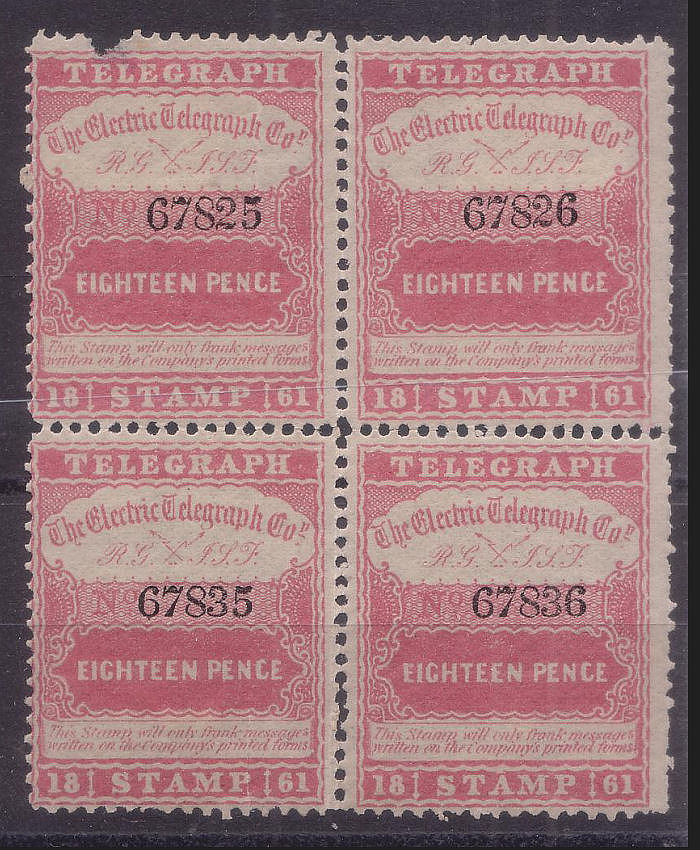 |
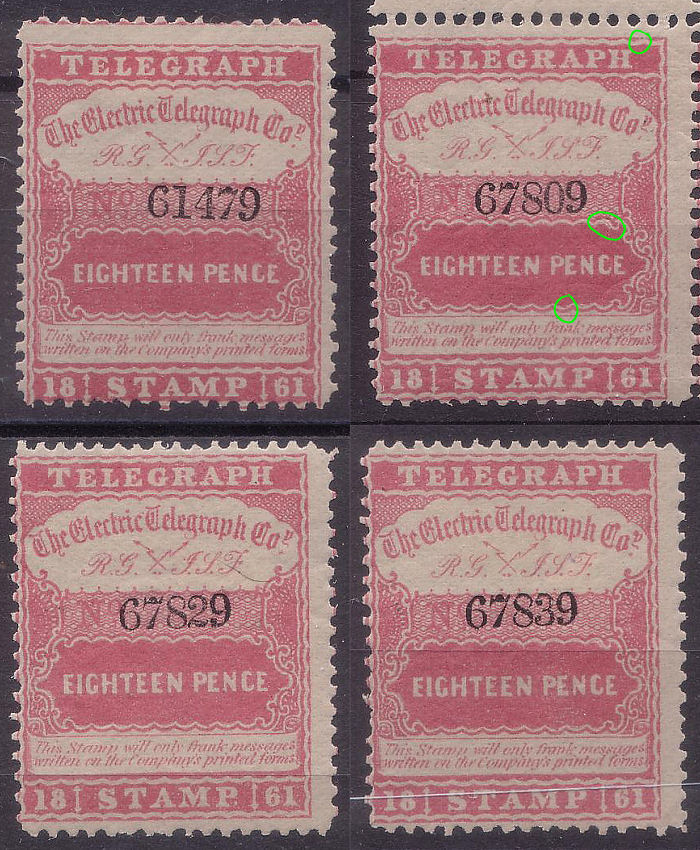 |
| Block of 4 - courtesy of Steve Lawrie. | Column 9, 4 examples showing common flaws - courtesy of Steve Lawrie. |
The only flaws I have seen so far are on all stamps or are non-constant. Some are probably once in a sheet.
These all have characteristics in common:
|
1) Scratches on the 'A' of 'TELEGRAPH'. 2) Frame weakness above 'T' of 'TWO'. 3) Mark on frame-line above 'o' of 'only'. |
I have seen control numbers from this plate in the range 2889 to 88904(Perf.12) and 93797, 101676 and 127647(Perf.12½)
Control numbers 111544 and 131801 are from a different plate, even though the control numbers overlap the above range!
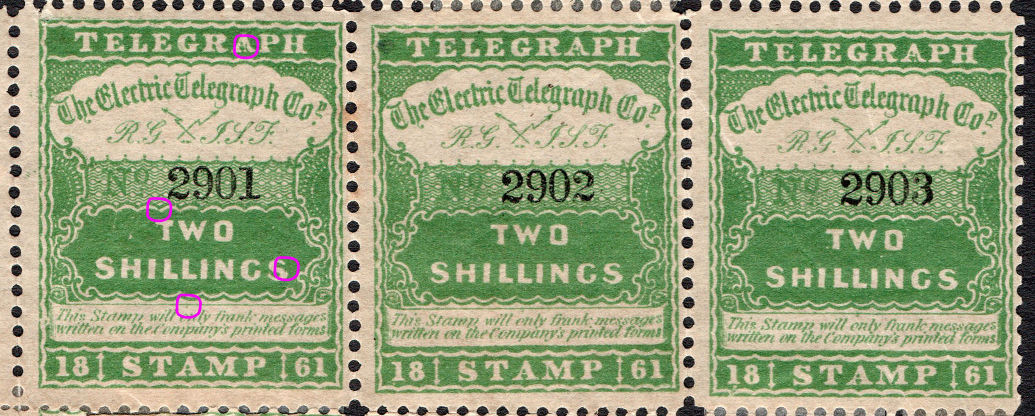 |
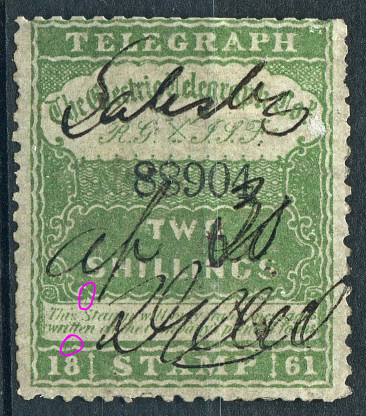 |
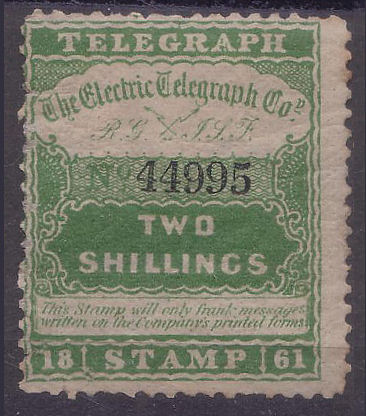 |
||
| 2s Column 1. showing characteristic flaws of the plate. |
2s Column 2, 'A' of 'TELEGRAPH' has more scratches. |
2s Column 3. | 2s Column 4. (Perf.12) | 2s Column 5. |
| Image courtesy of Steve Lawrie. | Ex Iain Stevenson, courtesy of Grosvenor Auctions. | Image courtesy of Steve Lawrie. | ||
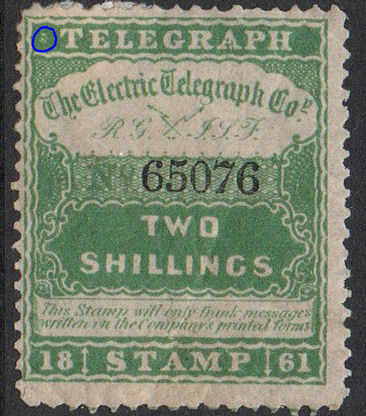 |
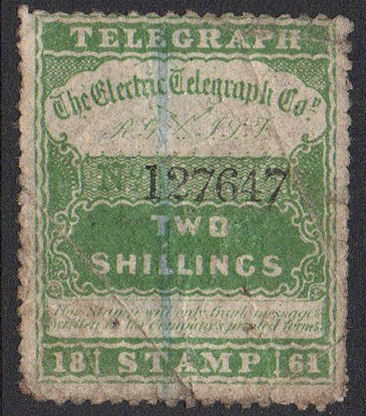 |
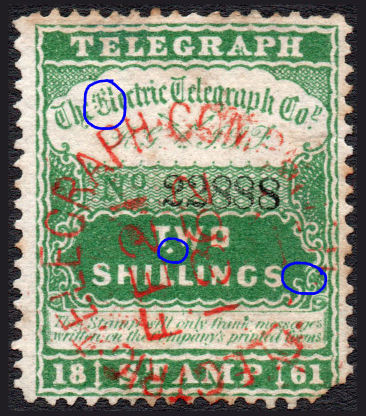 |
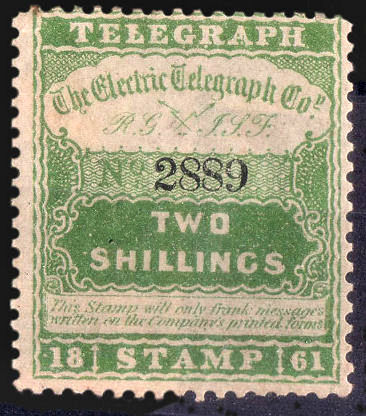 |
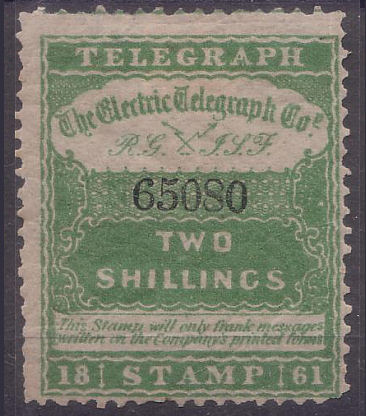 |
| 2s Column 6. - this flaw is also on 101676 | 2s Column 7. (perf.12½) | 2s Column 8. | 2s Column 9. | 2s Column 0. |
| Images courtesy of Steve Lawrie. | ||||
I have seen only 3 examples so far, controls 111544, 131063 and 131801. These do not have the characteristics of the plate detailed above.
The lowest number I have seen for the following RG/HW type is 175437. It is possible that the numbering followed on from these.
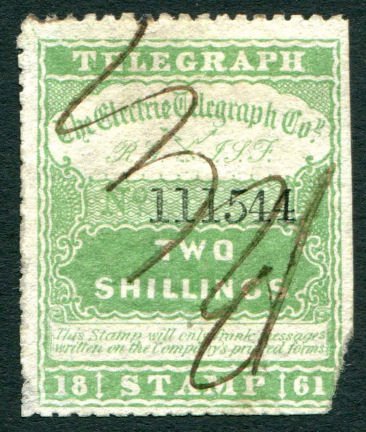
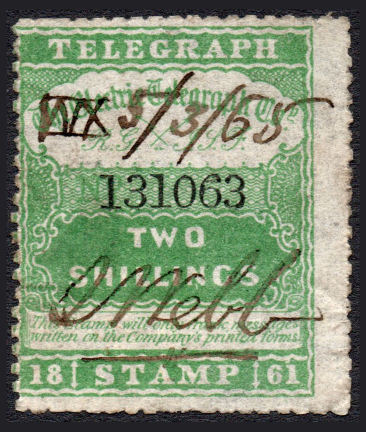
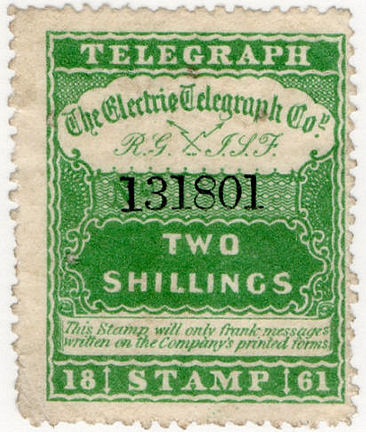
131063 is dated 5/3/65. Henry Weaver became the secretary in 1864, but presumably it took a while to produce stamps with his initials on.
If they had only just printed sheets from a new plate they may have decided to finish using them first.
Plate comparison:
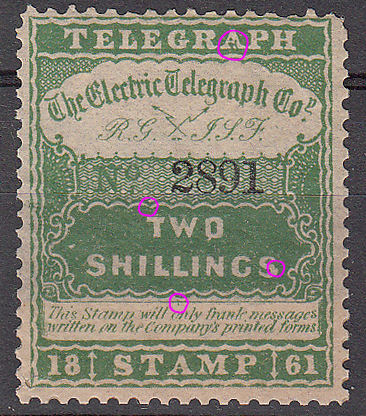 |
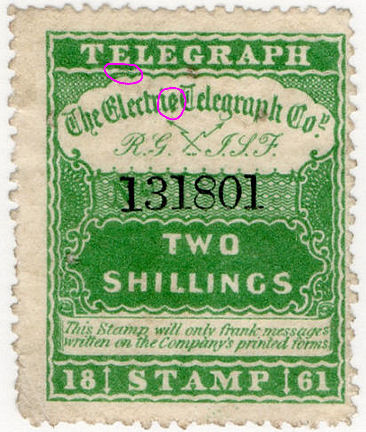 |
| 2s Plate 1 (Column 1). showing characteristic flaws of the plate. |
2s Plate 2 (Column 1). showing possible characteristic flaws. |
| Image courtesy of Martien Blank. | Courtesy of ibredguy.co.uk. |
Obviously more examples from this plate are needed.
I have seen control numbers in the range 2669 to 83707.
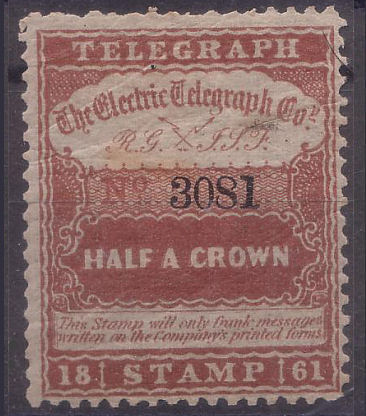 |
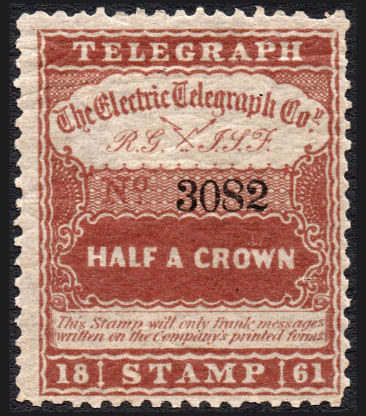 |
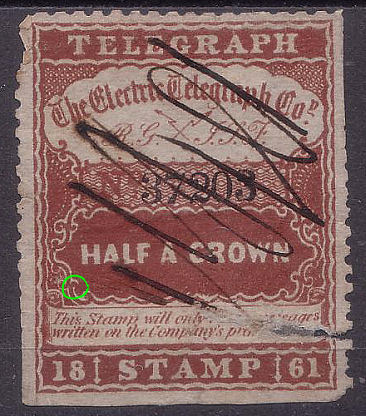 |
 |
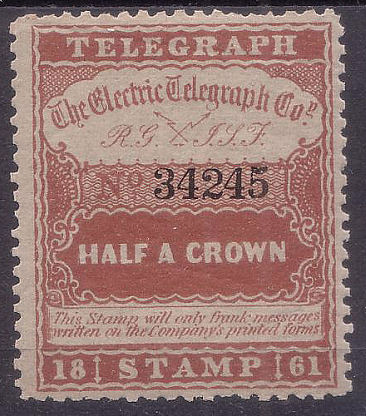 |
| 2s 6d Column 1. | 2s 6d Column 2. | 2s 6d Column 3. | 2s 6d Column 4. | 2s 6d Column 5. |
| Courtesy of Steve Lawrie. | Courtesy of Martien Blank. | Courtesy of Steve Lawrie. | Scan needed. | Courtesy of Steve Lawrie. |
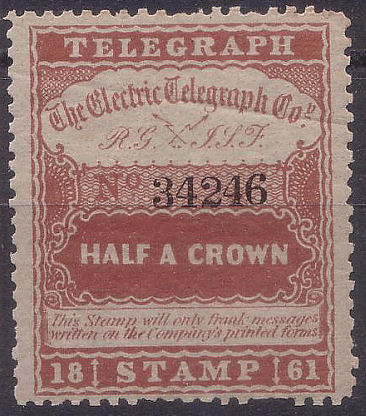 |
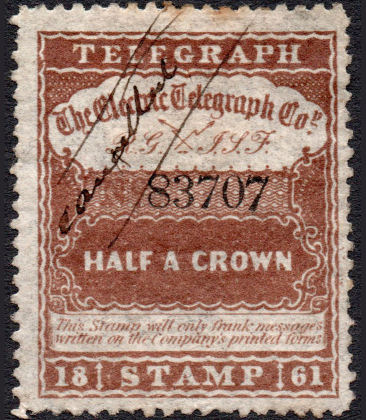 |
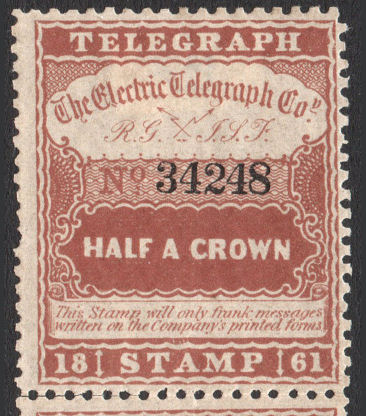 |
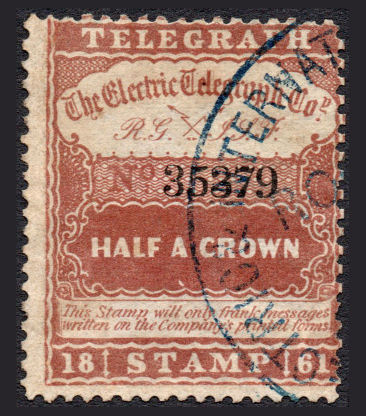 |
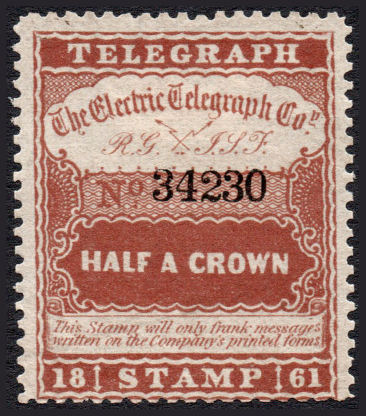 |
| 2s 6d Column 6. | 2s 6d Column 7. | 2s 6d Column 8. | 2s 6d Column 9. | 2s 6d Column 0. |
| Courtesy of Steve Lawrie. | ||||
Columns 3, 6 and 9 appear to have a flaw in common.
That may indicate the same pattern as some of the others.
I have seen control numbers in the range 3071 to 77937.
Controls from about 4100 to 4500 appear to have been affixed to Forwarded Forms 277W for a promotion of Bridport during the time of Chairman Robert Stephenson. Expect them to be without gum or with disturbed gum.
Examples outside that range are quite scarce.
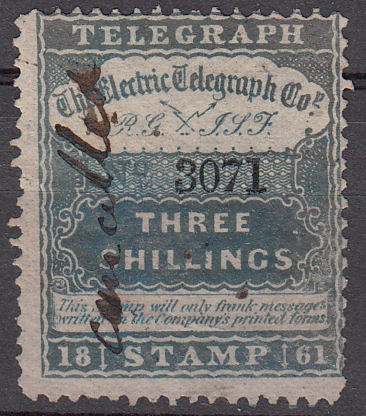 |
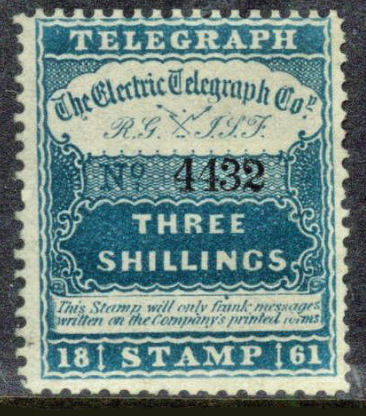 |
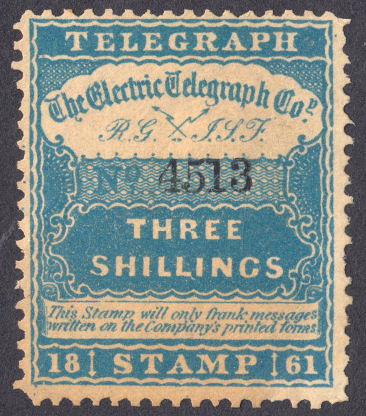 |
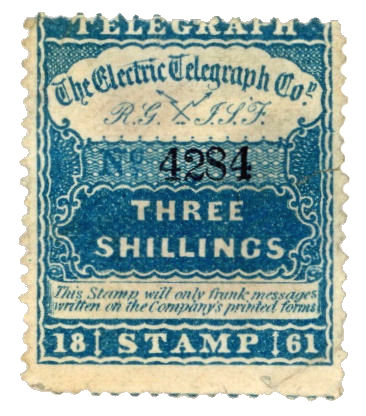 |
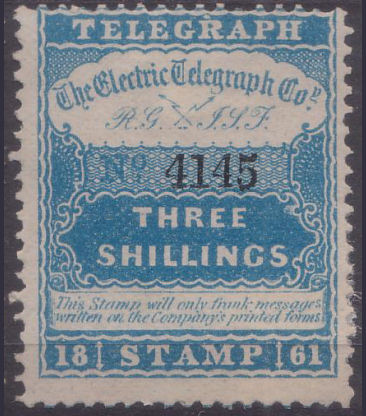 |
| 3s Column 1. |
3s Column 2. |
3s Column 3. |
3s Column 4. | 3s Column 5. |
| Courtesy of Martien Blank. | Courtesy of Roger de Lacy-Spencer. | One of mine. | Courtesy of Dr Mark Gibson. | Courtesy of Steve Lawrie. |
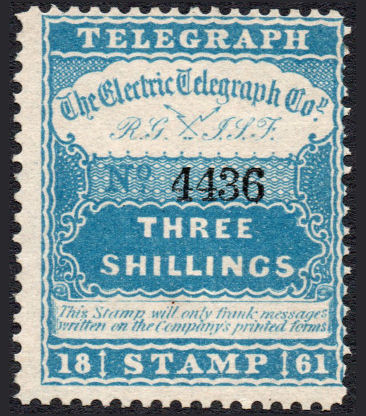 |
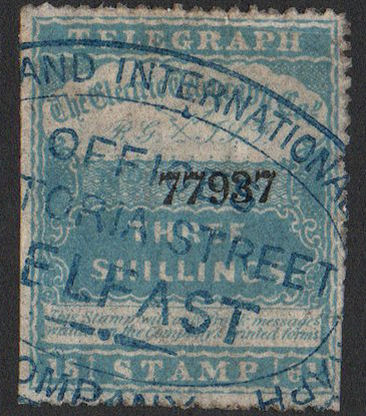 |
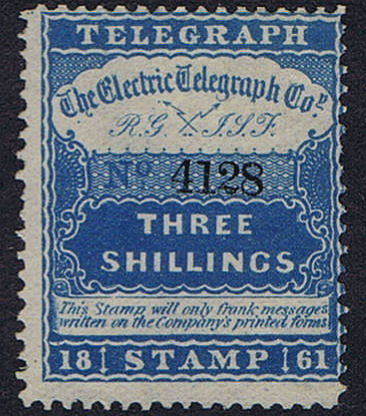 |
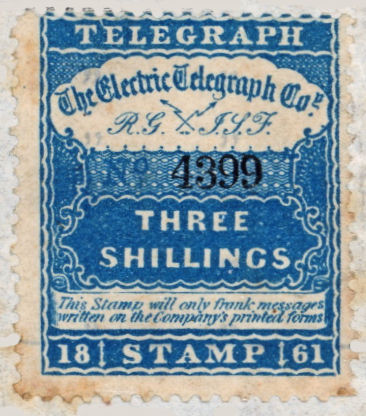 |
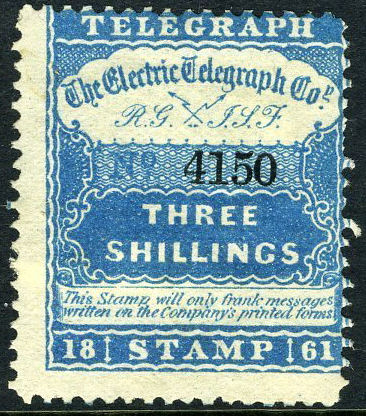 |
| 3d Column 6. |
3d Column 7. |
3d Column 8. | 3d Column 9. | 3d Column 0. |
| Courtesy of Steve Lawrie. | Courtesy of Steve Lawrie. | Anonymous | Images courtesy of Dr Mark Gibson. | Images courtesy of Dr Mark Gibson. |
| Image Courtesy of ibredguy.co.uk | Image courtesy of Steve Lawrie. | Image courtesy of Steve Lawrie. | |
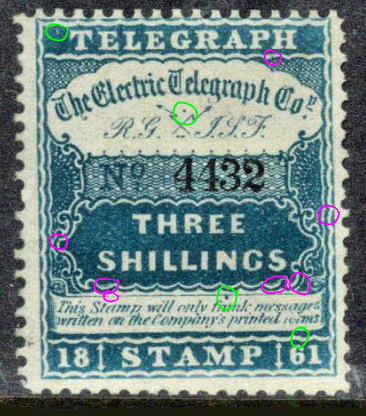 |
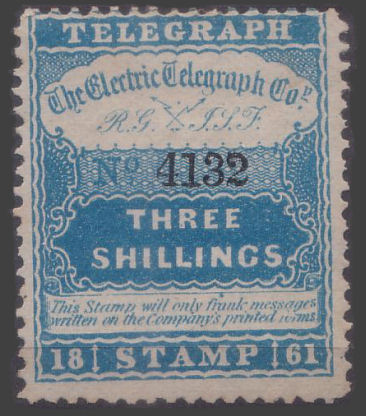 |
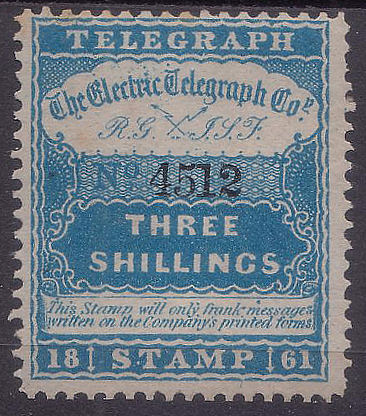 |
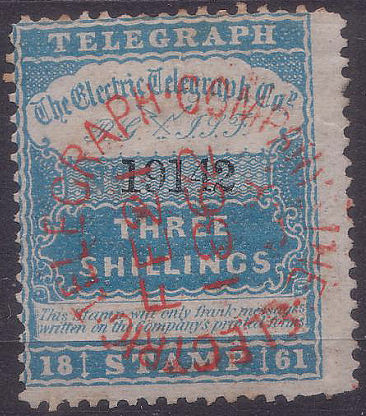 |
| These two are from the same sheet position in different sheets. The Magenta-ringed marks are common (more or less) to all the 3s stamps. The Green-ringed marks are common to the two '32's. |
These two are from the same column but different rows. They are clearly different. | ||
| Courtesy of Roger de Lacy-Spencer. | Anonymous. | Courtesy of Steve Lawrie. | Courtesy of Steve Lawrie. | Courtesy of Dr Mark Gibson. |
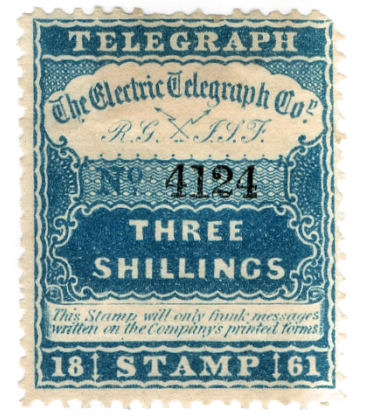 |
 |
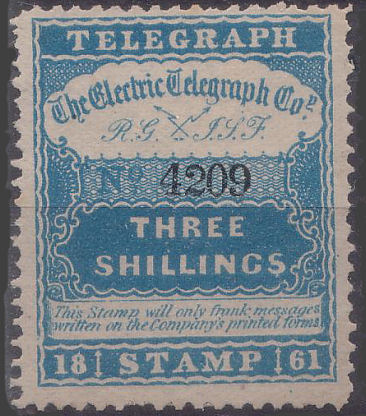 |
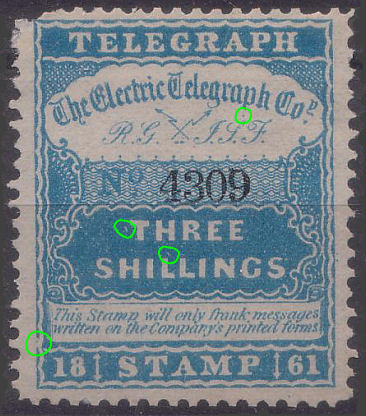 |
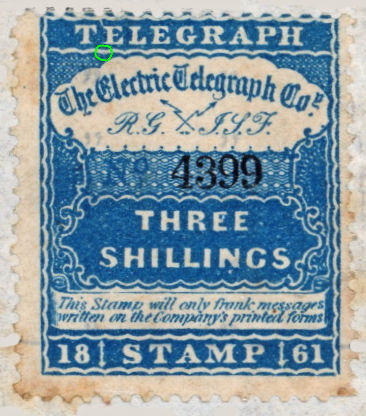 |
| These two from column-4, have nothing in common that I can see other than the normal 3s characteristics. |
The first two are from the same position on consecutive sheets. The third, while also from column-9, has little in common other than the normal 3s characteristics. I see a miniscule dot at the top, but it looks like this is faintly on others too. |
|||
All the blemishes and flaws I have found so far seem to be 'one-offs', general characteristic of all the 3s stamps or on all stamps of the same sheet position.
I have seen control numbers in the range:
Patterned control (plate 1a) 10492 to 11971.
Cleared control (plate 1b) 20458 to 104985.
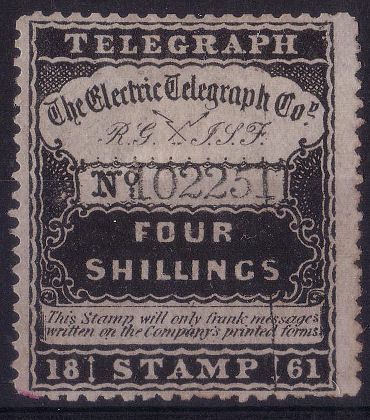 |
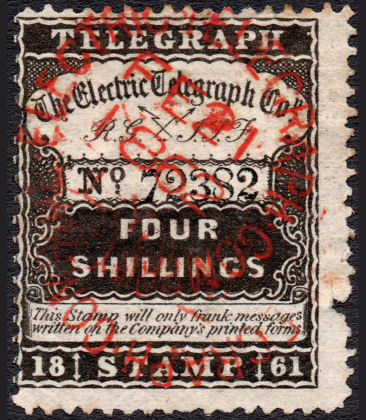 |
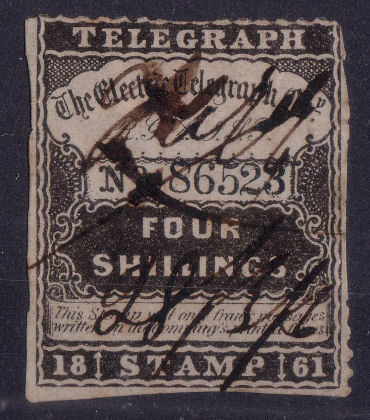 |
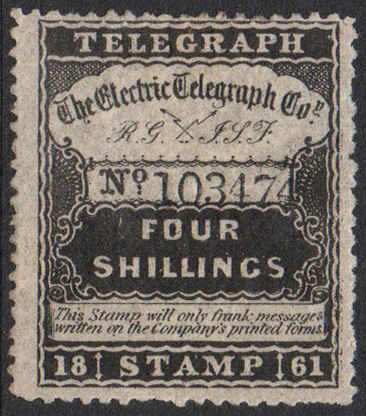 |
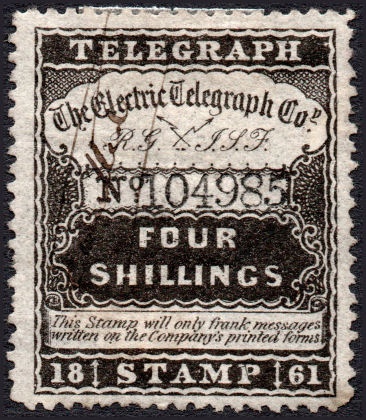 |
| Column 1. (Perf.12½) | Column 2. (Perf.12) | Column 3. | Column 4. | Column 5. |
| Image courtesy of Steve Lawrie. | Image courtesy of Steve Lawrie. | Image courtesy of Steve Lawrie. | ||
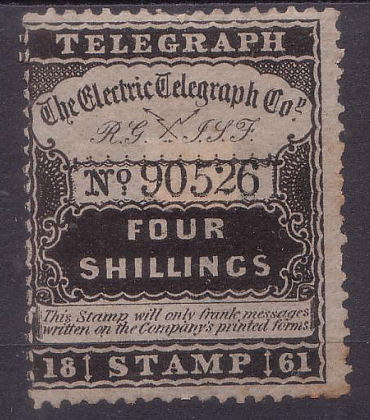 |
 |
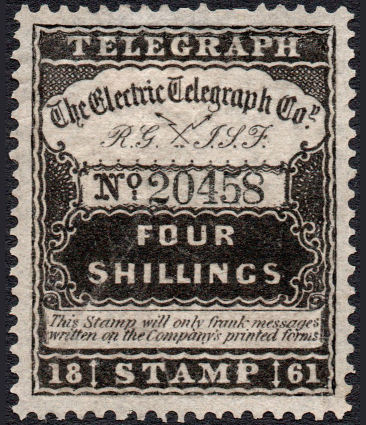 |
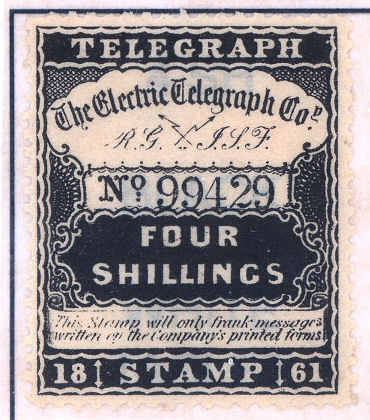 |
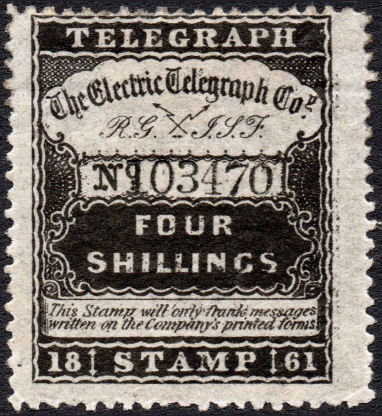 |
| Column 6. | Column 7. | Column 8. | Column 9. | Column 0. |
| Image courtesy of Steve Lawrie. | Scan needed. | Image courtesy of Steve Lawrie. | Image courtesy of Dr Mark Gibson. | Image courtesy of Steve Lawrie. |
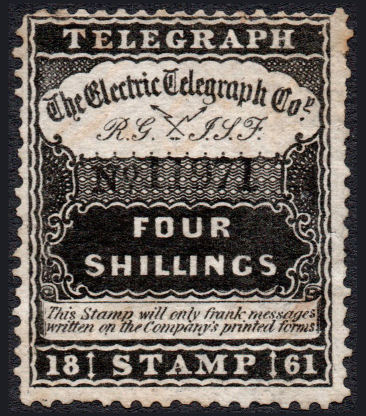 |
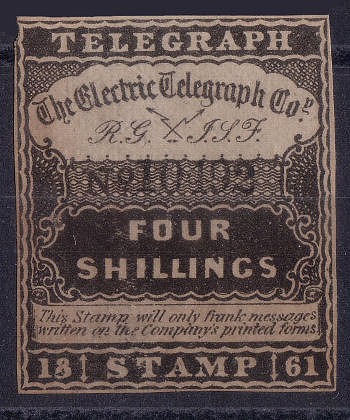 |
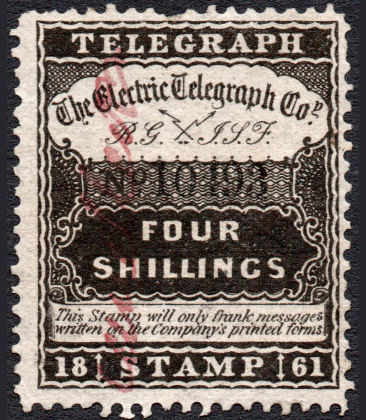 |
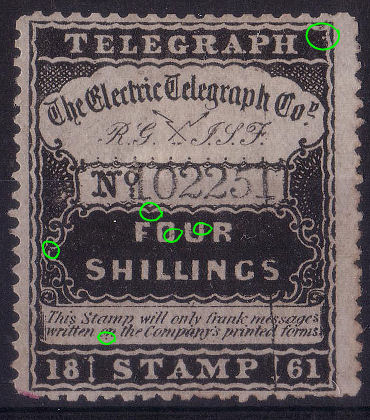 |
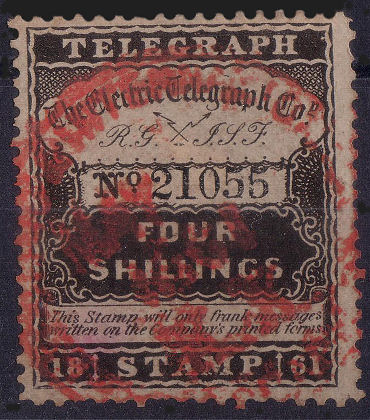 |
| There are a few plate flaws that seem to be present on all of these (with two exceptions - 20458 and 92334 are missing the top-right flaw). These need to be ignored when looking for flaws common to a particular column. The two stamps on the left show some of the same flaws, but it looks like a few were gained when the control background was cleared. 10493 is courtesy of Martien Blank. The other 3 are courtesy of Steve Lawrie. |
||||
I have seen control numbers 3750, 8806, 14169 and 18011.
 |
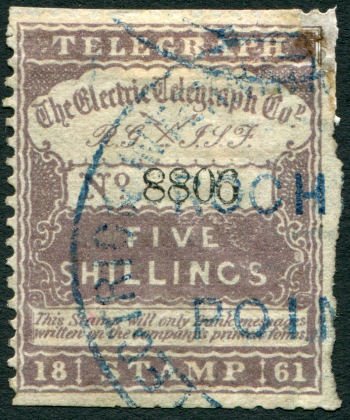 |
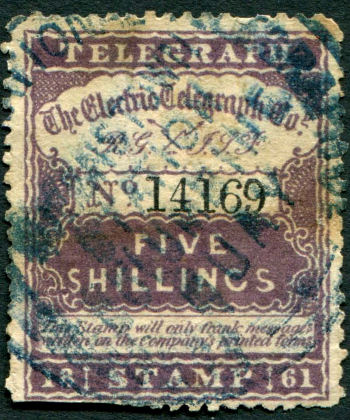 |
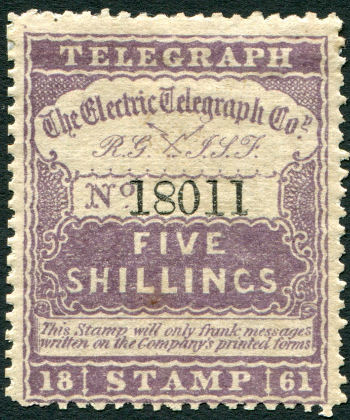 |
| 3750 Perf.12. Dated 28-3-1863 | 8806 Perf.12. (Roches Point) |
14169 Perf.12½. (Columbine Quay, Queenstown) |
18011 Perf.12½. |
| My only 4 images, courtesy of Steve Lawrie. | |||
8806 and 14169 (Columns 6 and 9) appear to have the value written the same way, with a distinctive first 'S' and 'G'.
3750 has a larger 'V' than the others.
I have seen control numbers 1335, 2795, 2902, 3982 and 3989.
If there are any Perf. 12 at all, they must be below control 1335.
Most are used at Roches Point or have manuscript 'Cancelled'.
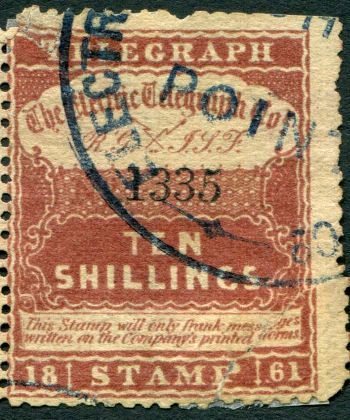 |
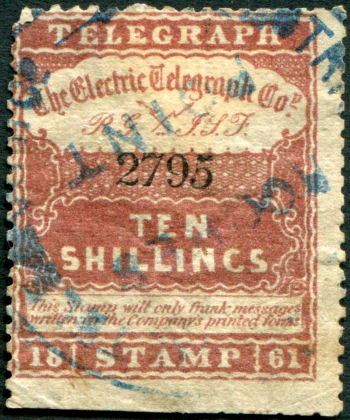 |
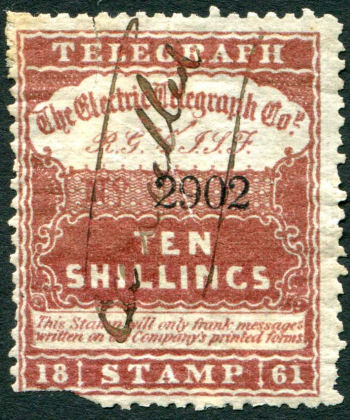 |
 |
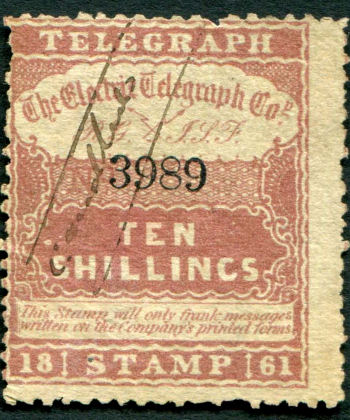 |
| 1335 Perf.12½. (Roches Point) |
2795 Perf.12½. (Roches Point) |
2902 Perf.12½. | 3982 Perf.12½. | 3989 Perf.12½. |
| Images courtesy of Steve Lawrie. | Anonymous image. | Image courtesy of Steve Lawrie. | ||
In 1864 Henry Weaver became the secretary and the initials were changed to 'R.G.' and 'H.W.' accordingly.
Initially Perf.12½ still, then in 1866 the perforations were changed again to Perf.10
Hiscocks lists Perf.11½ also for the 6d and 1s as H53 and H54. L&H does not list these.
Langmead & Huggins say "The highest serial numbers recorded for the RG/HW issues are: 6d 269885; 1s 707907." Here are some a little higher.
| 3d Perf.12½ Hiscocks RH32 | 6d Perf.12½ Hiscocks RH43 | 1s Perf.10 Hiscocks RH49 | 1s6d Perf.10 Hiscocks RH50 |
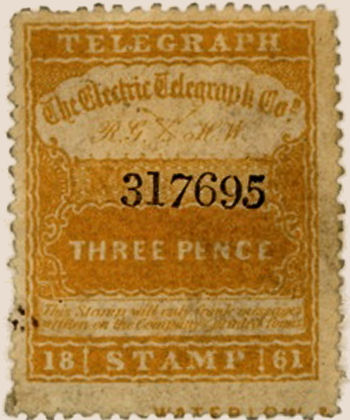 |
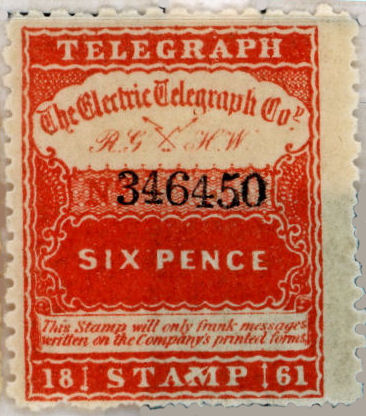 |
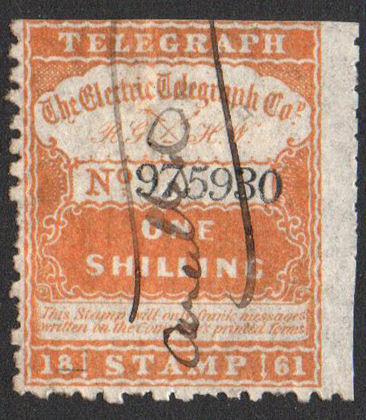 |
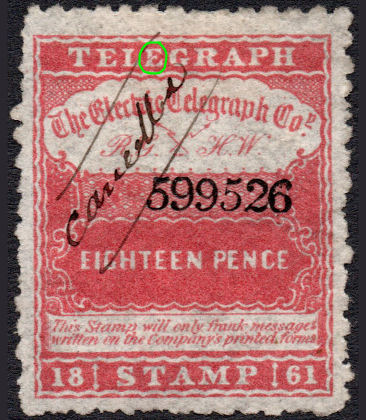 |
 Part of the 'Waterlow' imprint at the bottom (courtesy of Dr Mark Gibson). |
1s Perf.10 Hiscocks RH49 | 1s6d Perf.10 Hiscocks RH50 | |
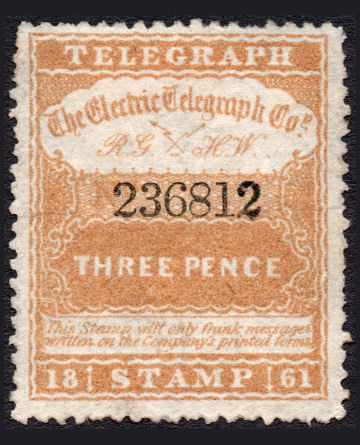 |
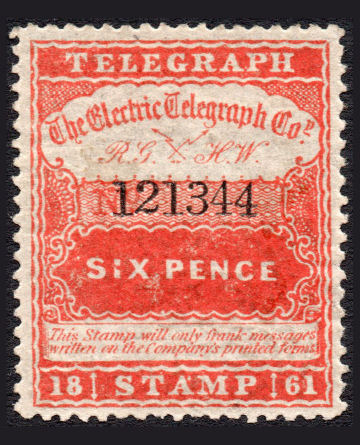 |
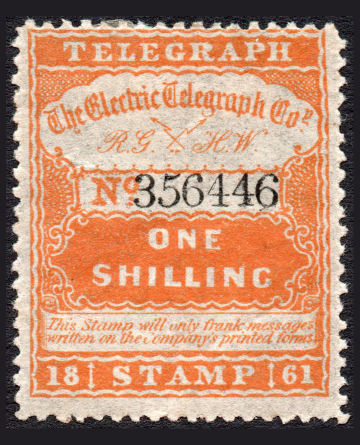 |
| 3d. Perf.12½ Hiscocks RH42 | 6d. Perf.12½ Hiscocks RH43 | 1s. Perf.12½ Hiscocks RH44 |
| Images courtesy of Steve Lawrie | ||
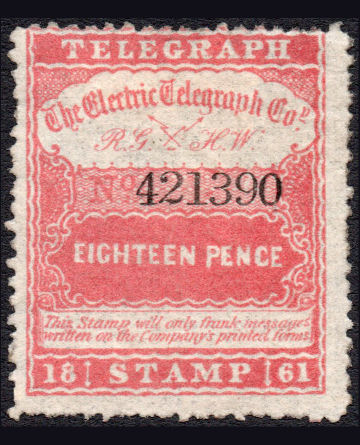 |
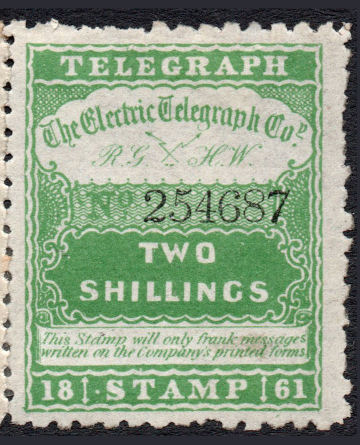 |
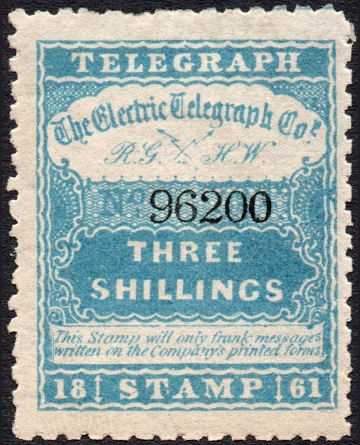 |
| 1s6d. Perf.12½ Hiscocks RH45 | 2s. Perf.10 Hiscocks RH51 | 3s. Perf.10 Hiscocks RH52 |
| Images courtesy of Steve Lawrie | ||
| RG/HW Description |
Perf.12½ | Perf.10 | Perf.11½ | ||||||||||||
|---|---|---|---|---|---|---|---|---|---|---|---|---|---|---|---|
| RH # | Hisc. | Rarity | Mint | Used | RH # | Hisc. | Rarity | Mint | Used | RH # | Hisc. | Rarity | Mint | Used | |
| 3d Buff | RH42 | H42 | R1 | 30.00 | 50.00 | RH47 | H47 | R2 | 40.00 | 60.00 | |||||
| 6d Scarlet | RH43 | H43 | R1 | 25.00 | 50.00 | RH48 | H48 | R2 | 50.00 | 60.00 | RH53 | H53 | Unlisted | 100.00 | - |
| 1s Orange | RH44 | H44 | R2 | 30.00 | 50.00 | RH49 | H49 | R1 | 40.00 | 60.00 | RH54 | H54 | Unlisted | 100.00 | - |
| 1s6d Rose | RH45 | H45 | R1 | 50.00 | - | RH50 | H50 | R2 | 65.00 | - | |||||
| 2s Green. | RH46 | H46 | R1 | 65.00 | - | RH51 | H51 | R2 | 70.00 | - | |||||
| 3s Blue | RH52 | H52 | R2 | 70.00 | - | ||||||||||
Used prices for stamps cancelled as shown below.
Hiscocks lists (unpriced) a H44a with the description "as for No. 34(a) but with 'A' partially removed" !
This makes no sense as it implies that the RG/HW 1s was produced from the RG/JSF 1s Plate 3c, but it was not, the flaws are different.
Similarly it was not produced from RG/JSF 1s plate 1 or 2 either (yes, I did check).
Perhaps the report comes from a stamp with marks in that area?
I have also not (yet) seen H53, but I have seen a H54.
| RG/HW Description |
Perf. 12½ x 11½ | ||||
|---|---|---|---|---|---|
| RH # | Hisc. | Rarity | Mint | Used | |
| 1s6d Rose. | RH45a | H45a | Unlisted | - | - |
I have not seen H45a. Anyone have a scan of H45a?
Walter Morley writing in the Fiscal Philatelist, March 1893, Acknowledges the Perf 10 and 12½ but not 11½ or 12½ x 11½.
He does however also list the following:
| Perf. 9½ | 3d, 6d, 1s, 2s |
| Perf. 10½ | 6d, 2s |
| Perf. 12 | 1s |
| Perf. 13 | 1s |
Clearly some differences of opinion here!
I think perhaps it was caused by the perforations still being rather unevenly spaced and often very rough, coupled with rounding to the nearest ½.
It is also possible there may be some scarce perforation varieties unrecognised in collections.
You might want to check yours.
| Shortcuts to different RG / HW value details | |||||
| 3d | 6d | 1s | 1s6d | 2s | 3s |
I have seen control numbers in the range 195945 to 384908.
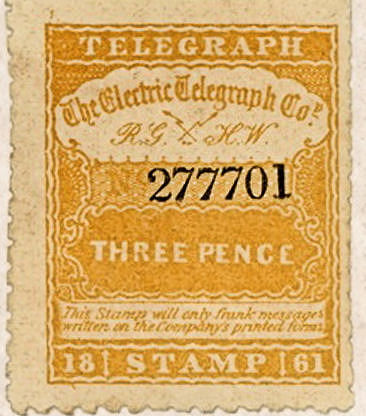 |
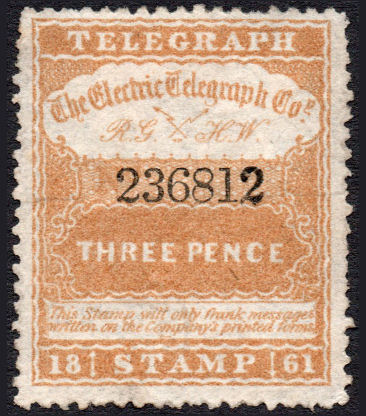 |
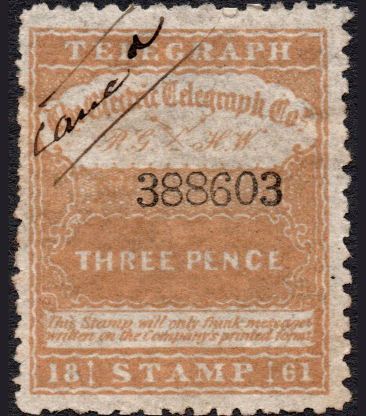 |
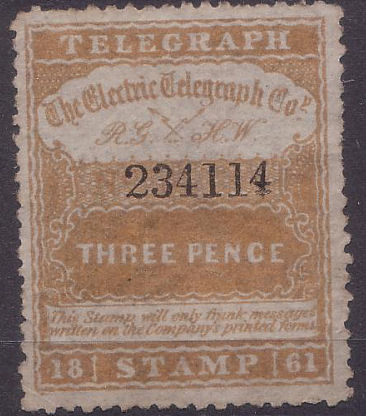 |
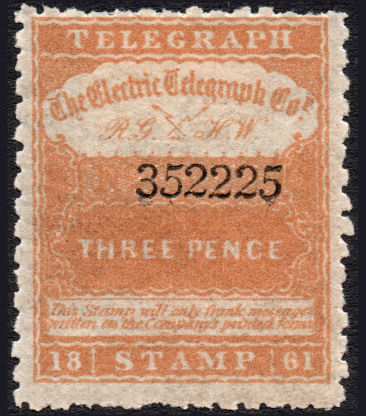 |
| 3d Column 1, |
3d Column 2, |
3d Column 3 |
3d Column 4, | 3d Column 5, |
| Image courtesy of Dr Mark Gibson. | Images courtesy of Steve Lawrie. | |||
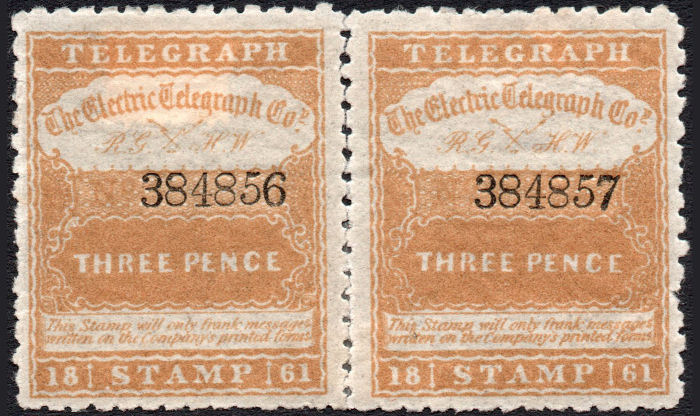 |
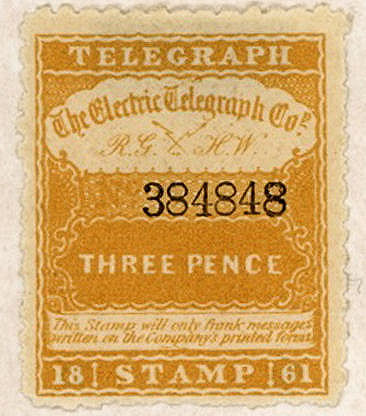 |
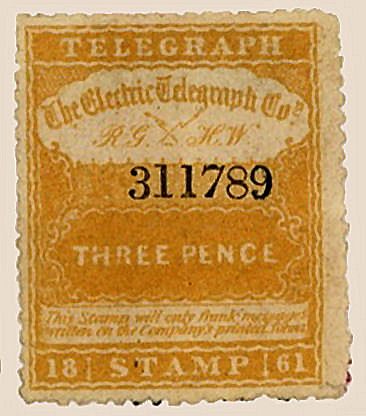 |
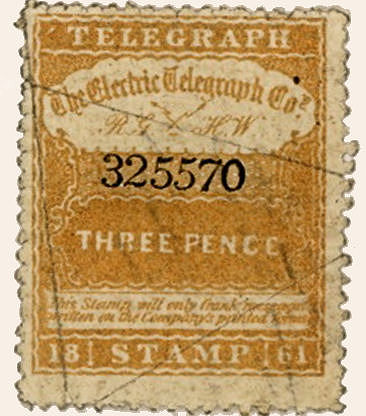 |
|
| 3d Column 6, |
3d Column 7, |
3d Column 8, | 3d Column 9, | 3d Column 0, |
| Image courtesy of Steve Lawrie. | Images courtesy of Dr Mark Gibson. | |||
Columns 1, 4, 7 and 0 have shared characteristics and
Columns 2, 5 and 8 have shared characteristics.
Columns 3, 6 and 9 have shared characteristics.
| Columns 1, 4, 7 and 0 | Columns 2, 5 and 8 | Columns 3, 6 and 9 | ||
|
1) Mark across left limb of the 'T' in 'TELEGRAPH'. 2) The left leg of the 'R' in 'THREE' is distorted. 3) Frame-breaks under first 'E' in 'THREE' . |
1) The bottom left corner of 'T' in 'TELEGRAPH' is shaded. 2) 3 frame-breaks under 'THR' in 'THREE' . 3) Frame-break above 'S' in 'STAMP' . |
1) White triangle in value tablet. 2) Frame-breaks under value. |
||
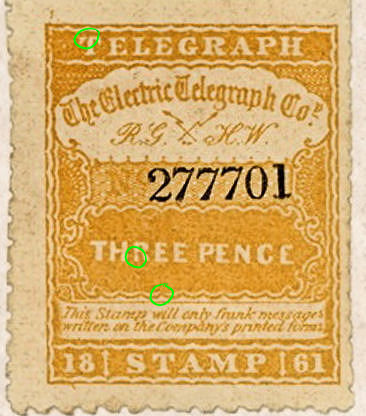 |
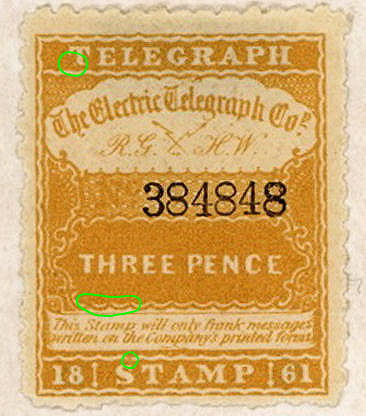 |
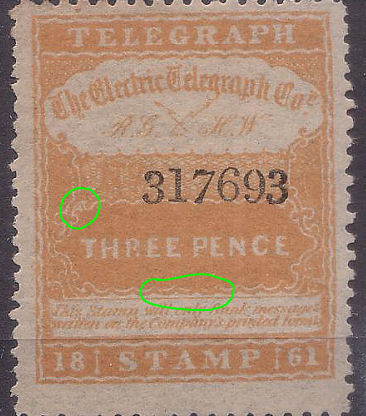 |
||
| Image courtesy of Dr Mark Gibson. | Image courtesy of Dr Mark Gibson. | Image courtesy of Steve Lawrie. |
This follows the pattern:
| 1 | 2 | 3 | 4 | 5 | 6 | 7 | 8 | 9 | 0 |
I have seen control numbers in the range 50410 to 346450.
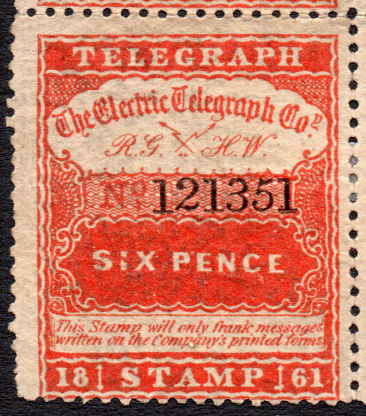 |
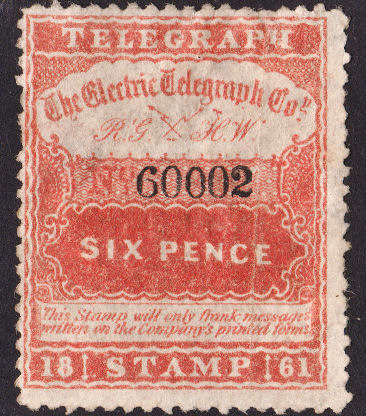 |
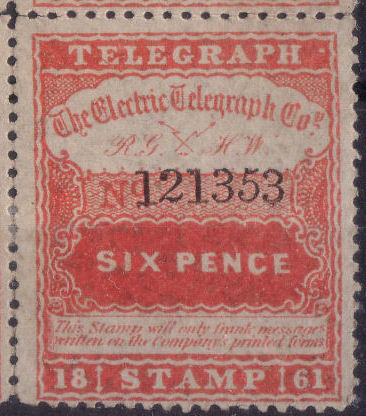 |
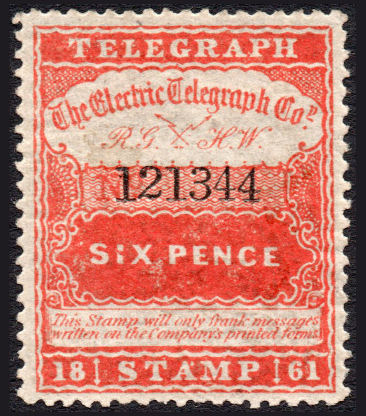 |
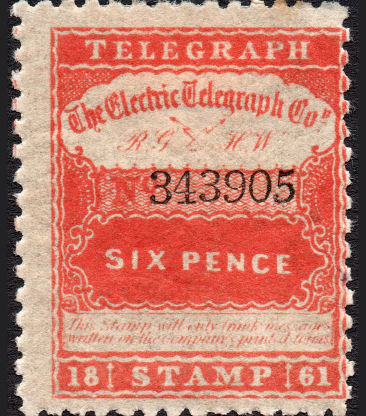 |
| 6d Column 1. Perf.10 |
6d Column 2. Perf. 12½ |
6d Column 3. Perf. 12½ |
6d Column 4. Perf.10 | 6d Column 5. Perf.10 |
| Image courtesy of Steve Lawrie. | One of mine | Image courtesy of Steve Lawrie. | Image courtesy of Steve Lawrie. | Image courtesy of Steve Lawrie. |
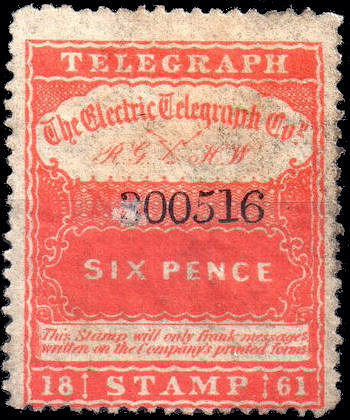 |
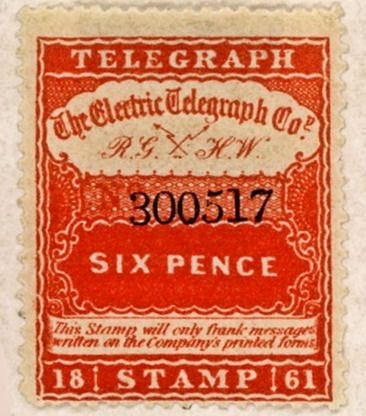 |
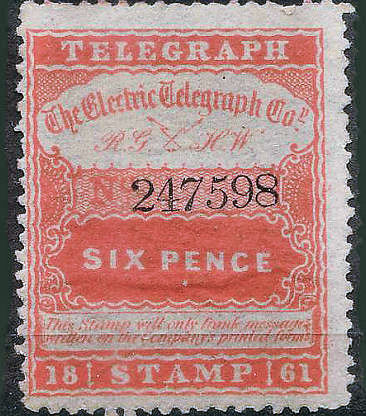 |
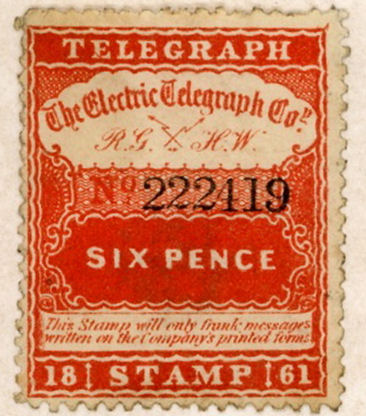 |
 |
| 6d Column 6, (slightly different shade to it's neighbour on the right !). Perf. 12½ |
6d Column 7. Perf. 12½ |
6d Column 8. Perf. 12½ | 6d Column 9. Perf. 12½ | 6d Column 0. Perf.10 |
| Anonymous. | Image courtesy of Dr Mark Gibson. | Image courtesy of Steve Lawrie. | Image courtesy of Dr Mark Gibson. | Image courtesy of Dr Mark Gibson. |
| Here I have found a pattern that : Columns 1, 4, 7 and 0 have shared characteristics, Columns 2, 5 and 8 have shared characteristics and Columns 3, 6 and 9 have shared characteristics. |
| Columns 1, 4, 7, 0 | Columns 2, 5 and 8 | Columns 3, 6 and 9 | ||
|
1) Frame break above first 'E' of 'TELEGRAPH'. 2) Frame break above left of 'A' in 'TELEGRAPH'. 3) Frame break below 'G' in 'TELEGRAPH'. 4) Frame weak above '1' of '18' bottom left. 5) 'Intrusion' under 'd' of 'printed' |
1) Frame break above 'NC' of 'PENCE'. 2) Small frame break below 'P' of 'PENCE'. |
1) Diagonal line through first 'E' of 'TELEGRAPH'. 2) Frame break below right of 2nd 'E' of 'PENCE'. |
||
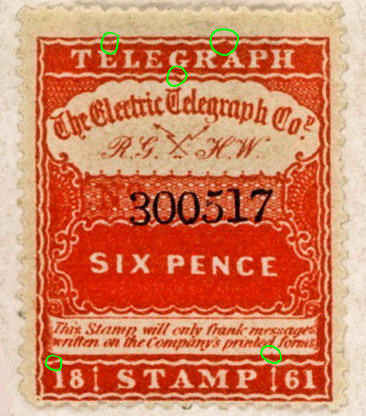 |
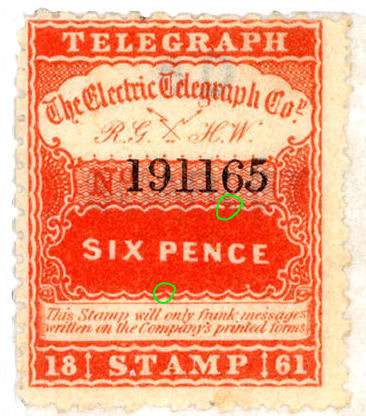 |
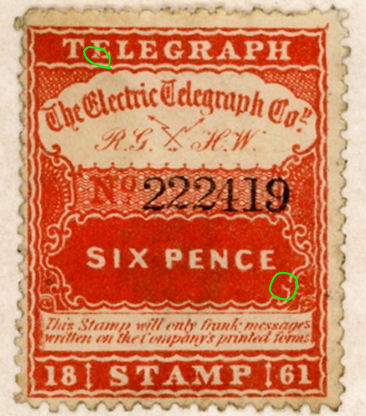 |
||
| Images courtesy of Dr Mark Gibson. | ||||
This follows the pattern:
| 1 | 2 | 3 | 4 | 5 | 6 | 7 | 8 | 9 | 0 |
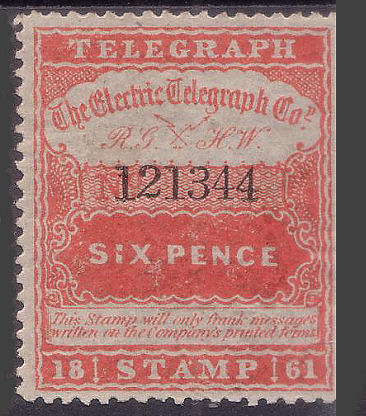
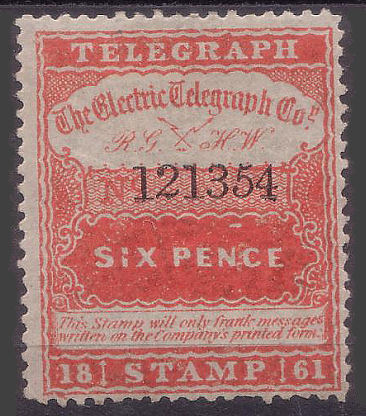
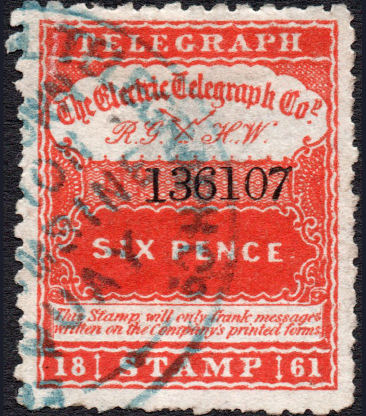
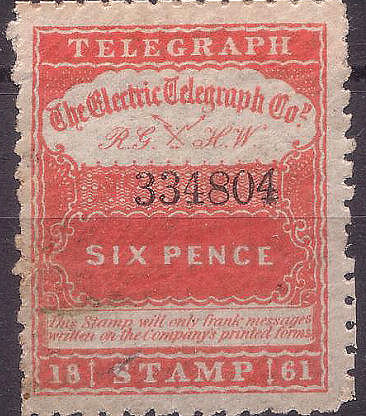
To add a bit of complication, here are four from the {1, 4, 7, 0} group, three have the broken ' I '.
It can be seen also on 50410, 121341 and 121351 above, but is not on 228350, 272541, 300517, 300501, 300520, 334804 or 346450.
The only explanation I can think of is that the flaw was noticed and the plate repaired somewhere between 136107 and 228350.
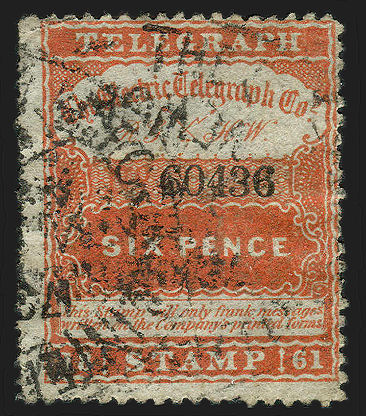

60436 courtesy of victoire1 on ebay,
together with a much later one also from column-6 showing the same flaws as shown above.
I have seen control numbers in the range 4919 to 975930
The 3d and 6d stamps did not reach the end of the counter. The sequence shows that perf.12½ came first, followed by perf.10
For the 1s the, perf.12½ transition to perf.10 seems to have vacillated about the time the counter reached the end. This complicates things.
There are also perf.11½ stamps, listed by Hiscocks (following Lister) but not listed by Langmead & Huggins. One known and illustrated.
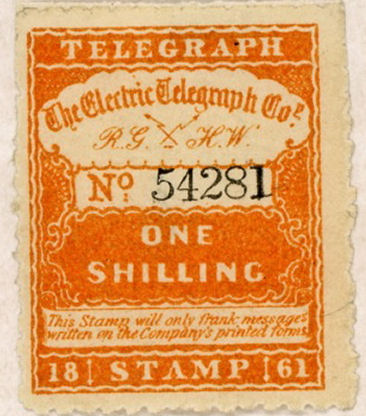 |
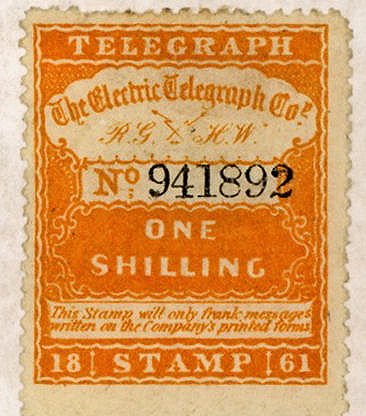 |
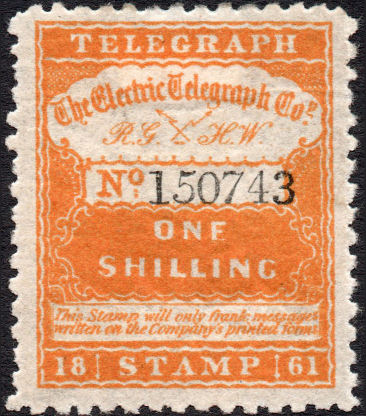 |
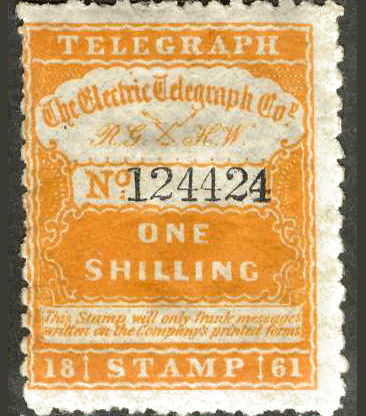 |
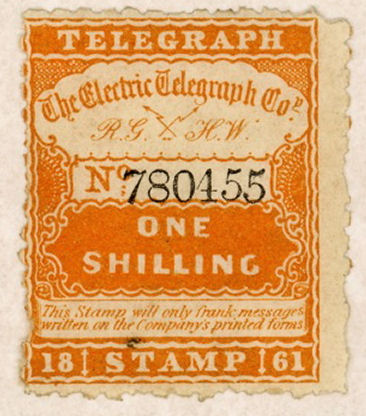 |
| 1s Column 1 (perf.10) |
1s Column 2 (perf.12½) |
1s Column 3 (perf.10) |
1s Column 4 (perf.10) | 1s Column 5 (perf.10) |
| Image courtesy of Dr Mark Gibson. | Image courtesy of Dr Mark Gibson. | Image courtesy of Steve Lawrie. | Anonymous. | Image courtesy of Dr Mark Gibson. |
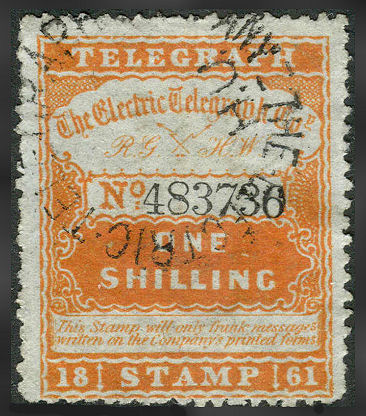 |
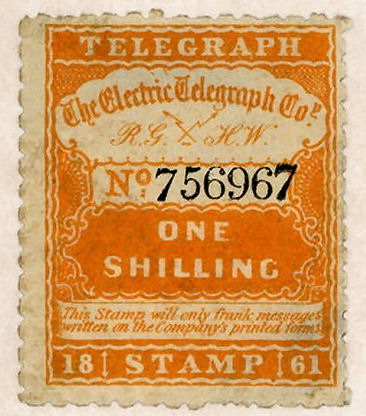 |
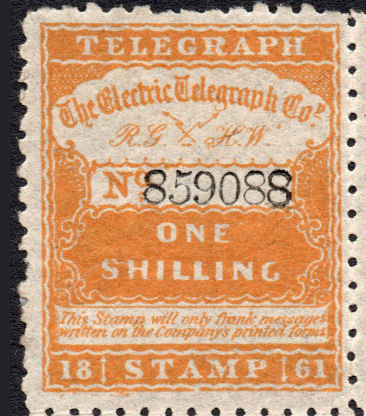 |
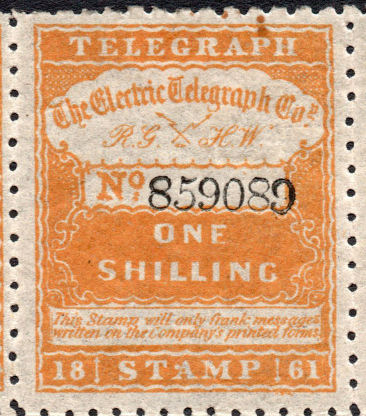 |
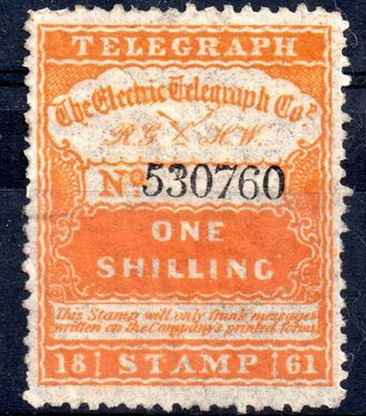 |
| 1s Column 6 (perf.12½) | 1s Column 7 (perf.10) | 1s Column 8 (perf.10) | 1s Column 9 (perf.10) | 1s Column 0 (perf.12½) |
| Image courtesy of victoire1 on ebay. | Image courtesy of Dr Mark Gibson. | Image courtesy of Steve Lawrie. | Image courtesy of Steve Lawrie. | Image courtesy of Dr Mark Gibson. |
Here there are similar patterns:
Columns 1, 4, 7 and 0 have shared characteristics and
Columns 2, 5 and 8 have shared characteristics.
Columns 3, 6 and 9 have shared characteristics.
| Columns 1, 4, 7, 0 | Columns 2, 5, 8 | Column 3, 6 and 9 | |
|
1) The top point of 'G' in 'SHILLING' is cracked. 2) A 'tail' hangs from the right of the 'A' in 'TELEGRAPH'. 3) Frame-break below-left 'S' in 'SHILLING'. 4) Frame-break below first 'I' in 'SHILLING'. 5) Frame-break below 'o' in 'No' of control tablet. 6) Extra dot above 'i' of 'Electric'. |
1) The top point of 'G' in 'SHILLING' is broken off. 2) Protrusion inward from frame left of 'N' of 'No' in control. 3) Protrusion outside stamp below '18' in bottom left corner . 4) Frame damage under 'S' and 'G' in 'SHILLING'. |
1) The top point of 'G' in 'SHILLING' is intact. 2) Protrusion inward from frame left of 'N' of 'No' in control. 3) Weakness of white frame to left of '18'. |
Shown for a comparison of perforations, being the only scan I have of perf. 11½. Expect more examples around control number 87369. But notice also, this is a column 2/5/8 stamp, not column 9 !!! |
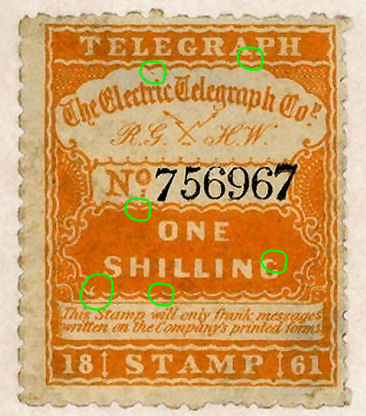 |
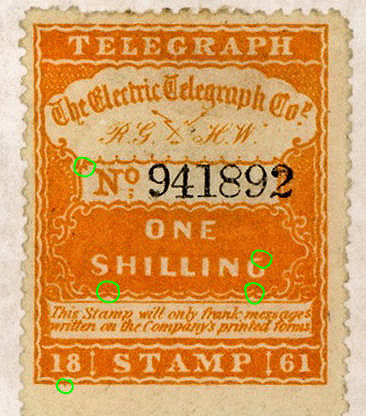 |
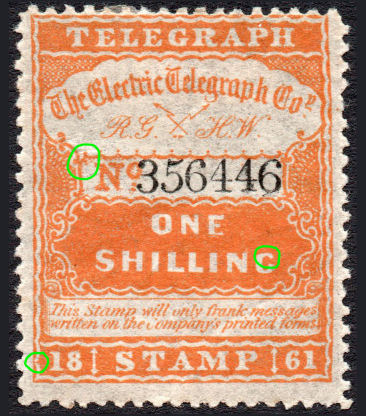 |
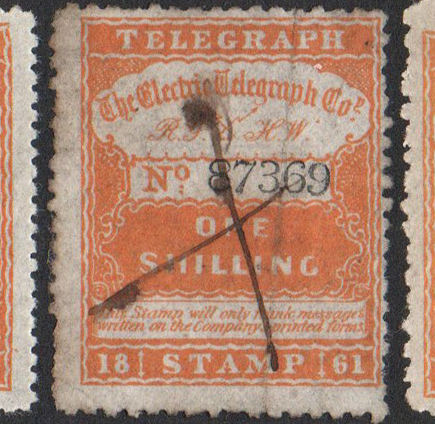 |
| Perf. 10 | Perf. 12½ | Perf. 12½ | Perf. 12½ Perf. 11½ Perf. 10 |
| Image courtesy of Dr Mark Gibson. | Image courtesy of Dr Mark Gibson. | Image courtesy of Steve Lawrie. | Perforation comparisons, images courtesy of Steve Lawrie. |
Substituted clichés.
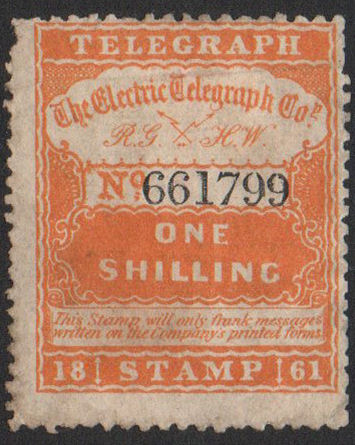 |
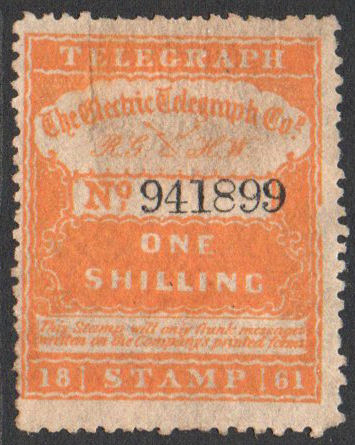 |
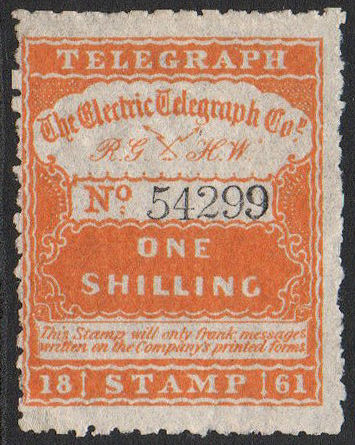 |
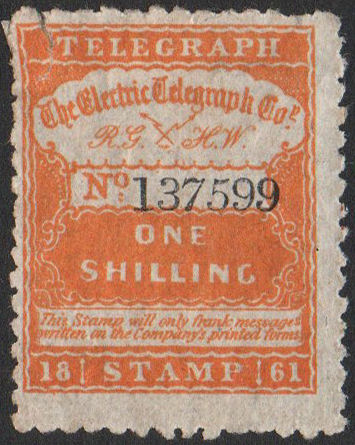 |
| Perf. 12½ - Position 99 on the bottom row. These are both, correctly column 3, 6, 9 stamps, but 941899 has developed a broken frame on the right side. It is from sheet 9418, near the end of its count. |
Perf. 10 - presumably due to the damage, this impression has been replaced by a new one, but this is not a column 9 type, it is the type expected in column 2, 5 or 8. The bottom row tends to have longer stamps. It was also vulnerable. |
||
I had five lucky scans of the 99 position, but for the last on the row, 00, I only have two, one in the block further below.
This block, when taken with the above, provides interesting results.
This block, shows an earlier state than the ones above, but is Perf.10 with much higher control numbers. Clearly the numbers are not a good guide to chronology.
It also adds 90 to the list of substituted clichés. It must have been done earlier. There appears to be no attempt to replace a cliché with the appropriate type.
They were probably considered to be all equivalent. In any repair operation, probably the same type was used to replace all that needed replacing.
Statistically, a replacement would be the correct type one third of the time and therefore less easy to spot.
Therefore there are probably 50% more substituted clichés than will be easily noticed. Some may be replaced more than once.
135300 can be seen above. It is a substitute, but is it later, or an earlier one that got substituted again?
Positions 45 and 46.
As has been mentioned, a cliché may be substituted for another of the correct type.
Here are some from position 83.
Here are a couple from the next position, 85.
Here are a few others with substituted clichés for which I cannot show you the earlier states.
There is a pattern here. Coincidence ?
As yet, I do not have many scans of the RG/HW higher values.
I have scans in the range 124357 to 599526.
The perforations on these are :
Hiscocks also lists a Perf. 12½ x 11½ type.
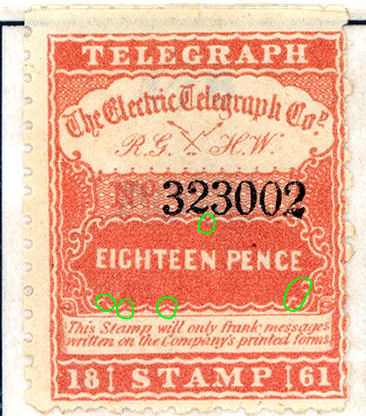 |
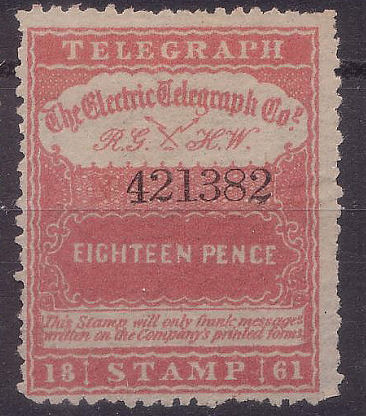 |
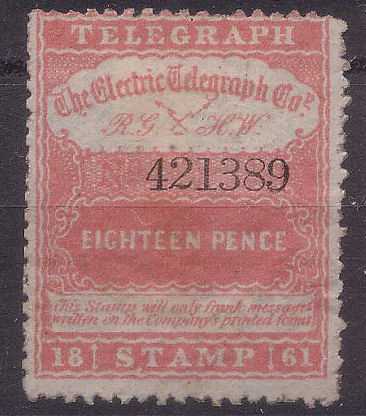 |
| Perf.10 courtesy of Dr Mark Gibson. | Perf.12½ courtesy of Steve Lawrie. | Perf.12½ courtesy of Steve Lawrie. |
The two column-2 stamps appear to have some shared flaws that are not on the column-9 stamp.
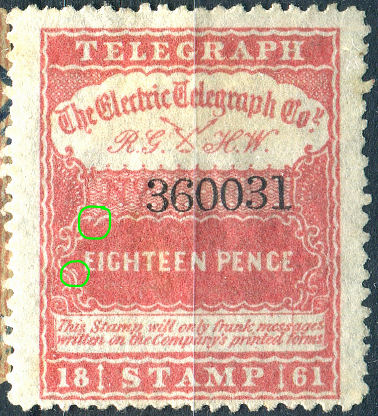 |
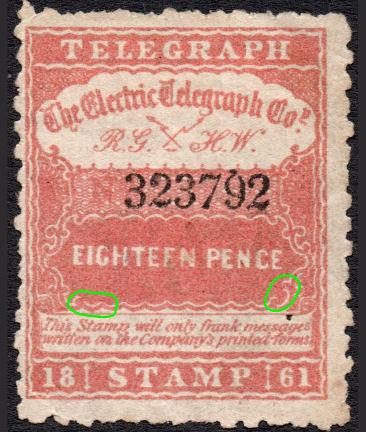 |
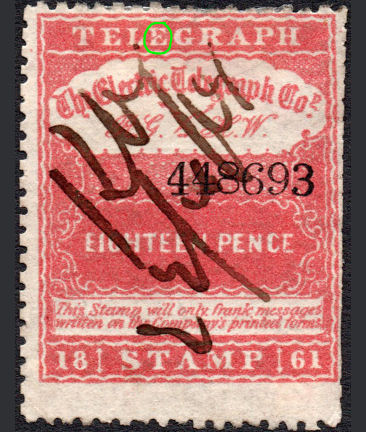 |
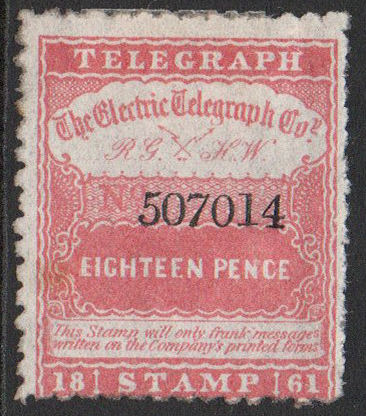 |
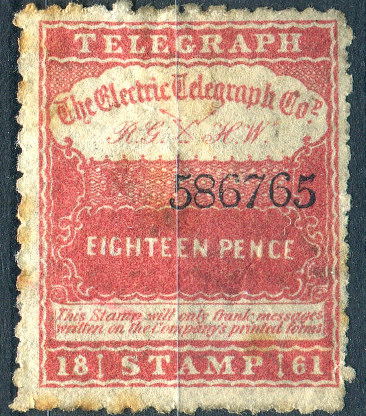 |
| Column 1 - Perf. 12½ | Column 2 - Perf.10 - Like Col-5, 8 and 0 | Column 3 - Perf.12½ - Broken 'E' in 'TELEGRAPH' | Column 4 - Perf. 10- Like Col-1 | Column 5 - Perf. 10 - Like Col-2, 8 and 0 |
| Ex Iain Stevenson, courtesy of Grosvenor Auctions. | courtesy of Steve Lawrie. | courtesy of Steve Lawrie. | courtesy of Steve Lawrie. | Ex Iain Stevenson, courtesy of Grosvenor Auctions. |
 |
 |
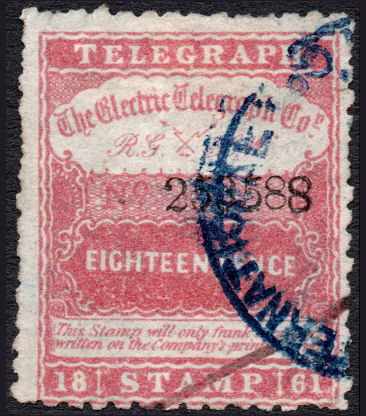 |
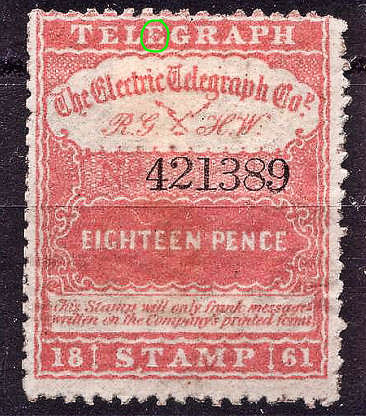 |
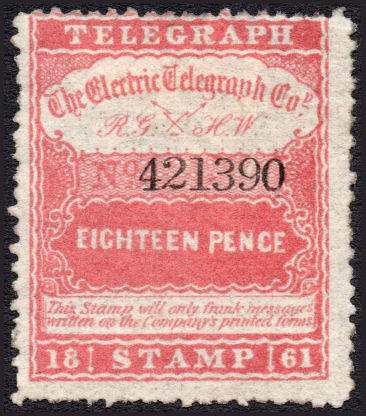 |
| Column 6 - Perf. 10 - Like Col-3 and 9 | Column 7 | Column 8 - Perf. 10 - Like Col-2, 5 and 0 | Column 9 - Perf.12½ - Like Col-3 and 6 | Column 0 - Perf.12½ - Like Col-2, 5 and 8 ! |
| Highest number courtesy of Steve Lawrie. | Need Scan. | Lowest perf.10 number seen, courtesy of Steve Lawrie.. | courtesy of Steve Lawrie. | courtesy of Steve Lawrie. |
This is also a transfer group of three, but strangely the zero position matches columns 2, 5 and 8 !
{1, 4, 7}, {2, 5, 8, 0}, {3, 6, 9}.
This follows the pattern:
| 1 | 2 | 3 | 4 | 5 | 6 | 7 | 8 | 9 | 0 |
I have scans in the range 145452 to 286394.
Hiscocks also lists a Perf. 12½ x 11½ type.
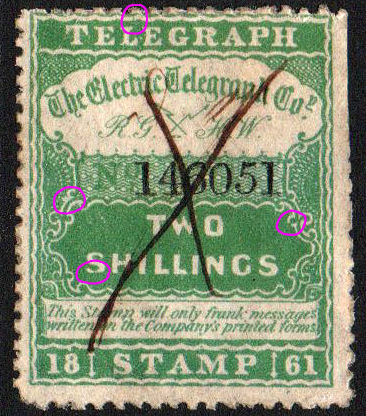 |
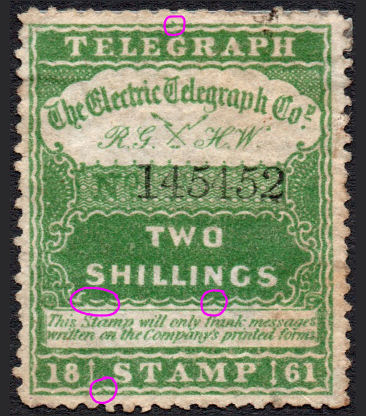 |
 |
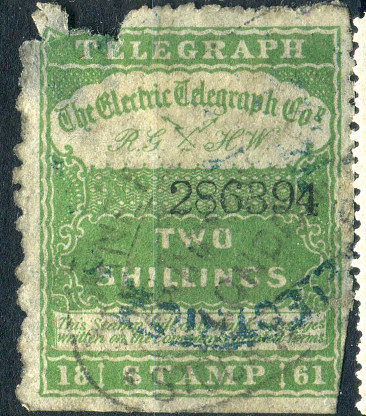 |
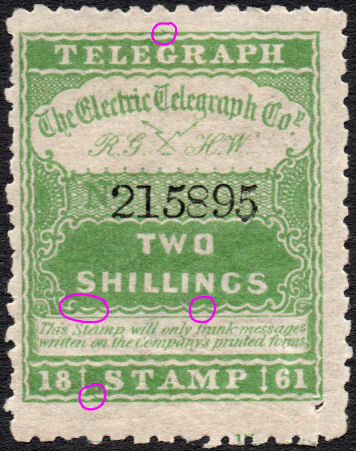 |
| Column 1 - Perf. 12½ | Column 2 - Perf. 12½ | Column 3 | Column 4 - Perf. 10 | Column 5 - Perf. 10 |
| courtesy of Steve Lawrie. | Ex Iain Stevenson, courtesy of Grosvenor Auctions. | Need Scan. | Ex Iain Stevenson, courtesy of Grosvenor Auctions. | courtesy of Steve Lawrie. |
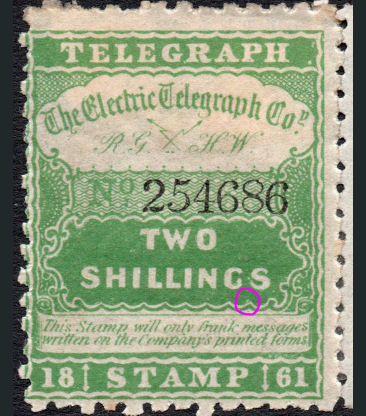 |
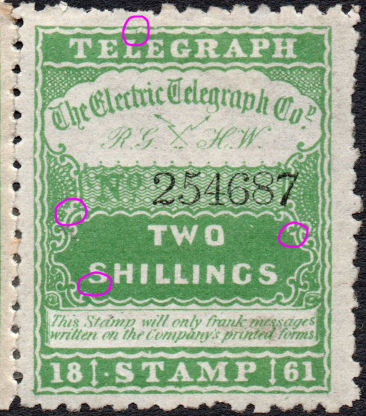 |
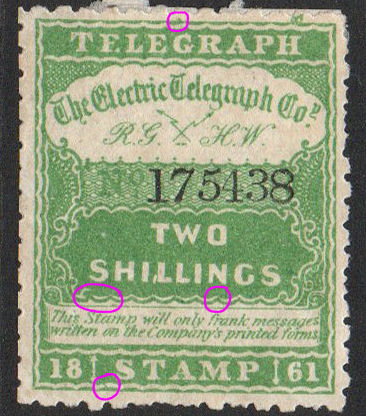 |
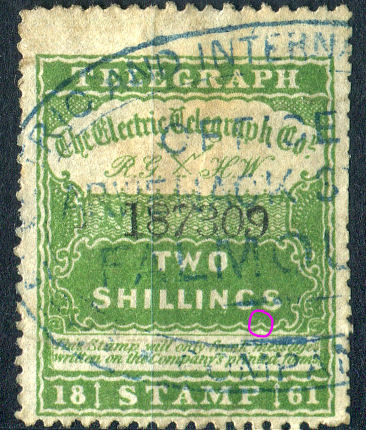 |
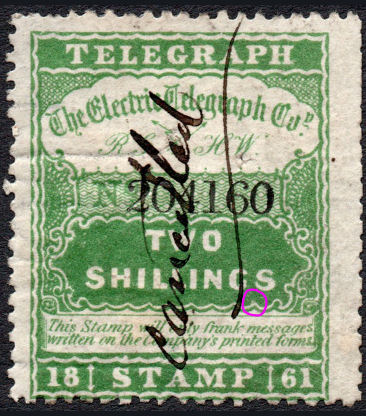 |
| Column 6 - Perf. 12½ | Column 7 - Perf. 10 | Column 8 - Perf.10 | Column 9 - Perf.12½ x Perf.12¾ | Column 0 - Perf.12½ |
| courtesy of Steve Lawrie. | courtesy of Steve Lawrie. | courtesy of Steve Lawrie. | Ex Iain Stevenson, courtesy of Grosvenor Auctions. | courtesy of Steve Lawrie. |
The 2s also has a transfer block of 3, but this time the 0 column pars with 9 rather than 1.
We have {147}, {258}, {3690}.
This follows the pattern:
| 1 | 2 | 3 | 4 | 5 | 6 | 7 | 8 | 9 | 0 |
I have 8 scans in the range 73249 to 107208, all Perf.10.
If Perf. 12½
exists, it must have controls below 73201.
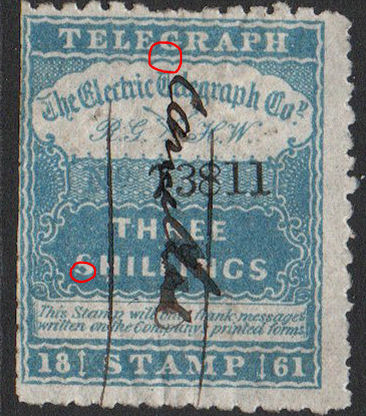 |
 |
 |
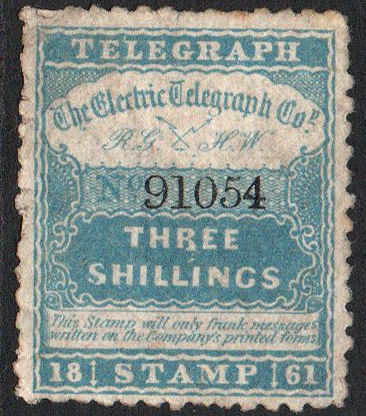 |
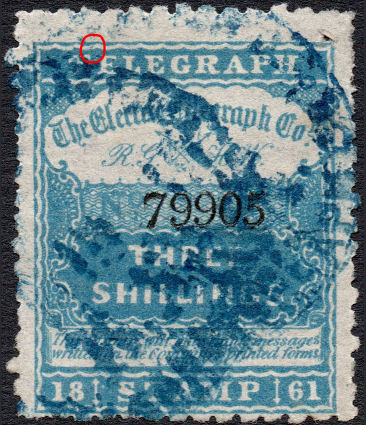 |
| Column 1 - mark in frame under 'G', thin bottom to 'S' | Column 2 - scan needed | Column 3 - scan needed | Column 4 - like 1, 7 and 0 | Column 5 - mark within white frame above 'T' |
| courtesy of Steve Lawrie. | ||||
 |
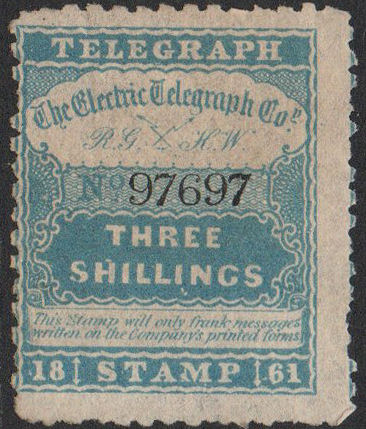 |
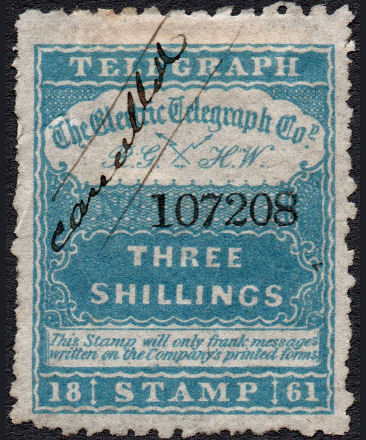 |
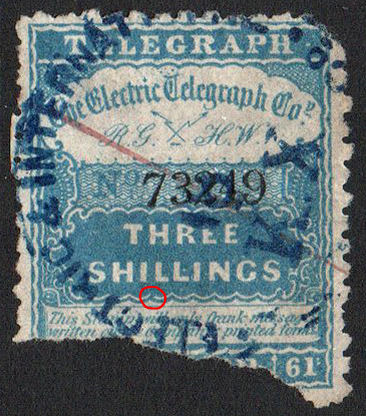 |
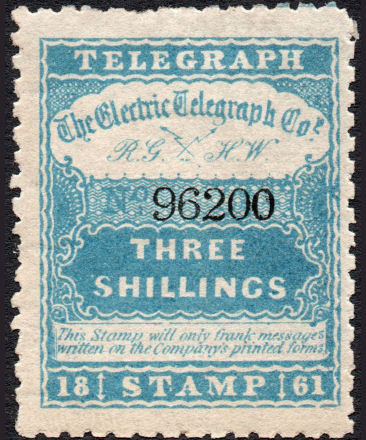 |
| Column 6 - scan needed | Column 7 - like 1, 4 and 0 | Column 8 - like 5 | Column 9 - expected to match 3 and 6. scans needed | Column 0 - like 1, 4 and 7 |
| courtesy of Steve Lawrie. | ||||
This is back to this pattern:
| 1 | 2 | 3 | 4 | 5 | 6 | 7 | 8 | 9 | 0 |
The design includes the monograms of RG / JSF.
According to Philbrick & Westoby (1881), these were engraved by Waterlow & Sons and then transferred to stone for printing by lithography.
These were used to pay the rates to Denmark, Hamburg and Hanover. I do not know when these ceased to be used, but Lister and Hiscocks say Perf. 12, 12½ which I presume that means both 12
for the early ones and 12½ later, as with the other stamps inscribed "RG / JSF". They were therefore used until after 1863, but since they are not known initialled "RG / HW",
so probably not much into 1864. It may be that Henry Weaver had them replaced by the normal stamps, that might explain their scarcity.
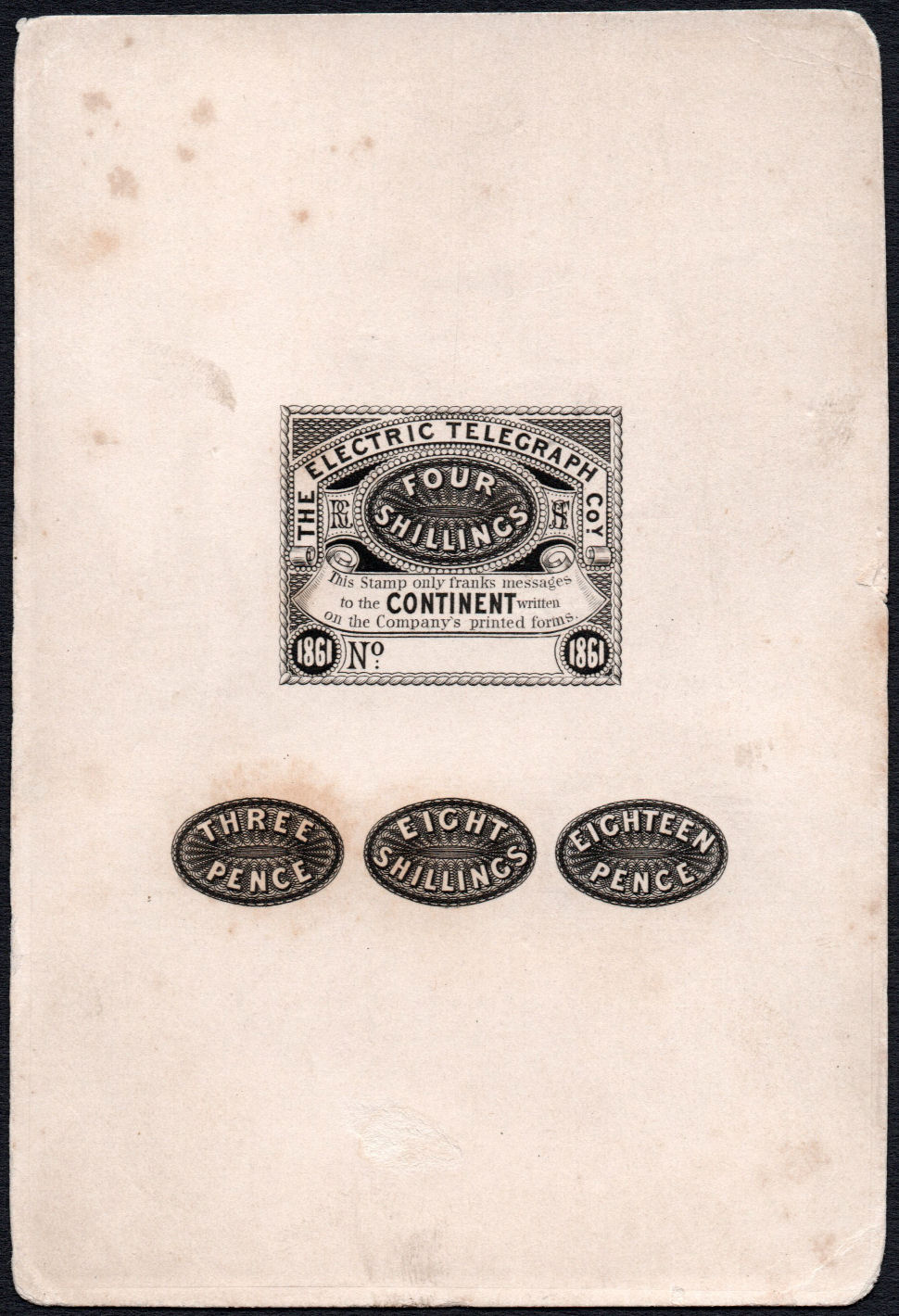 |
| Die Proof of Continental Service Stamps, Hiscocks H58 (half size) Similar proofs exist without the alternate centres at the bottom. |
| Courtesy Steve Lawrie |
Transfer block of two, so two types of Eight Shillings exist in alternate columns.
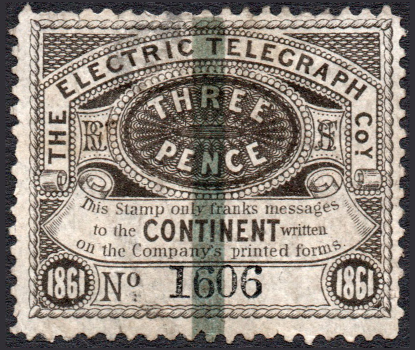 |
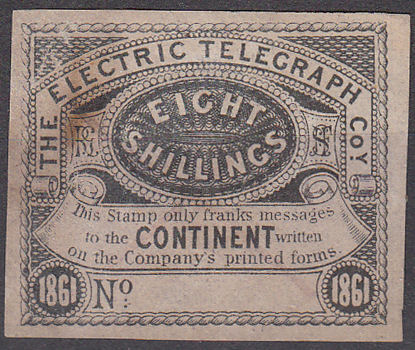 |
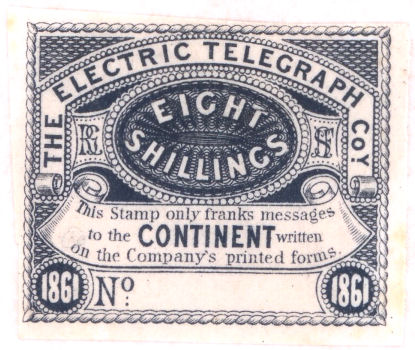 |
| RH55a - 3d with vertical bar, perf.12 L&H say Controls 566, 570 and 944 of the 3d are also known. |
Remainder(?) of Continental Service Stamps, Hiscocks H58. | Plate Proof of Continental Service Stamps, Hiscocks H58 Note the line through the 'T' of 'EIGHT'. |
| Image courtesy of Steve Lawrie. | Image courtesy of Martien Blank. | Image courtesy of Dr Mark Gibson. |
Hiscocks also lists these overprinted with a vertical Bar (3d) and 4 Bars (8s) and gives them an 'a' suffix. H55a - £25.00 / £25.00, H58a - £50.00 / £50.00
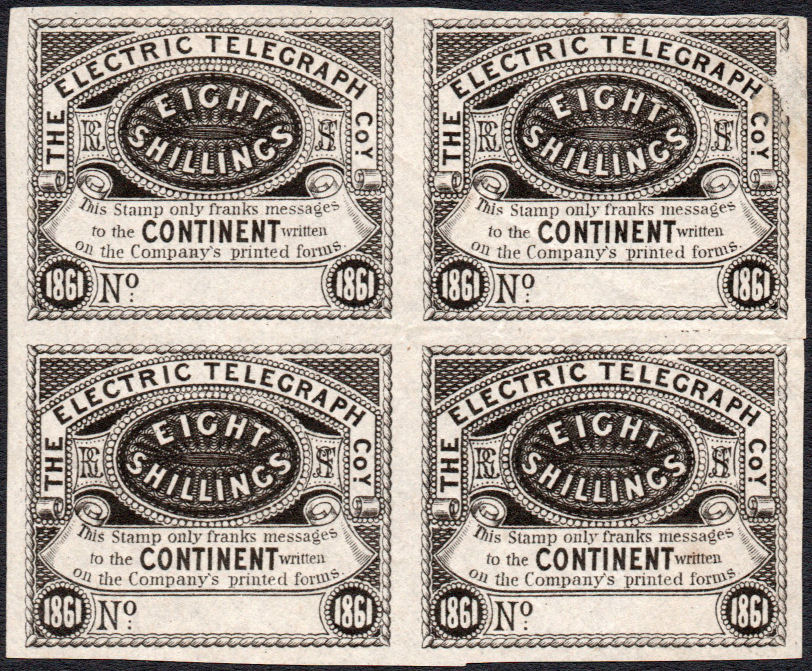 |
| This block of 4 remainders? shows the line through the 'T' of 'EIGHT' on one column. The other column has a line through the S of SHILLING. |
| Image courtesy of Steve Lawrie. |
| RH # | Hisc. | Description | Rarity | Mint | Used |
|---|---|---|---|---|---|
| RH55 | H55a | 3d Black with control number and vertical centre band | R4 | - | - |
| RH55a | H55 | no control number or vertical bands. imperf. | R4 | - | - |
| RH56 | H56a | 1s6d Black with control number and vertical centre band | Unknown | - | - |
| RH56a | H56 | no control number or vertical bands. imperf. | Unknown | - | - |
| RH57 | H57a | 4s Blue(?) with control number and vertical centre band | Unknown | - | - |
| RH57a | H57 | no control number or vertical bands. imperf. | Unknown | - | - |
| RH58 | H58a | 8s Black with control number and vertical centre band | R5 | - | - |
| RH58a | H58 | no control number or vertical bands. imperf. | R5 | - | - |
The reference to the 4/- blue comes from the Walter Morley catalogue of 1900. Quite a few of the things that he listed have not been recorded since.
Have they all perished? Perhaps hidden in a collection or maybe an error. He did illustrate a RH55a (number 1608).
The Royal Collection lists examples of a 3d and 8s issued stamps. L & H give control numbers for them as 8s (2055) and 3d (944)
They also list more 3d examples as being 566(?) and 570 (Tapling). Hiscocks illustrated a 3d numbered 1608.
JLR/JSF stamp of circa 1857 for the use of (G.P. George Parker) Bidder Esq only. (small control numbers)
Lithographed on thick, blue, unwatermarked paper in sheets of 100 by Waterlow & Sons. Imperforate.
| Hiscocks H60 |
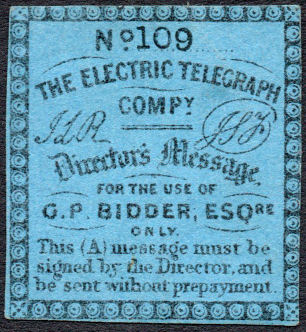 |
| Courtesy Steve Lawrie. |
The wording on the bottom "This (A) message must be signed by the Director, and be sent without prepayment",
probably relates to a later, 1868 form shown under Miscellaneous on the Stationery page, with similar instructions signed by Henry Weaver.
In that the '(A)' stands for 'annexed'.
RG/HW stamp of circa 1864 for the use of Captain (Mark) Huish only. (Died 18 January 1867)
There are two types that appear to have alternated on the sheets. Larger control numbers.
| Hiscocks H62 - Type I (mostly even numbers). | |||
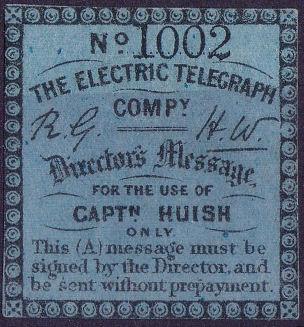 |
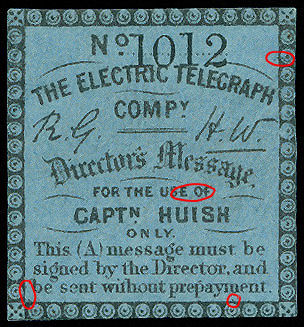 |
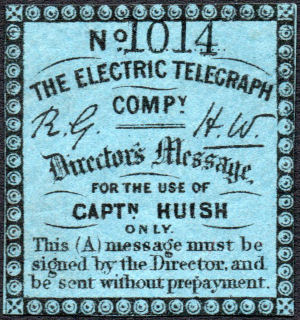 |
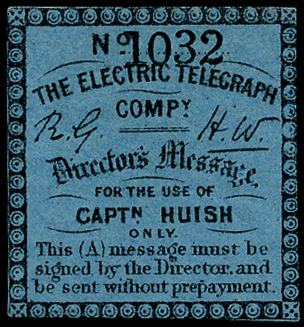 |
| Courtesy Steve Lawrie. The one illustrated by Walter Morley in 1900 |
Courtesy Grosvenor Auctions, Ex Hiscocks. |
Courtesy of Steve Lawrie. | Courtesy Mike-Holt.com, Ex A. J. Lowe. |
| Hiscocks H62 - Type I (mostly even numbers). | |||
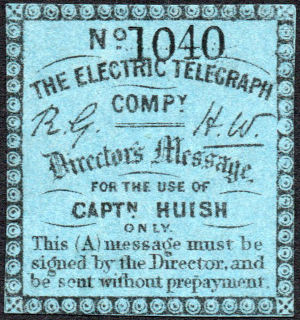 |
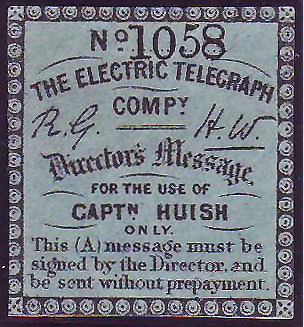 |
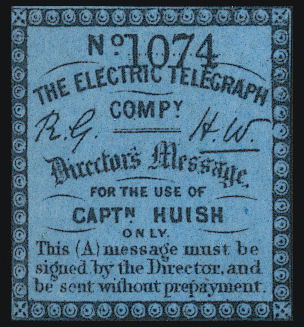 |
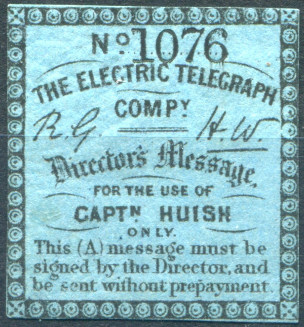 |
| Courtesy of Steve Lawrie. | From Langmead & Huggins' book (Fig.20), courtesy of the Great Britain Philatelic Society |
Courtesy Grosvenor Auctions, Ex Iain Stevenson. |
Courtesy of Steve Lawrie. |
| Hiscocks H62 - Type II (mostly odd numbers). | ||||
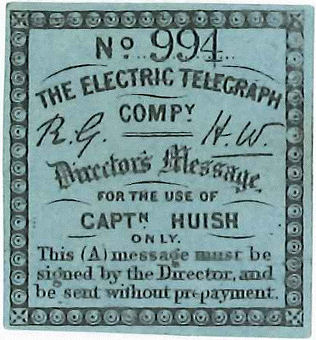 |
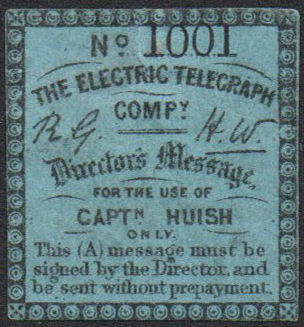 |
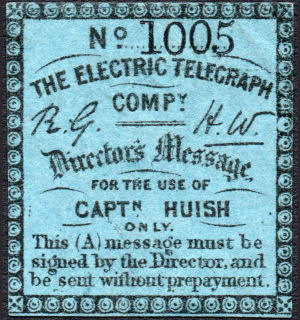 |
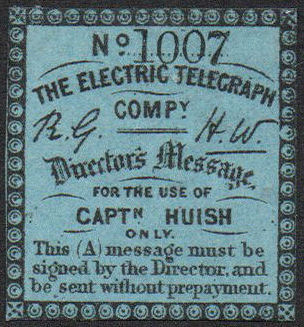 |
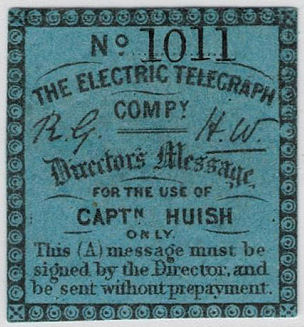 |
| Courtesy of Mark Talbot. | Courtesy of Steve Lawrie. | Courtesy of Steve Lawrie. | Courtesy of Steve Lawrie. | Courtesy of Roger de Lacy-Spencer. |
| Hiscocks H62 - Type II (mostly odd numbers). | ||||
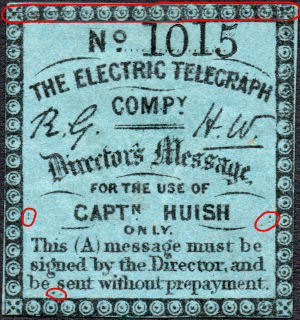 |
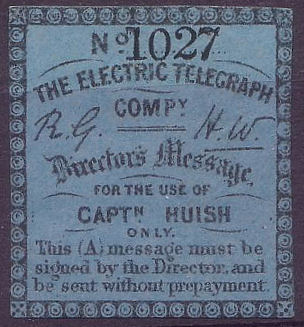 |
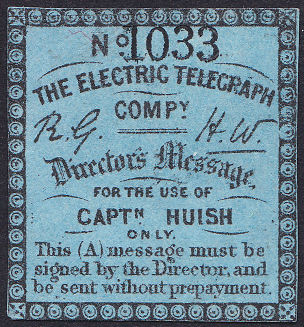 |
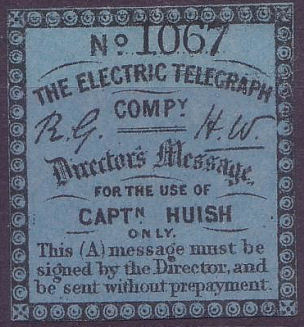 |
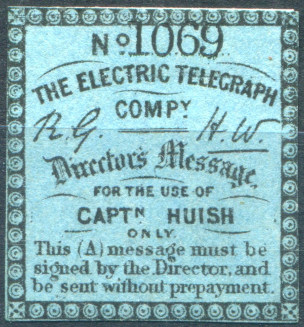 |
| Courtesy of Steve Lawrie. | Courtesy of Steve Lawrie. | Ex-Andrew Higson, now mine. | Courtesy of Steve Lawrie. | Courtesy Grosvenor Auctions, Ex Iain Stevenson. |
| Hiscocks H62 - Type II (mostly odd numbers). | |||
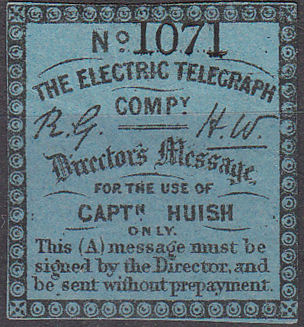 |
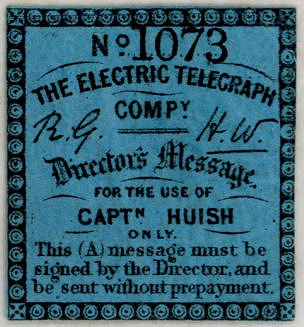 |
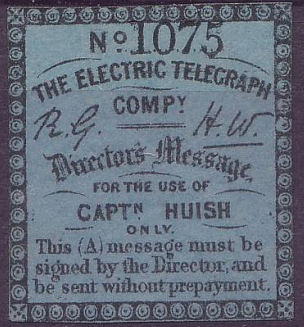 |
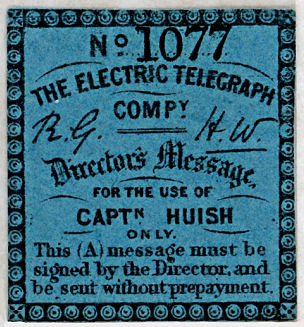 |
| Courtesy of Martien Blank. | Courtesy of Mark Gibson. | Courtesy of Steve Lawrie. | Courtesy of Mark Gibson. |
I have scans of 8 even numbers with shared characteristics and 13 odd numbers with different shared characteristics.
Since writing the above, I have been sent a scan of 994 which I show above with the 'Odd' numbered stamps !
The reason is that 994 has the flaws I have so far only seen on odd numbered stamps. It also has larger margins than is usual.
Langmead & Huggins also point out that this stamp is on a "paler shade of blue" to the others.
These stamps were supplied "in batches of 100 at a time" [Philbrick & Westoby (1881), page 328],
so this stamp is from a different batch to the others (1002-1077) that I have seen. It would be interesting to see more from that batch.
Interestingly, although 994 has good margins all around, on the next sheet most examples are cut into somewhere and
none show parts of adjoining stamps. 1014 and 1015 for example should show parts of each other.
They all appear to have been pre-trimmed for some reason.
This is very similar to serialised examples of The English & Irish Magnetic Telegraph Company stamps.
With the English and Irish, indications are they were trimmed to fit a dispenser of some kind, perhaps Captain Huish trimmed his to fit a stamp box?



Here are three consecutive numbers from above. They do not fit together however you arrange them. There are probably no multiples of these.
I can't help noticing the different colours of these that were printed together. In part this might be due to different environments in the last 150 years,
but may also be due to differences in scanners and/or post-production work.
Based on the scans I have for these numbers, currently : 994, 1001, 1002, 1005, 1007, 1011, 1012, 1014, 1015, 1027, 1032, 1033, 1040, 1058, 1067, 1069, 1071, 1073-1077.
| Even Columns (except 994) | Odd Columns (plus 994) |
|
1) Mark through the RH frame by second 'pearl' down. 2) Mark inside the frame under 'm' of 'prepayment', and mark above 'p'. 3) Mark inside the frame to left and another below-left of 'be' in 'be sent'. 4) Line through 'SE' and 'OF' of 'USE OF'. |
1) Shortened curve under "CAPT". 2) Two dots near frame left of 'CAPTn'. 3) Two dots near frame low right of 'HUISH'. 4) Two dots below-left of 'sent' on bottom row. 5) Horizontal line through top row of pearls. |
Directors' Message stamps were to enable directors to send telegraphs, presumably at a discount or free, in exchange for their signature.
The designs include the initials of the Chairman and Secretary, together with the name of the Director in question.
| J.L.R. - J.S.F. prior to 1859 (John Lewis Ricardo - J. S. Fourdrinier) | R.G. - J.S.F. 1859-1863 | R.G. - H.W. from 1864 (Robert Grimston - Henry Weaver) |
|---|---|---|
On RH64, Raymond Lister says (1961) "A specimen one issued for Lord Alered Paget (control No. 1097) is in the Royal Collection. It is unique."
I have now seen an image of it and that is how it is written, 'Alered', an embarrassing error. The correct name was Lord Alfred Paget.
The Royal Collection also lists (for JLR-JSF) a G.P.Bidder(41) and a pen cancelled Thos. Brassey(1076), as well as (for RG-HW) a Captn Huish and a Charles William Earle(149).
Perf. 15 well-centred, No controls.
Since Waterlow & Sons did not use perf.15 before 1875, it is thought these were produced as samples of their work.
With the possible exception of the 3s, these are from a new set of plates that were not used to produce stamps for the Electric Telegraph Company.
These are on whiter, better quality paper.
Differences:
| 3d | the originals all had frame-breaks around the value tablet. |
| 1s | the originals had a white control tablet. |
| 1s6d | the originals had the value sloping. |
| 2s | the originals had a distorted 'W' in 'TWO'. |
| 4s | this value was not used for the H.W. stamps. If it had been, it would probably have had a white control tablet. |
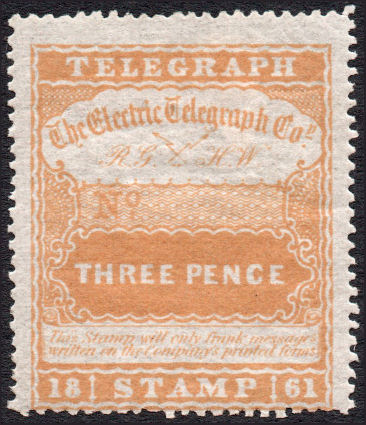 |
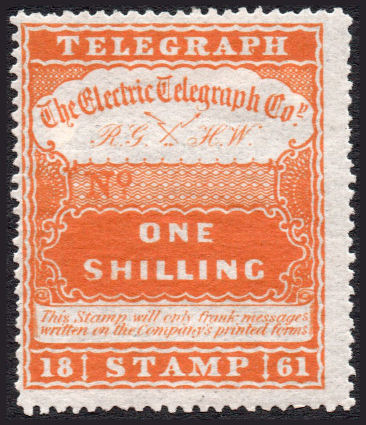 |
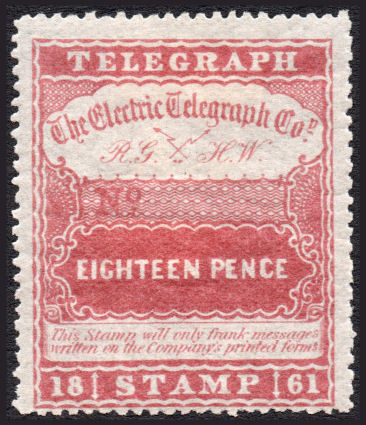 |
| 3d. Perf.15 | 1s. Perf.15 | 1s6d. Perf.15 |
| Images courtesy of Steve Lawrie | ||
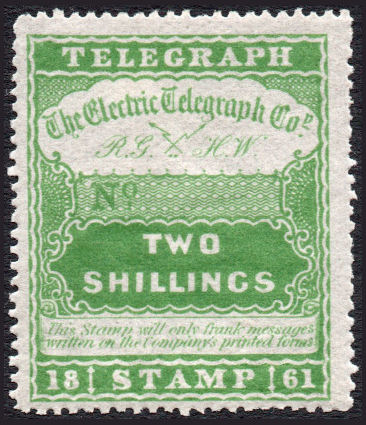 |
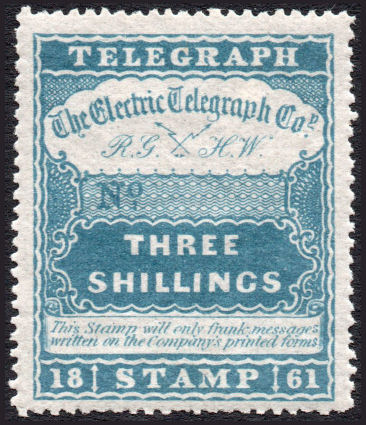 |
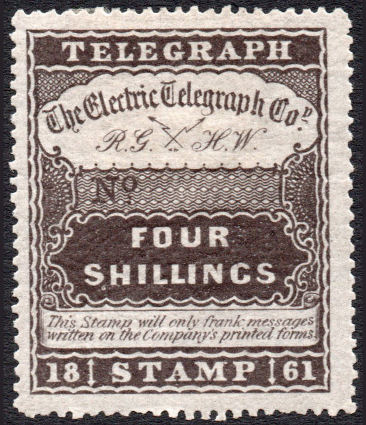 |
| 2s. Perf.15 | 3s. Perf.15 | 4s. Perf.15 |
| Images courtesy of Steve Lawrie | ||
| RH # | Hisc. | Description | Mint | Used |
|---|---|---|---|---|
| RH65 | - | 3d Buff. | 50.00 | - |
| RH66 | - | 1s Orange | 50.00 | - |
| RH67 | - | 1s6d Rose | 50.00 | - |
| RH68 | - | 2s Green | 50.00 | - |
| RH69 | - | 3s Blue | 50.00 | - |
| RH70 | - | 4s Brown black | 50.00 | - |
Early ones have 'The Electric Telegraph Company', later ones have 'Electric & International Telegraph Co.'
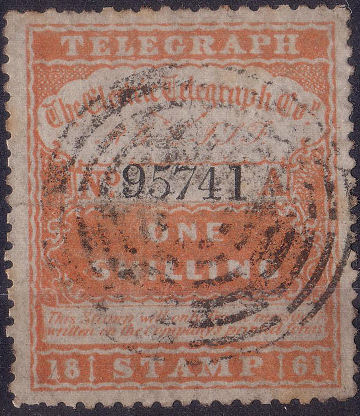 |
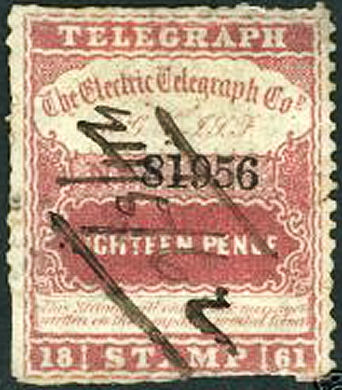 . |
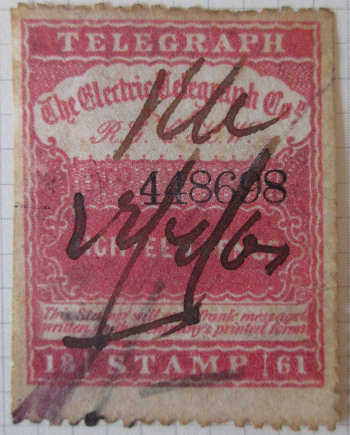 |
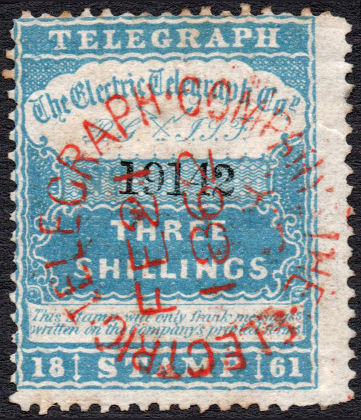 |
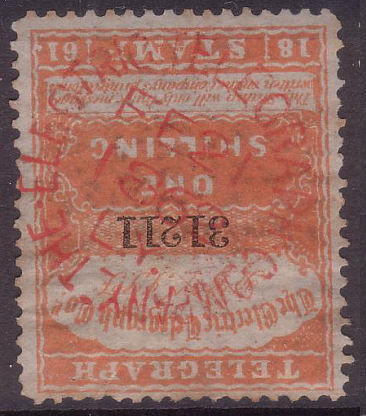 |
| British & Irish Magnetic Telegraph Co. cancel on 1s. (very unusual) - courtesy of Steve Lawrie. |
RG/JSF pen cancel on 1s6d. 24/5/62 |
RG/HW pen cancel on 1s6d. 12/4/67 - courtesy of Mark Talbot. |
"L.Y." cancel in red - courtesy Steve Lawrie. Dated 21/2/1862 on JSF 3s perf. 12. |
The same cancel on JSF 1s plate 1. courtesy Steve Lawrie. |
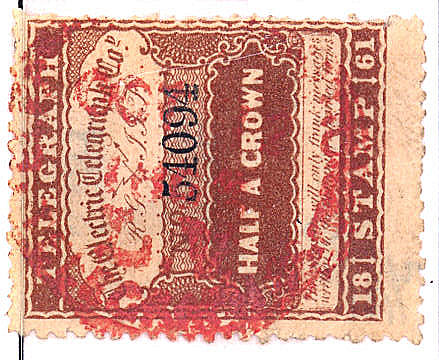 |
 |
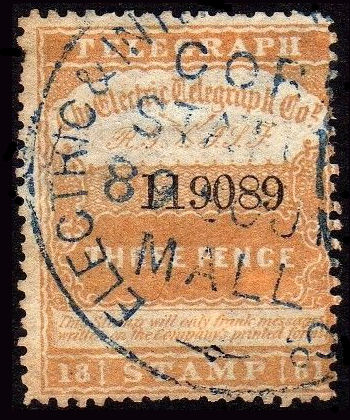 |
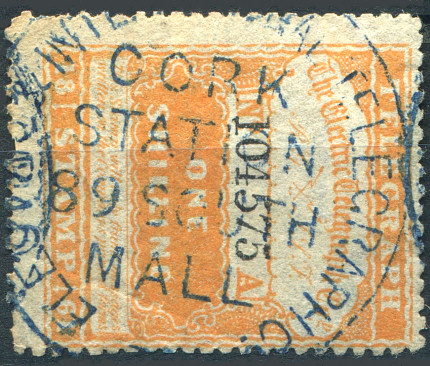 |
| looks like Oct 12 / 1864 and "LV" for Liverpool? Image courtesy of Dr Mark Gibson. |
Roches Point courtesy of Steve Lawrie. |
The same type cancel courtesy of Andrew Higson. |
Cork Station - now clearly. Ex Iain Stevenson, courtesy of Grosvenor Auctions. |
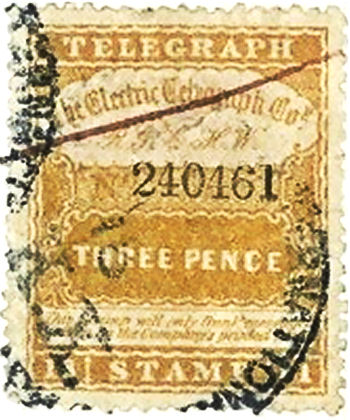 |
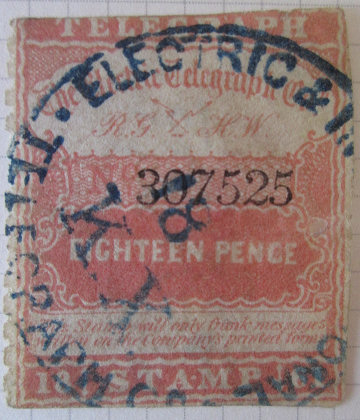 |
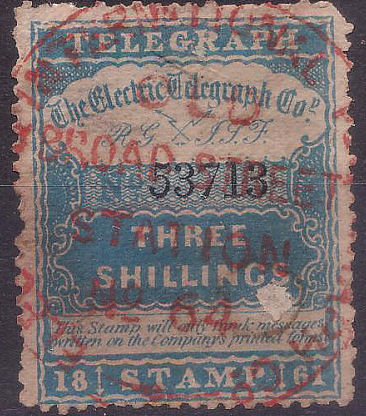 |
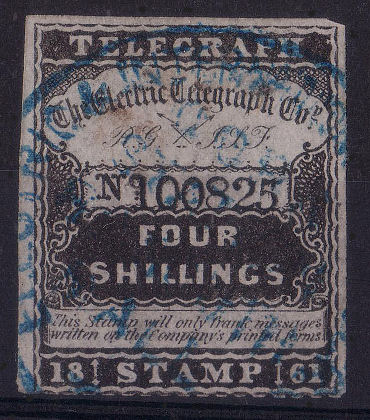 |
| "KX" cancel - courtesy Steve Roberts. I thought initially that 'KX' stood for Kings Cross. However, Steve Roberts informs me that it was actually the Stock Exchange branch office, until the code was changed by Mr Scudamore. |
A similar cancel, this time on an 18d, clearer and in dark blue. Courtesy Mark Talbot. |
A cancel for No.64 Old Broad Street Station. Courtesy Steve Lawrie. |
Similar with blue cancel. Courtesy Steve Lawrie. |
Raymond Lister (1961 book, page 13) gives a list of cancels used, though without illustration.
This rendition of the cancel on the H13 at the top, does not appear to be in the list.
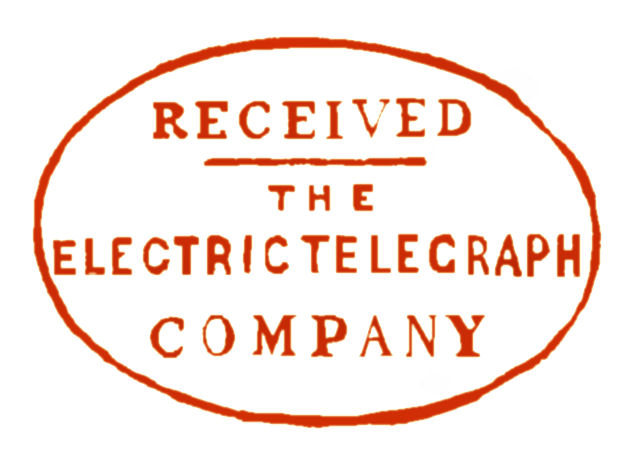
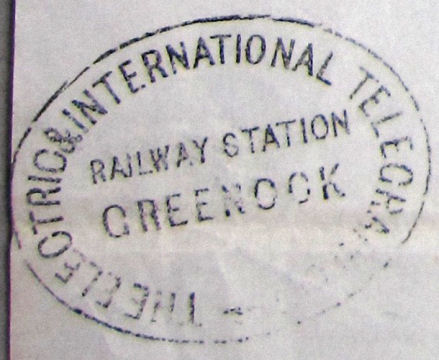
This is similar to the cancellation type 4) described above.
Though not used as a cancel here, this matches the description of Type 4 cancel above. - courtesy Mark Gibson.
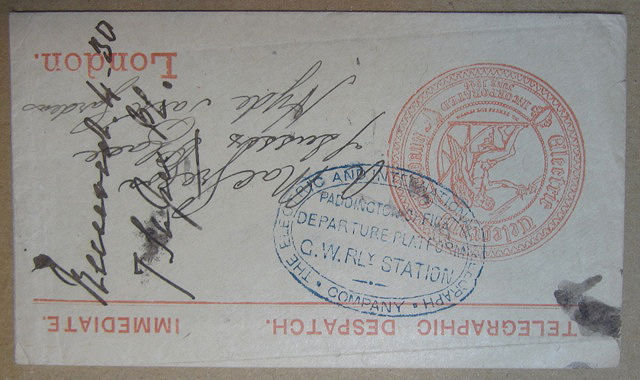
A similar usage. - courtesy of Roger de Lacy-Spencer.
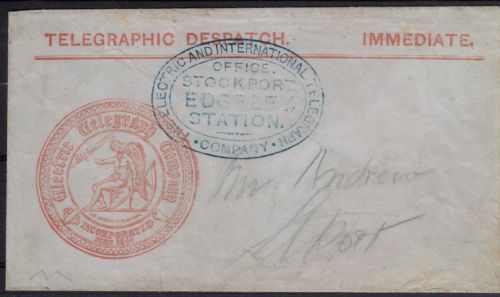
An interesting use of a 1/- remainder, presumably cancelled by favour in 1882.
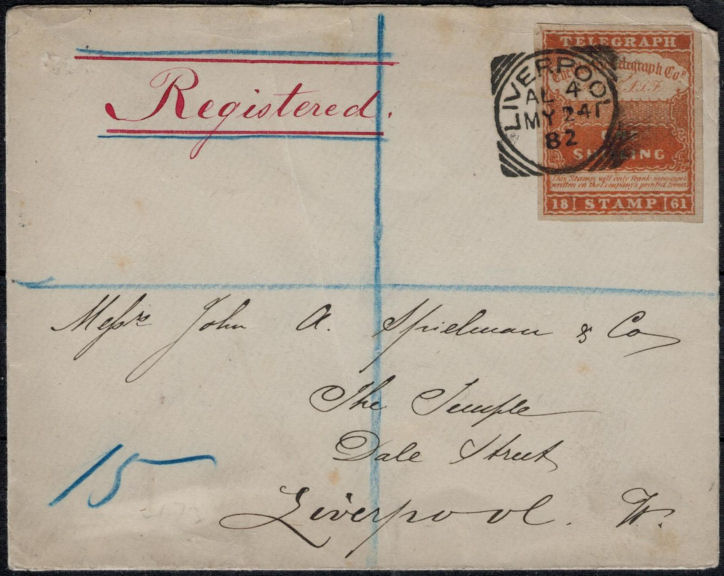
This was part of the A. J. Lowe collection sold by Phillips in November 1990.
Image courtesy of Roger de Lacy-Spencer
Each has a sheet watermark across the middle like this :
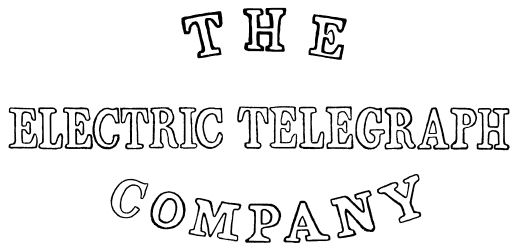
FRANKED MESSAGE PAPER / PRICE ONE SHILLING - Front and back, courtesy of Steve Lawrie. - My Ref. RHF1
These were not to be used for Continental Messages and 3d stamps were intended to be used for extra words.
This has Control Number 3189 at the top-left with the facsimile signature of the Secretary J S Fourdrinier below it.
I initially thought that they were all like that, but see below.
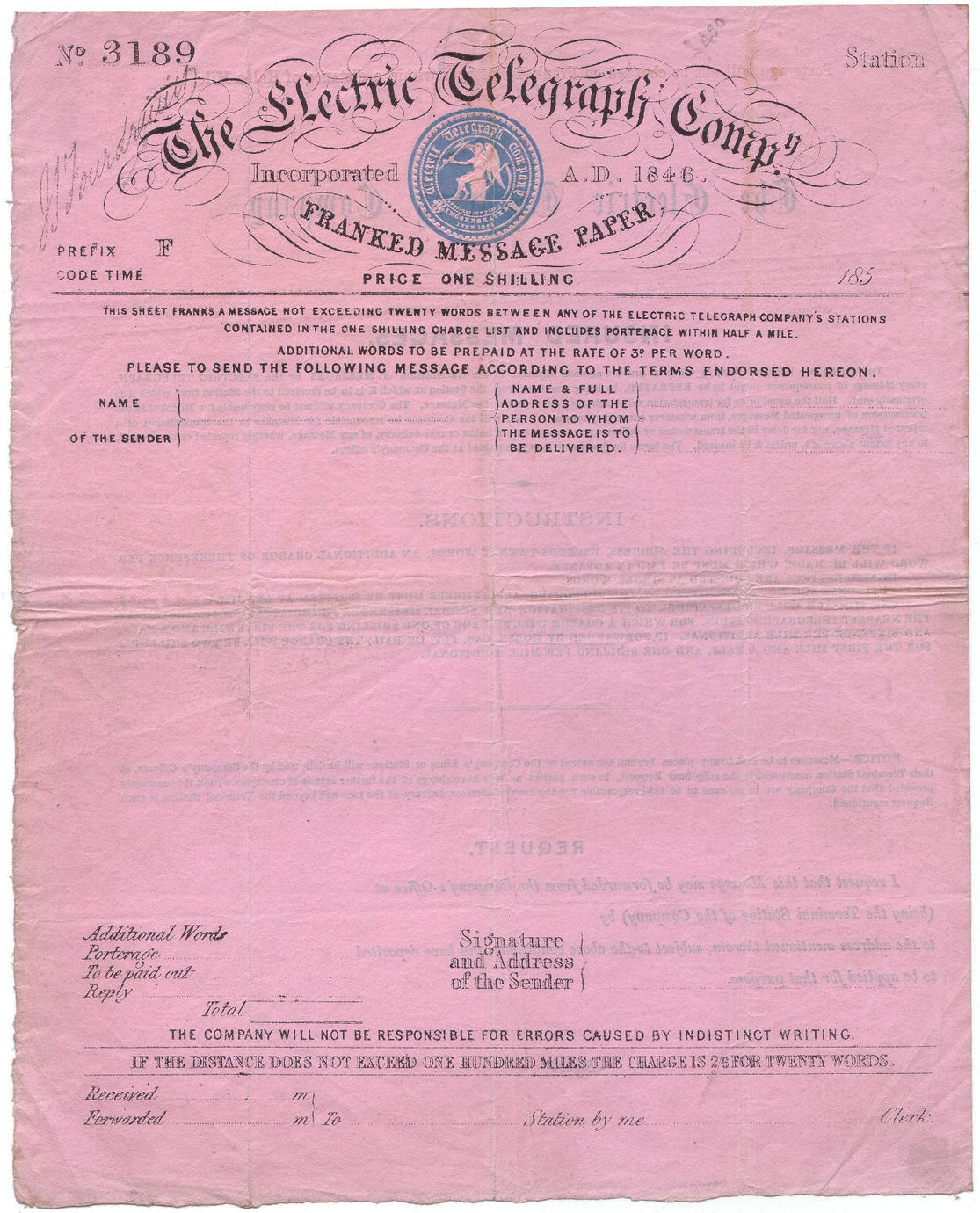
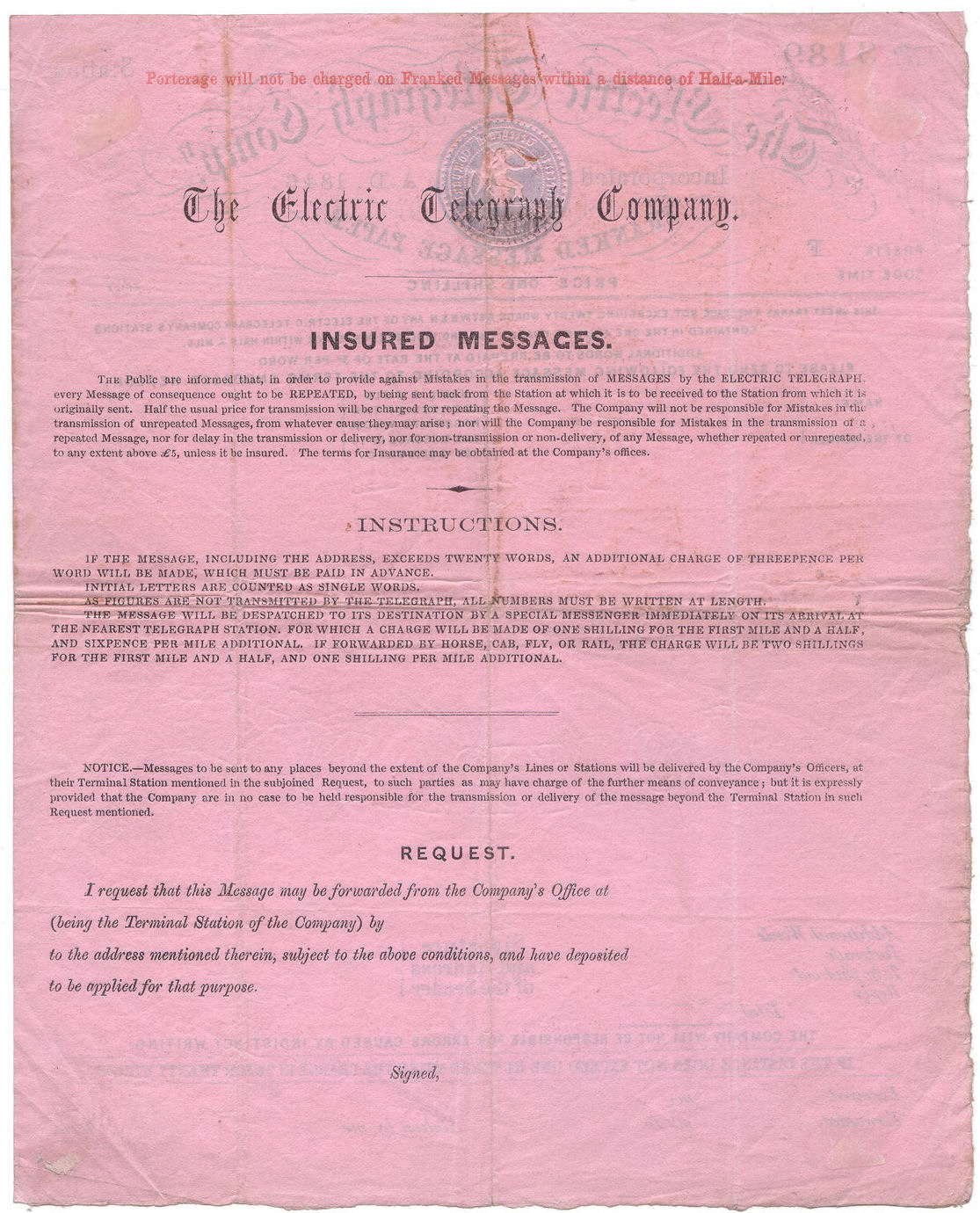
A later FRANKED MESSAGE PAPER / PRICE ONE SHILLING - Front and back, courtesy of Steve Lawrie. - My Ref. RHF1a
This is similar to the last, but the Control Number 29930 is now on the right with the words "No OF MESSAGE" above.
It also has "No. OF WORDS" added below the "CODE TIME" on the left.
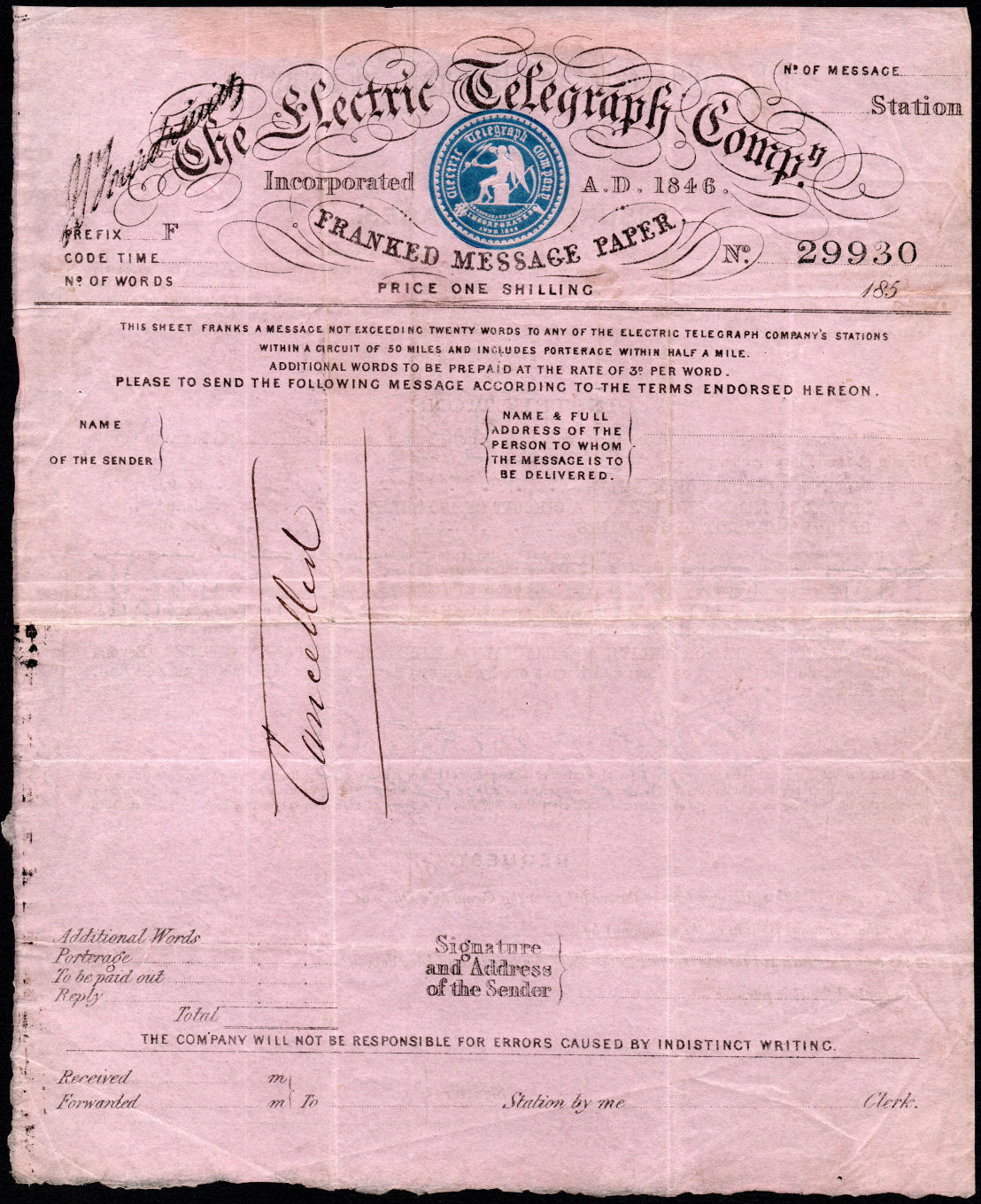
The red note about porterage has been removed from the top and integrated into the instruction section which has been extensively updated.
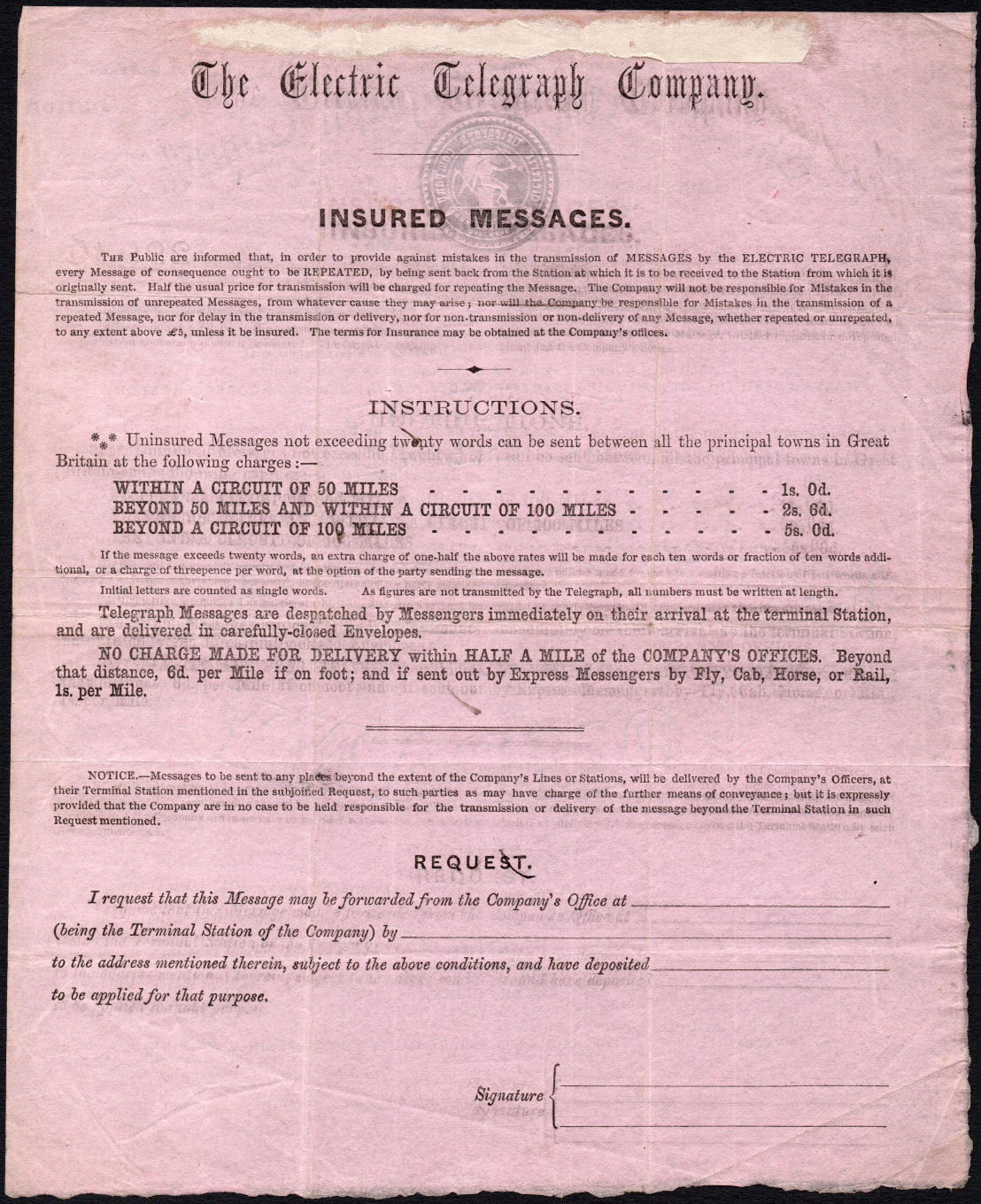
Another FRANKED MESSAGE PAPER / PRICE ONE SHILLING - Front, this monochrome image is taken from "The Stamps of The Electric Telegraph Company (Great Britain)" by E. D. Bacon (1927). - My Ref. RHF1b
As with the last, this has Control Number 38323 on the right side, but now with the facsimile initials of the Secretary J. S. Fourdrinier above it, and initials JLR of the Chairman John Lewis Ricardo on the left side.
Bacon indicated that this was then in the Royal Collection and that the 1/- numbered 29930 (the one above) was in the Ferrari collection.
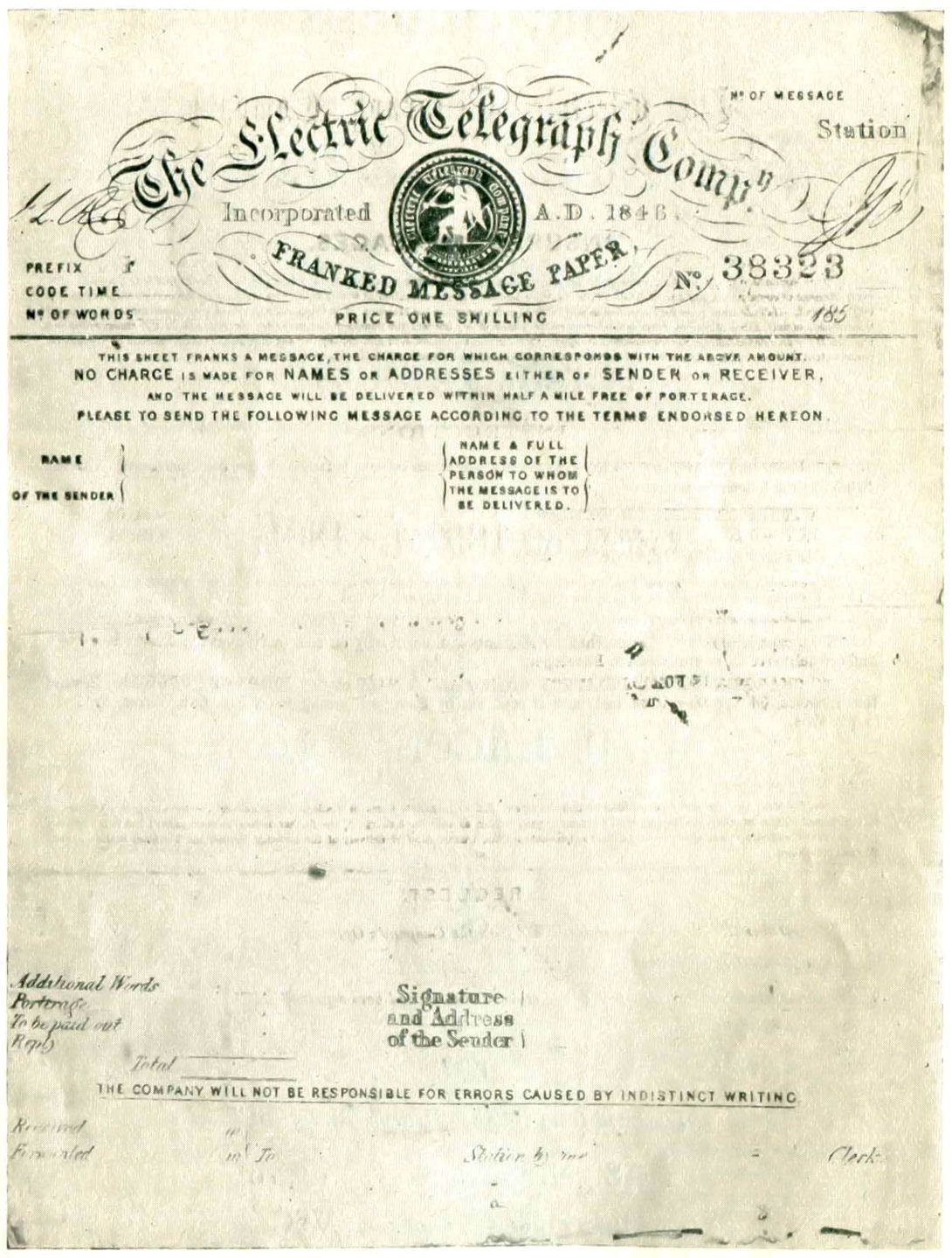
FRANKED MESSAGE PAPER / PRICE ONE SHILLING AND SIXPENCE - courtesy of Steve Lawrie, Ex Iain Stevenson. - My Ref. RHF2
This was needed due to a price increase of the lowest rate in 1853. It is otherwise similar to the last 1/- immediately above.
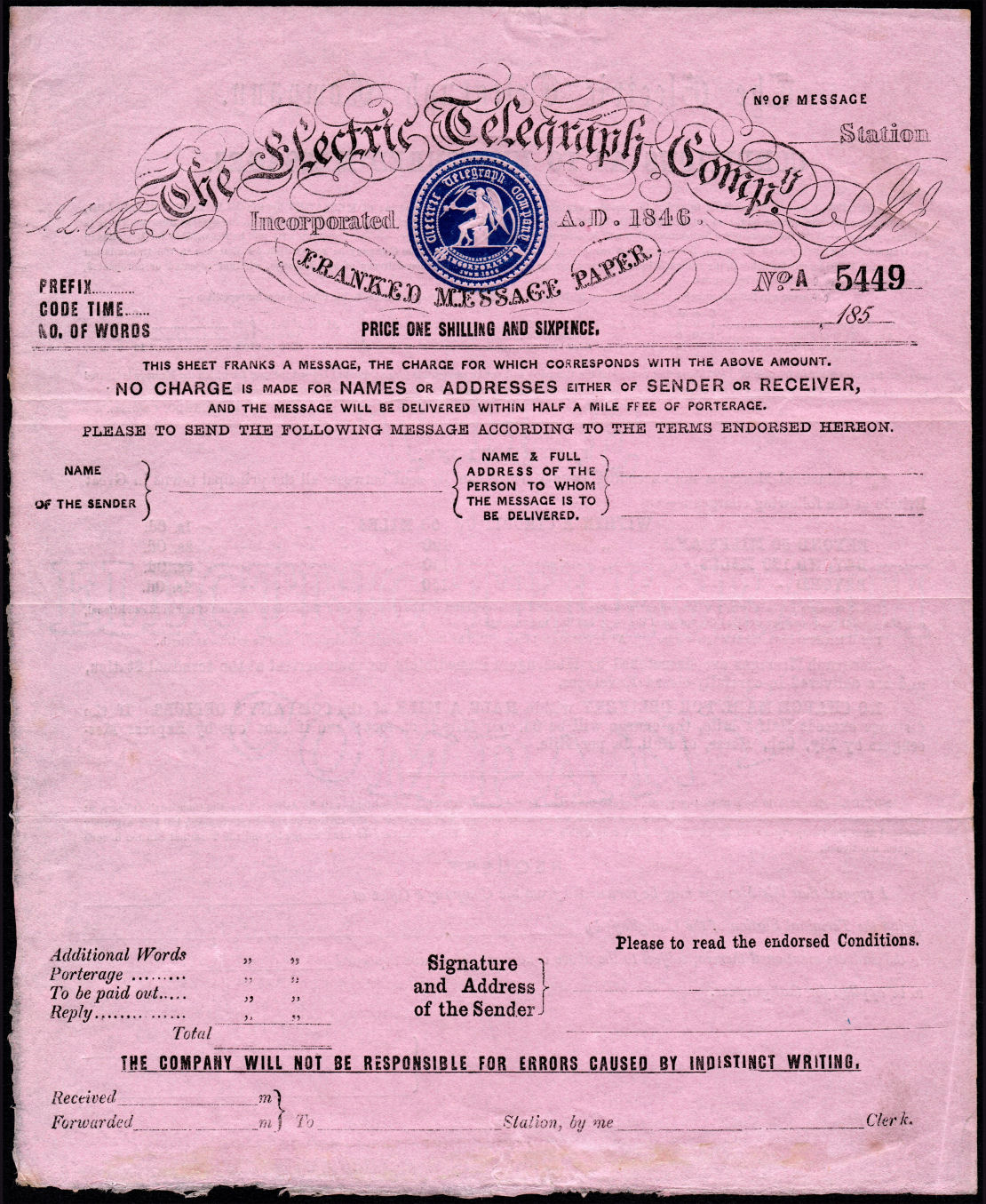
150 dpi.
The Conditions section is for Un-insured Messages and ends with the name of the Chairman, J. L. Ricardo.
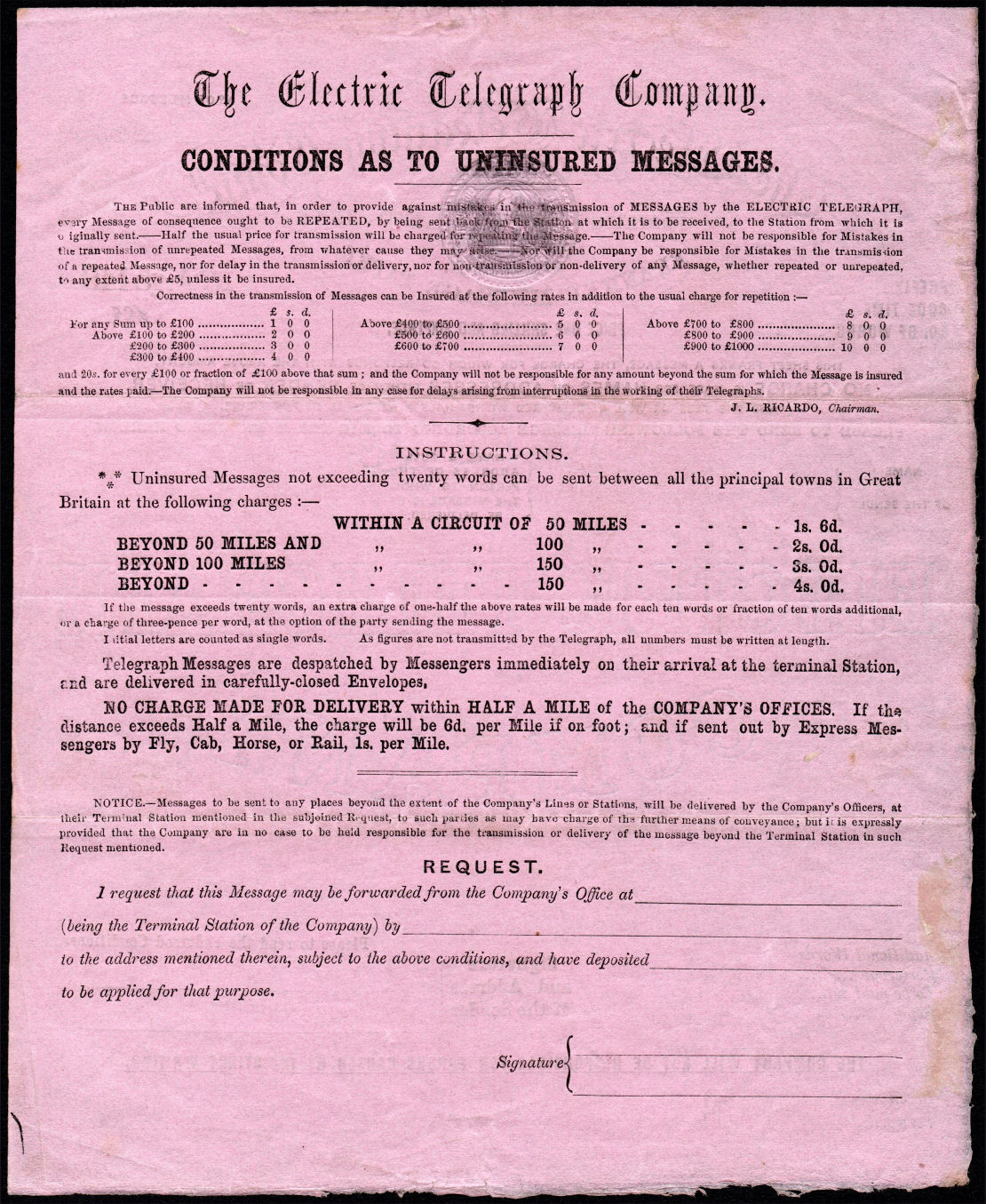
FRANKED MESSAGE PAPER / PRICE TWO SHILLINGS - Front and back, courtesy of Steve Lawrie. - My Ref. RHF3
This is for distances over 50 miles, but within 100 miles.
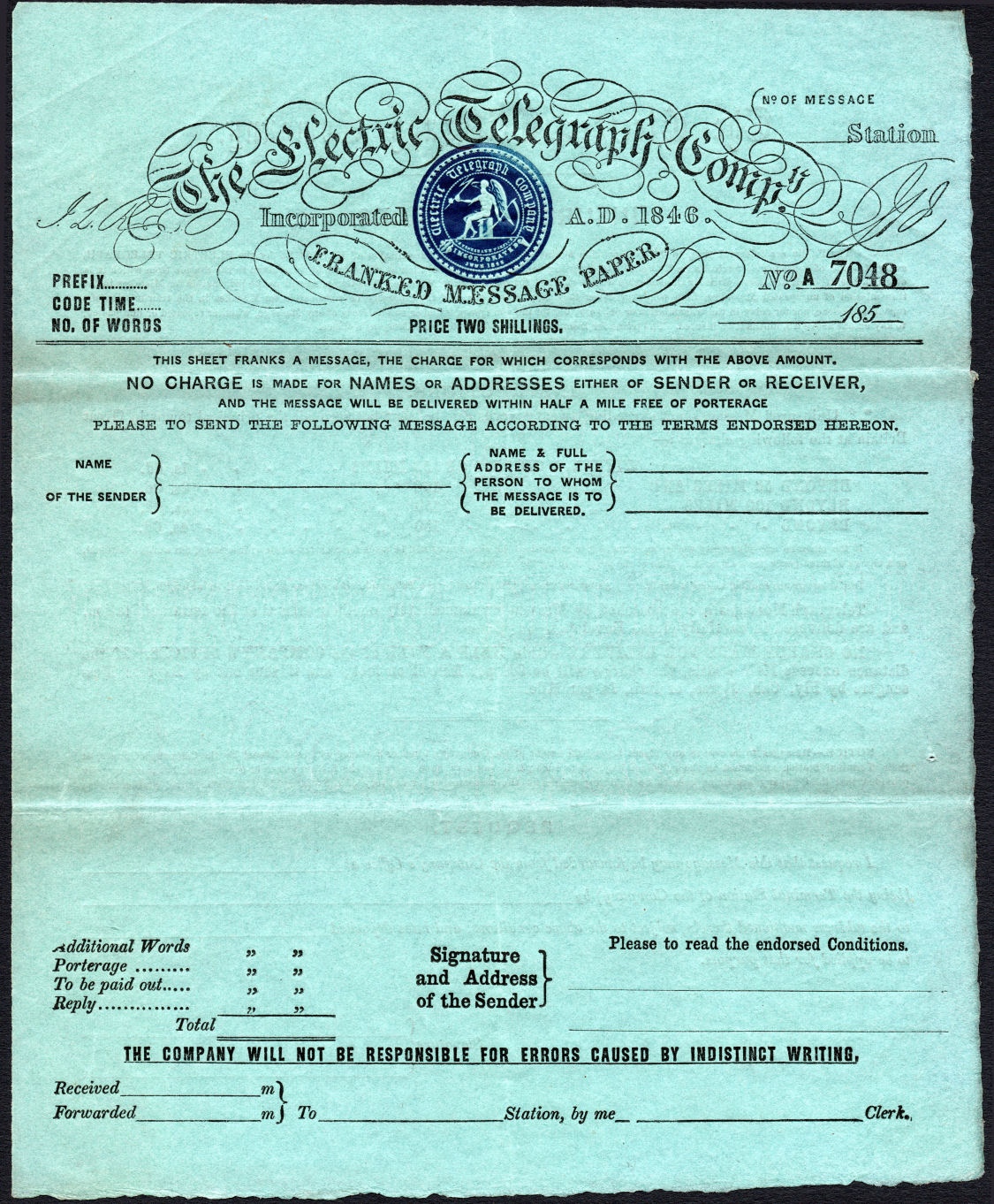
The Conditions section is for Insured Messages with distances over 50 miles, but within 100 miles.
It omits the insurance information and does not name the Chairman.
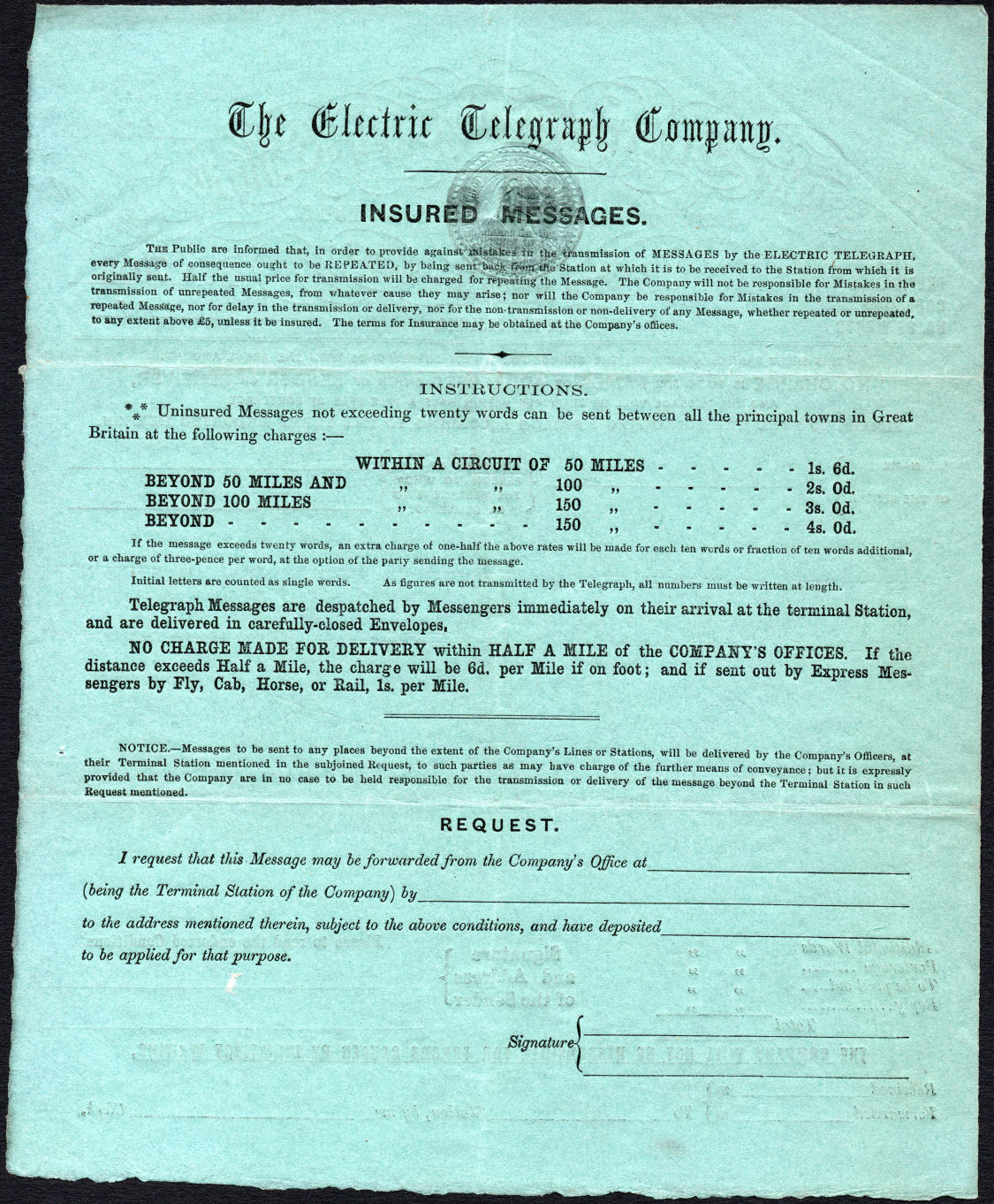
FREE MESSAGE PAPER / PRICE TWO SHILLINGS AND SIXPENCE - Front and back, courtesy of Steve Lawrie. - My Ref. RHF4
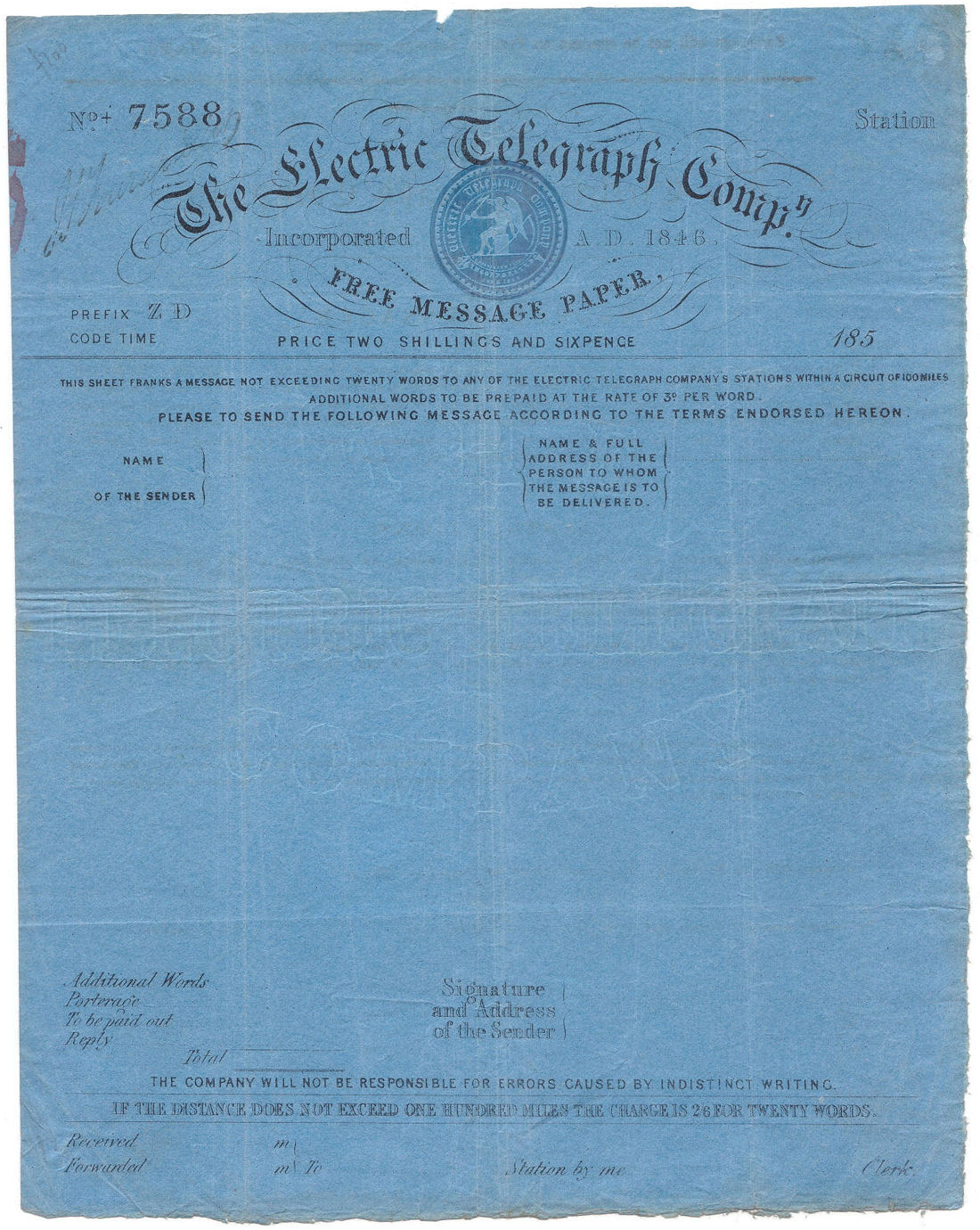
E. D. Bacon describes another 2/6d form as being endorsed in red with:
"This 2s. 6d Message Paper can only be used for distances within a circuit of 100 miles."
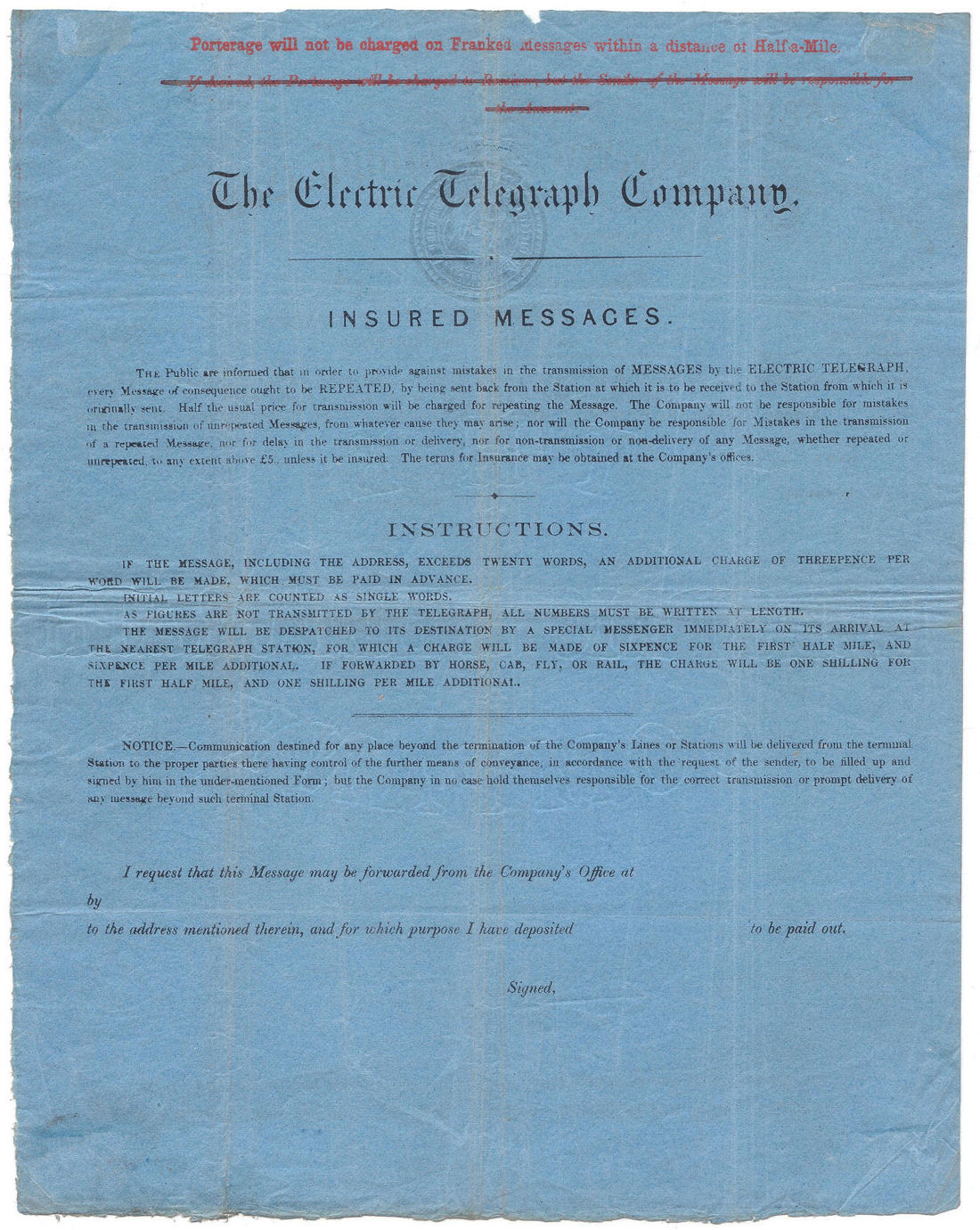
The watermark can be clearly seen on this. This is numbered 7588, number 7666 of the Iain Stevenson collection is illustrated in the L & H book, it is dated 14th July 1854 but not filled in.
FRANKED MESSAGE PAPER / PRICE THREE SHILLINGS - Front, courtesy of Steve Lawrie. - My Ref. RHF5
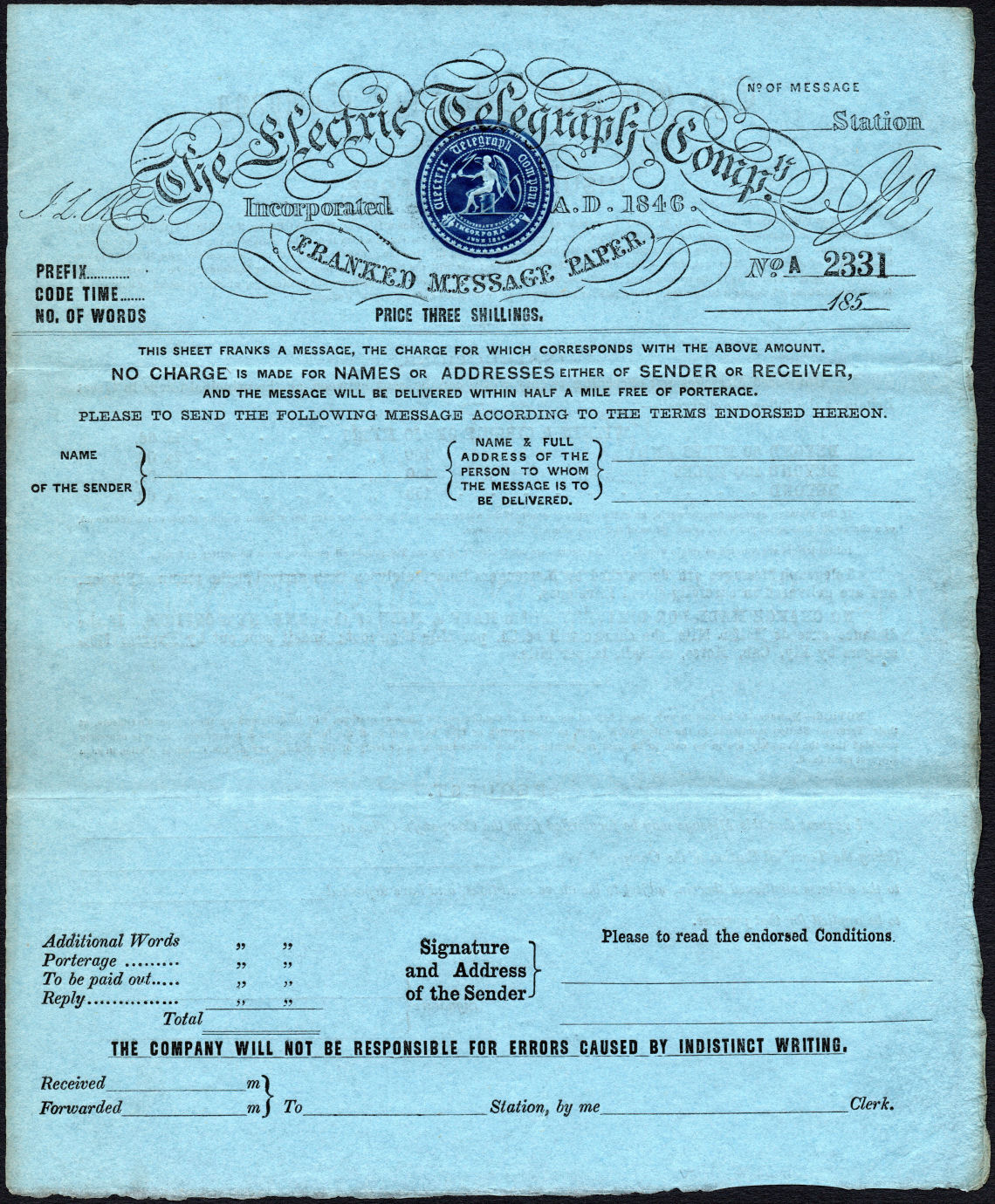
This was for insured messages with distances over 100 miles, but within 150 miles.
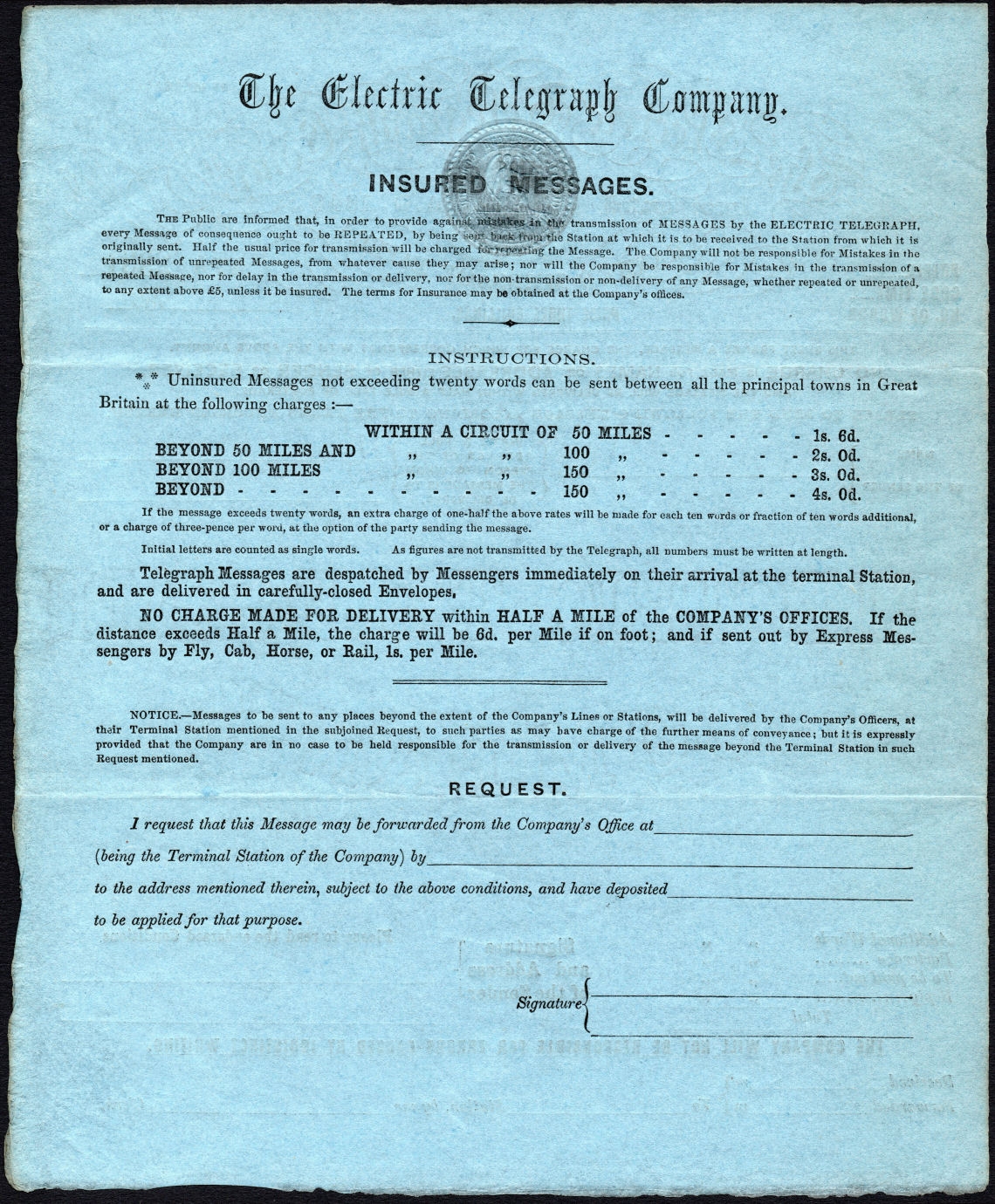
FRANKED MESSAGE PAPER / PRICE FOUR SHILLINGS - Front and back, courtesy of Steve Lawrie. - My Ref. RHF6
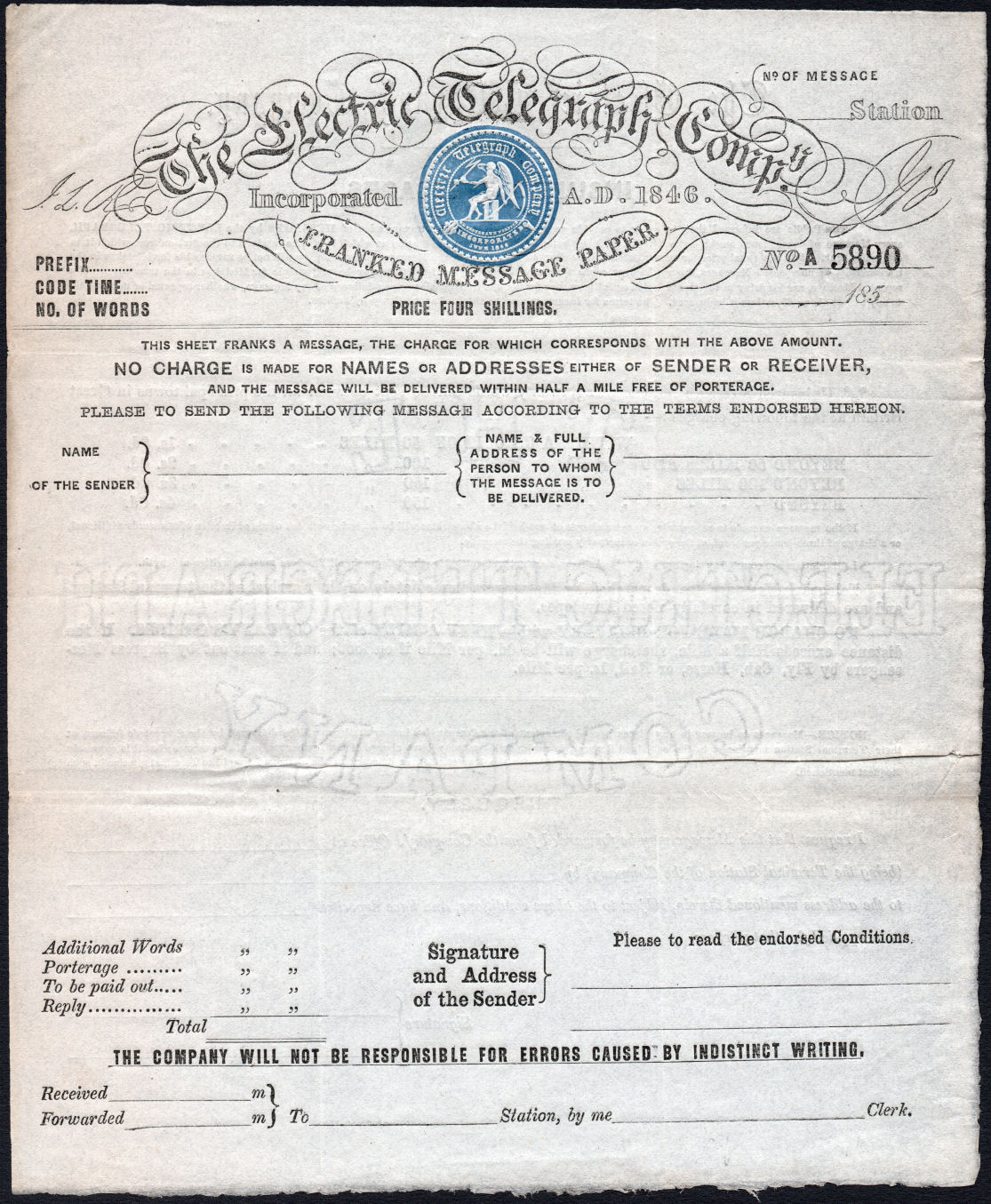
This was for insured messages with distances over 150 miles.
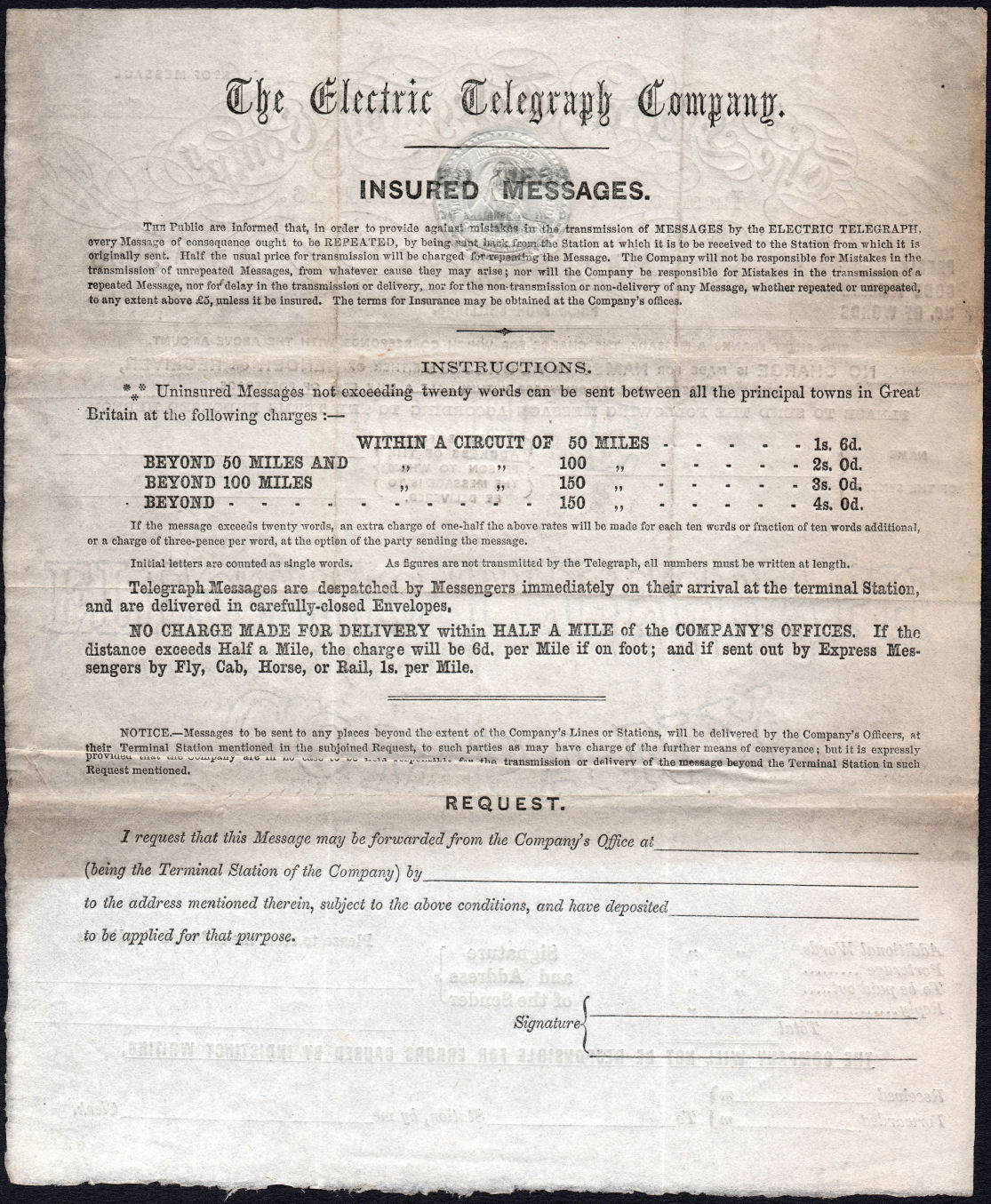
FRANKED MESSAGE PAPER / PRICE FIVE SHILLINGS - courtesy of Steve Lawrie, Ex Iain Stevenson. - My Ref. RHF7
Part of the watermark can be seen.
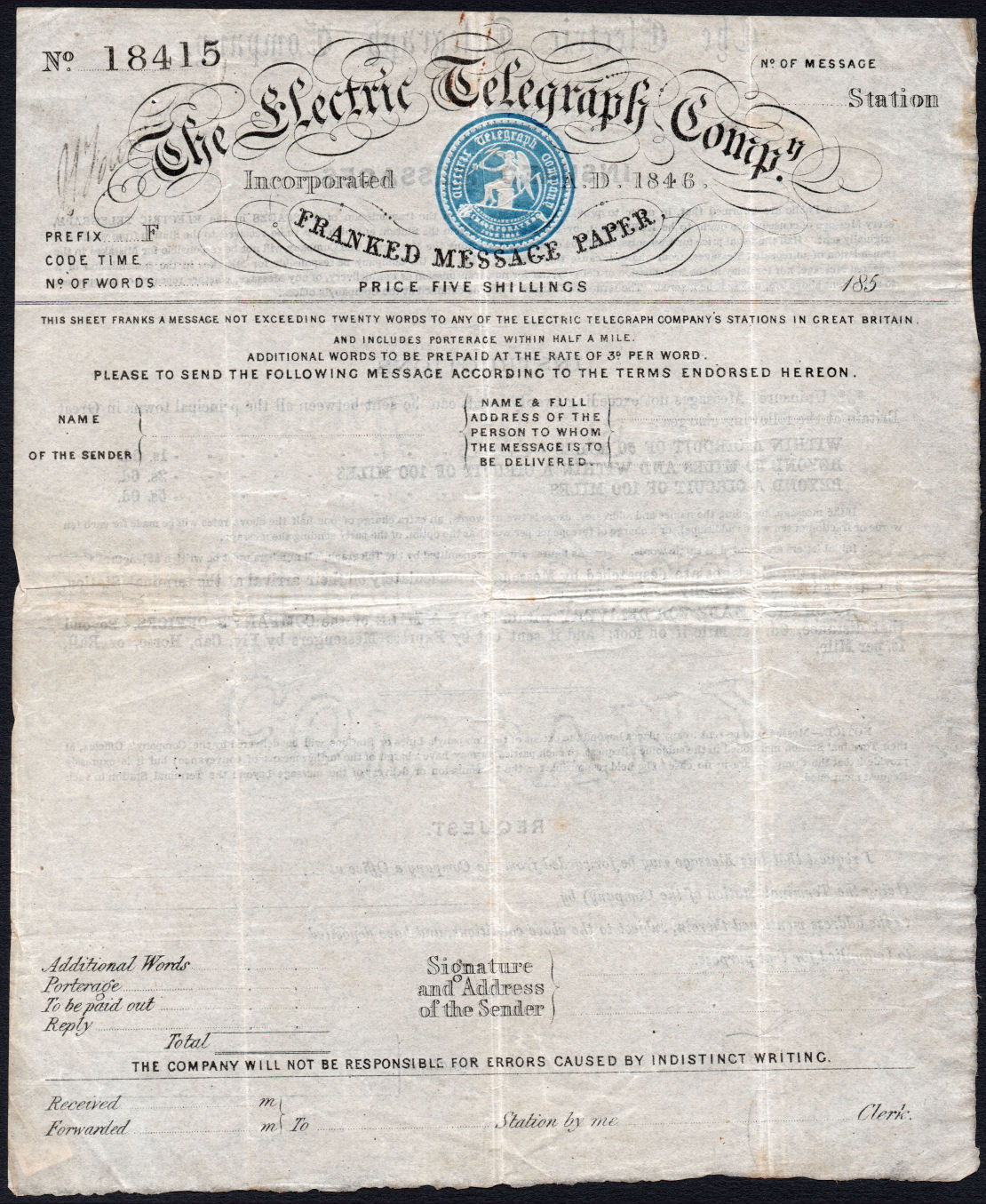
This was for insured messages with distances over 100 miles. It is the only known example of this value.
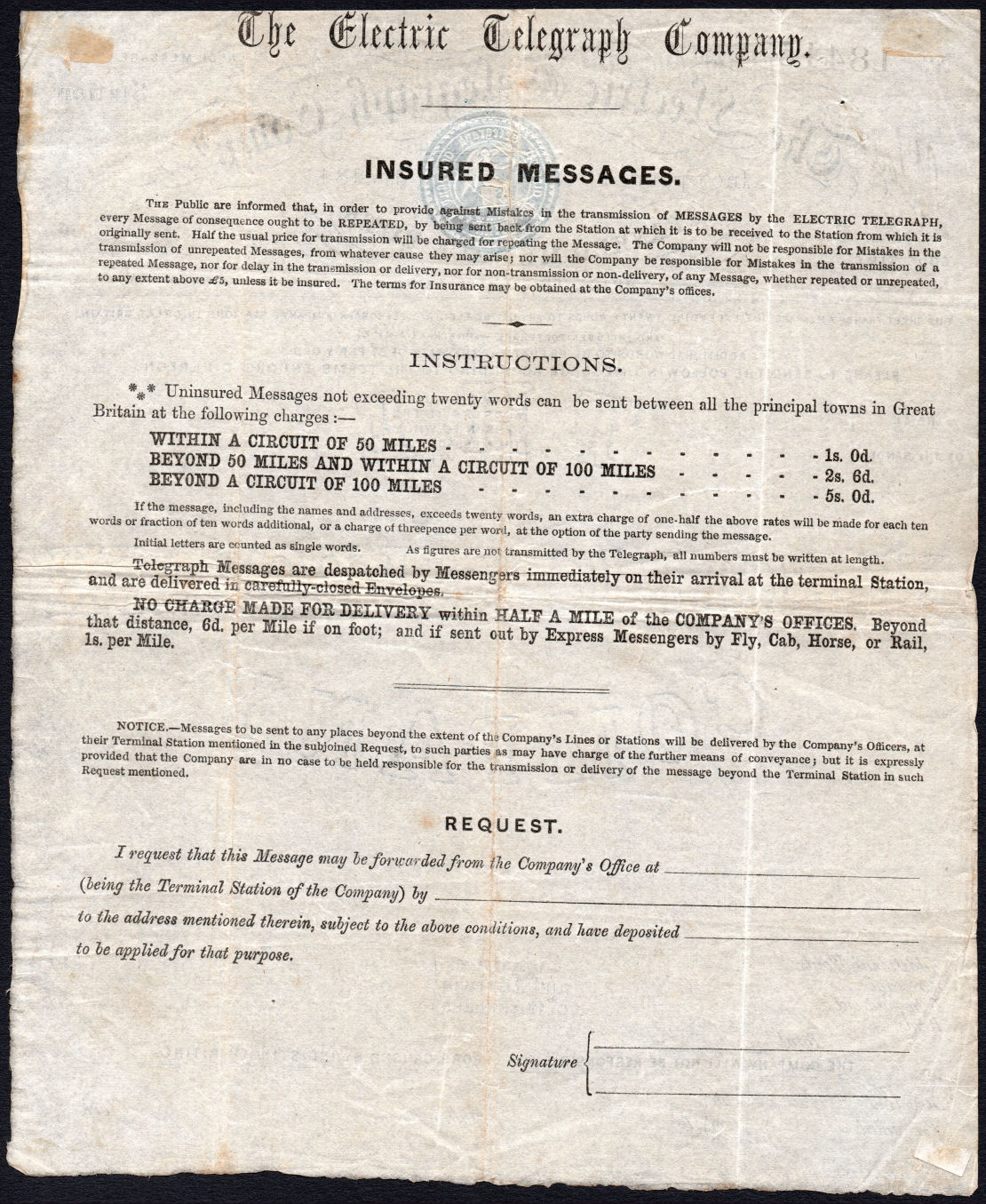
The back of some of the delivery forms shown below have tariff information, but these items are specifically intended
to provide information about policies and tariffs.
June, 1857 - 4 pages courtesy of Edward Coombes.
Page 1, overview signed by the Secretary, J. S. Fourdrinier.
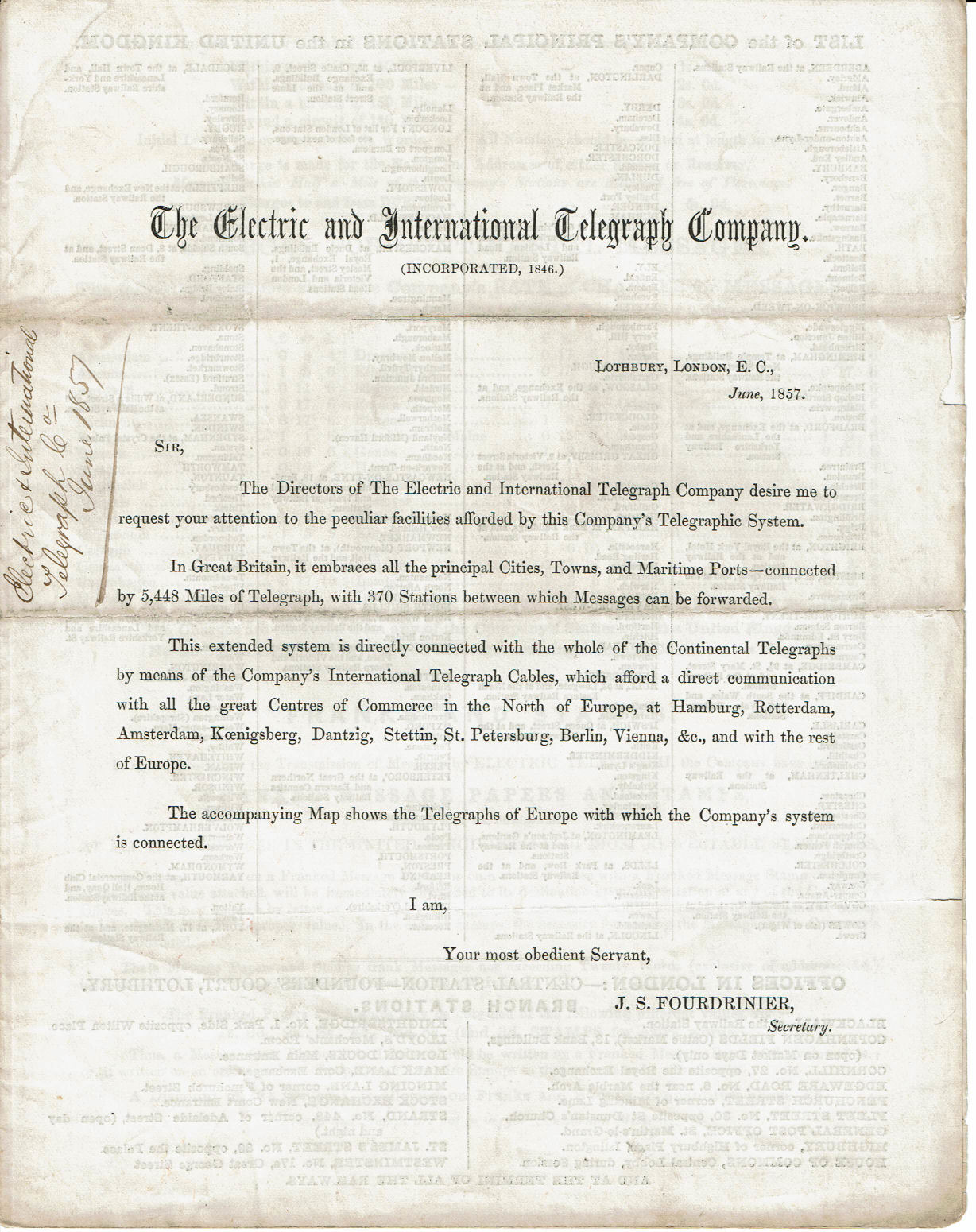
Page 2, with a list of principal stations.
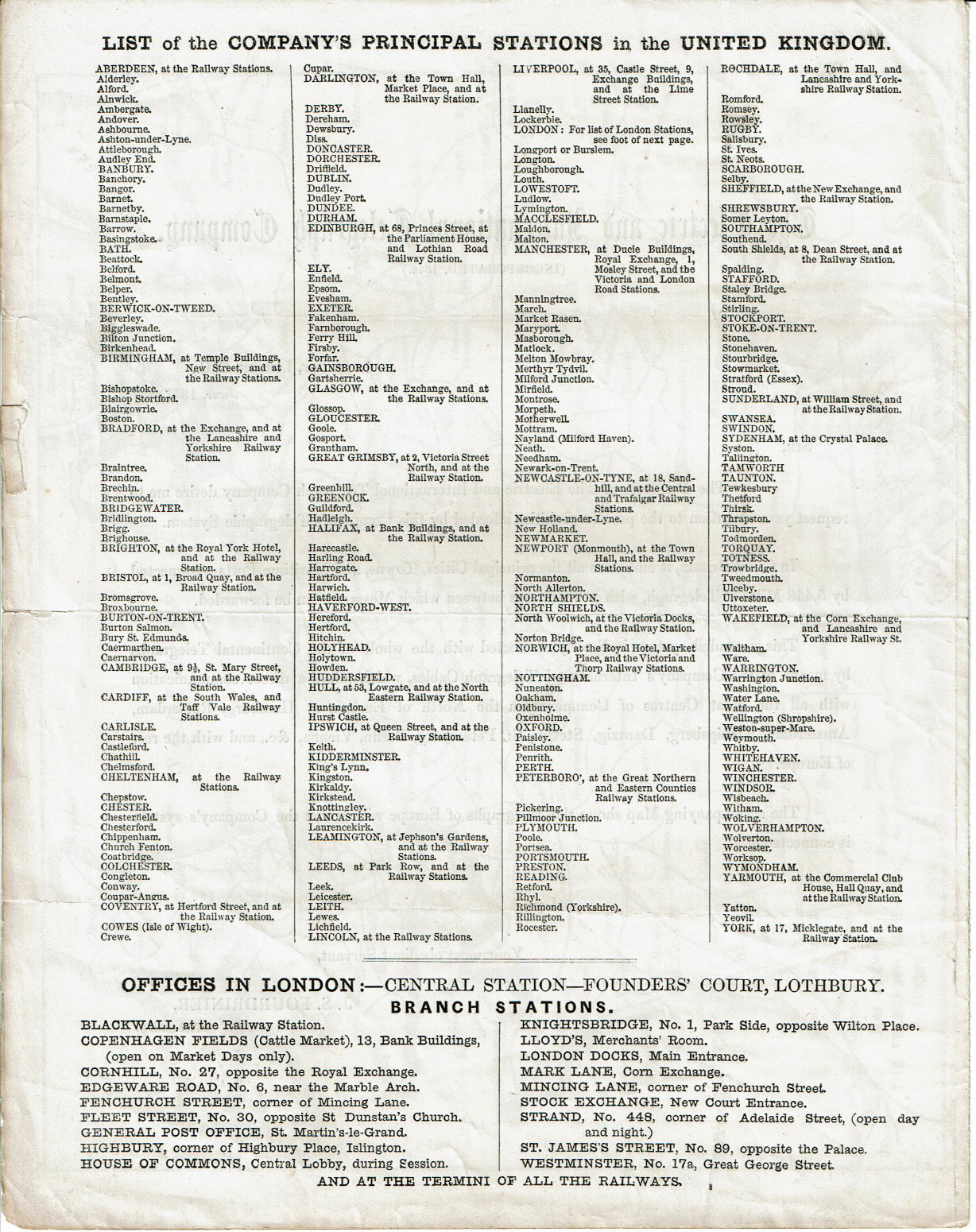
Page 3, with a list of charges and available Franked Message Papers and Stamps, as well as an available discount of 12½% above £5.
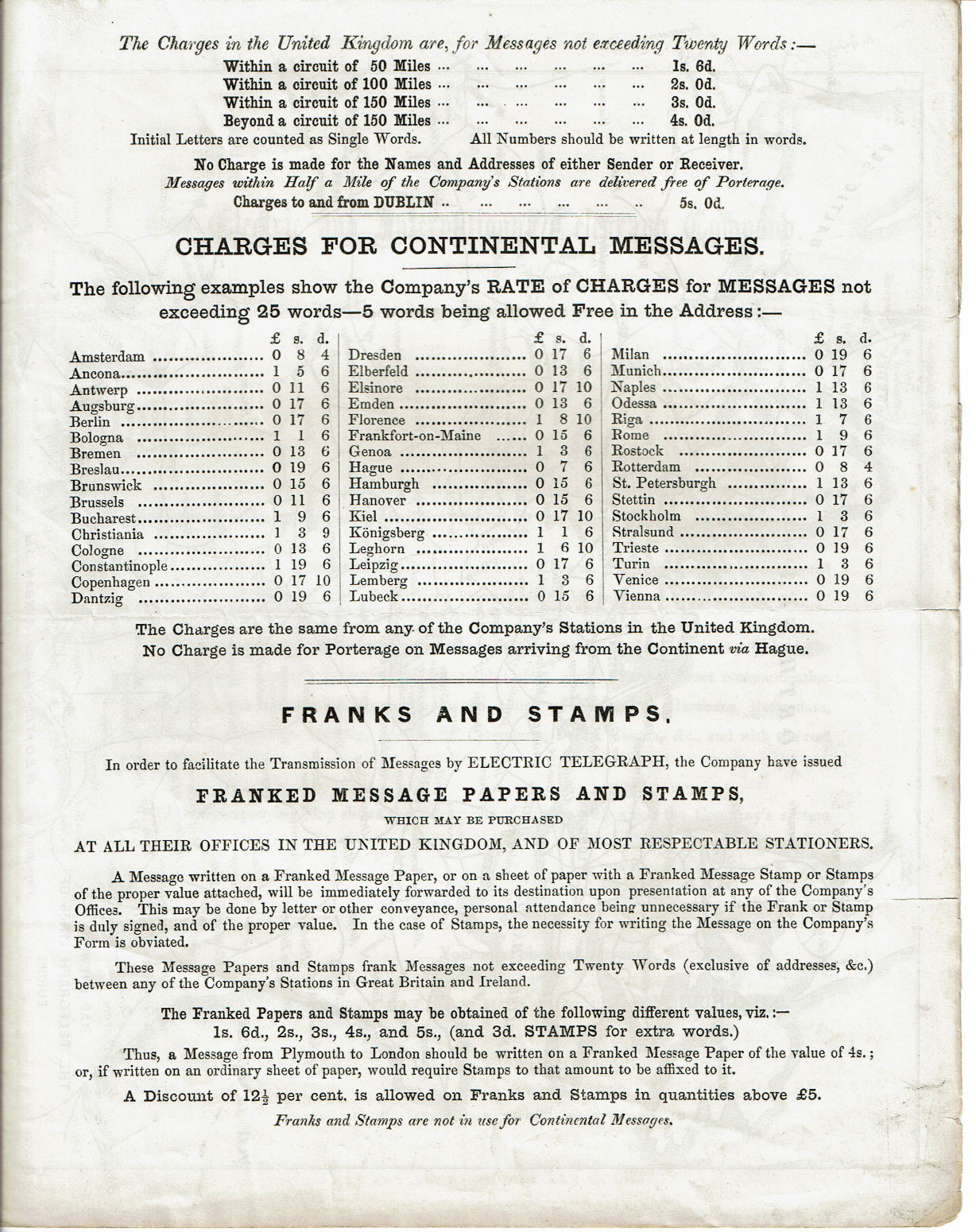
Page 4, with a map of the telegraph network in the UK and Europe.
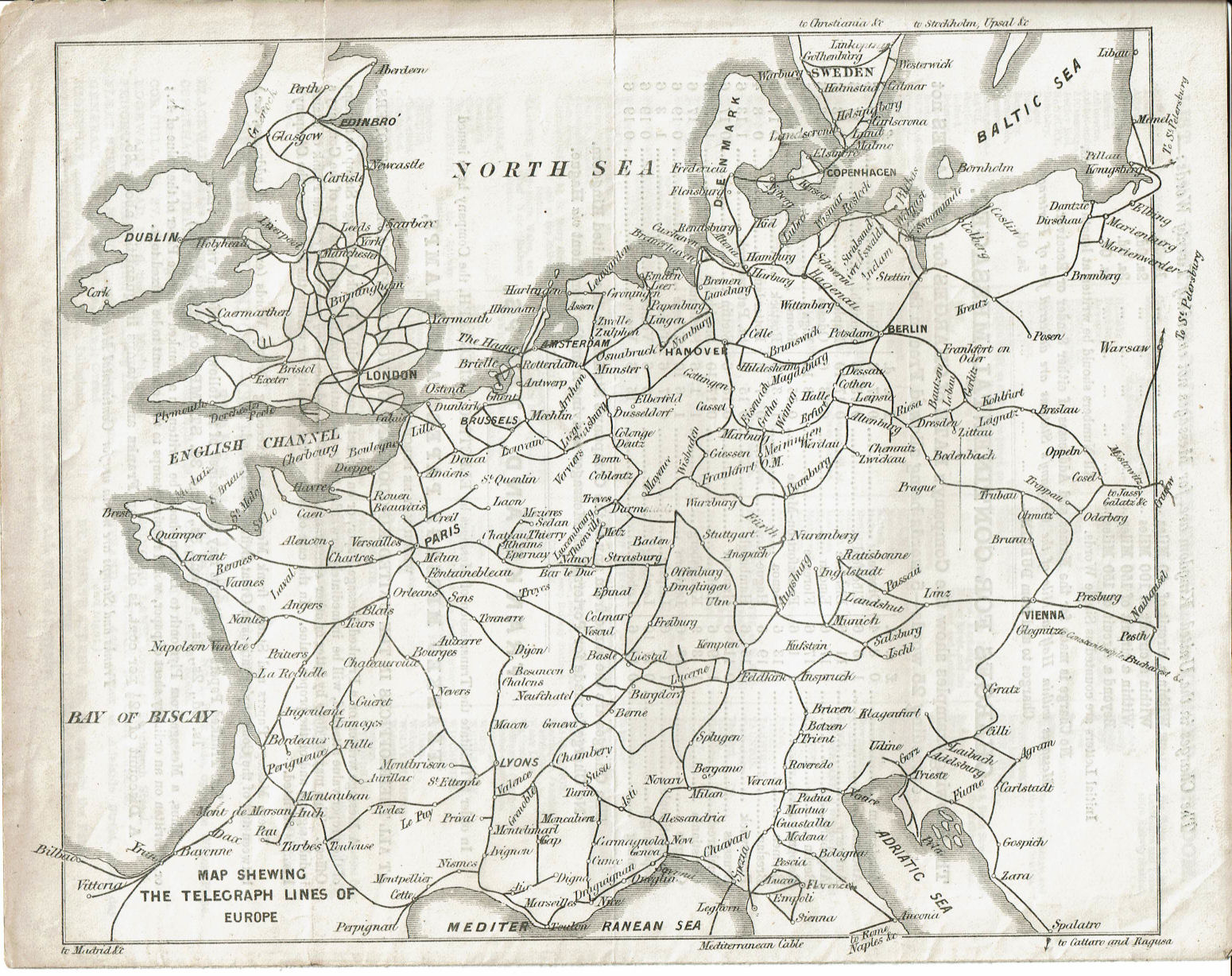
This map has been turned sideways.
July, 1865 - General Revision of Tariff, courtesy of Edward Coombes.
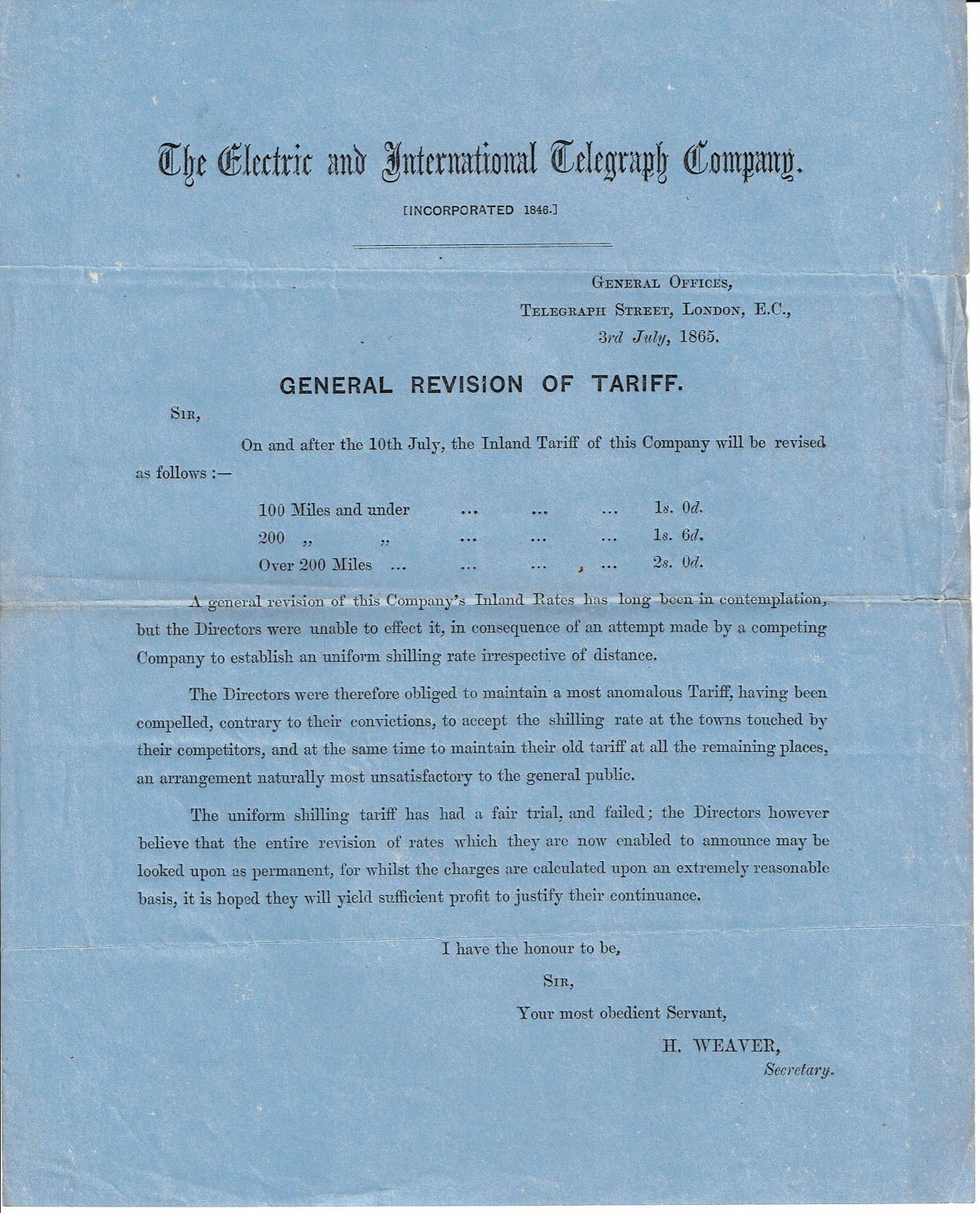
The competing Company referred to was the United Kingdom Electric Telegraph Co. Ltd. (UKET)
Last updated 21st. October 2023
©Copyright Steve Panting 2012/13/14/15/16/17/18/19/20/21/22/23 except where stated.
Permission is hereby granted to copy material for which the copyright is owned by myself, on condition that any data is not altered and this website is given credit.